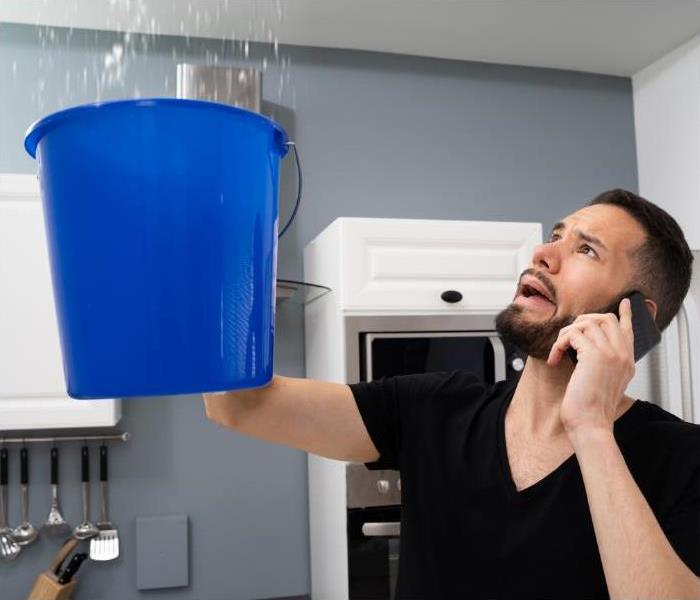Archived Blog Posts
How To Create a Fire Contingency Plan for Your Business
1/26/2022 (Permalink)
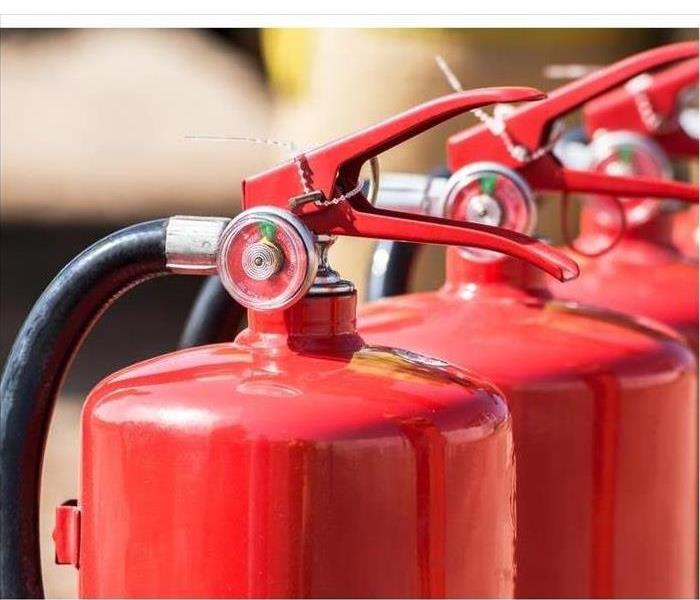 You should also have plenty of emergency supplies on-hand, including fire extinguishers.
You should also have plenty of emergency supplies on-hand, including fire extinguishers.
How to Make a Fire-Response Plan for Your Company
Every business in Rockvale, TN, needs to have a contingency plan in place in case an emergency breaks out. A fire can be caused from a number of sources, from electrical appliances to natural events. Before this happens, if it ever does, you should develop an evacuation plan that you review with your employees regularly. That way everyone knows what to do, so panic and confusion can be minimized.
1. Develop a Warning System to Protect Employees
The safety of your employees is of the utmost importance. You should develop a method to contact everyone in the building in case a fire ever breaks out. You should have fire alarms throughout the building, especially if you operate out of a particularly large property. You should also have plenty of emergency supplies on-hand, including fire extinguishers and a first aid kit.
2. Review Insurance Policies
Your contingency plan should also include all information relevant to your insurance policy. This includes information related to whether your policy covers fires at all and how much you stand to receive in reimbursement. If you have not spoken with your insurance agent for a while, then you need to speak with him or her to make sure you are covered for everything. It will help your business get back on its feet more quickly following an emergency.
3. Practice This Plan With Employees
It is a good idea to have practice evacuation drills with your employees so that people know how to respond to a fire. It is also a good idea to hold educational seminars to teach people basic fire safety methods. For example, it is recommended to hold a class teaching people how to properly use a fire extinguisher.
When you create a contingency plan, you hope you will never have to use it. However, it is always preferable to be safe rather than sorry.
3 Facts About Mold
1/26/2022 (Permalink)
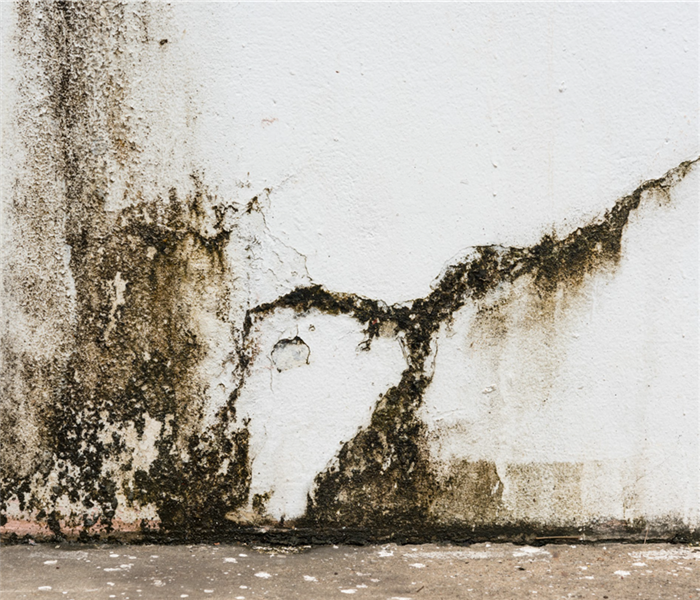 Black mold can grow just about anywhere.
Black mold can grow just about anywhere.
Black mold is the boogeyman of many a homeowner. We know it’s unpleasant to look at, but just how much do you know about the real threat mold poses in your Lascassas, TN, home? Read up on these surprising facts about mold to get a real handle on this household menace.
What is Mold Anyway?
Found throughout our environment, mold is a fungus comprised of small organisms. It thrives in moist, dark place, replicating via lightweight spores that are easily dispersed through the air. In homes, mold tends to thrive in:
- Basements
- Crawl spaces
- Bathrooms
- Under sink areas
Mold Isn’t Just Black
While the dark kind is most sinister, mold can come in orange, green, purple and even pink or white. This all depends on the organisms making up the mold and that plays a big part in what you do to clean it up. Whatever the color, mold is not something you should ignore in your home.
Mold Is Not Mildew
While the terms mold and mildew are often used together, these are two different things. They’re both fungus. However, while mildew only grows on surfaces, mold has roots that can take hold where the eye can’t see. This is one of the top reasons that it’s so hard to get rid of it - the leftover roots mean it can re-establish itself easily.
You Can’t Get Rid of All Mold Spores
Despite advances in mold cleanup, there’s no true, practical way to eradicate all mold spores in an indoor environment. They’re too light and too numerous. Instead, the answer to preventing black mold growth is controlling moisture. That means staying on top of leaks and drips, cleaning wet materials and preventing condensation.
Black mold can grow just about anywhere, feeding on wood, paper and even carpet in your home. If you’re tired of fighting the fungus, connect with a mold remediation expert to explore your options.
What You Need To Know About Residential Flood Cleanup
1/12/2022 (Permalink)
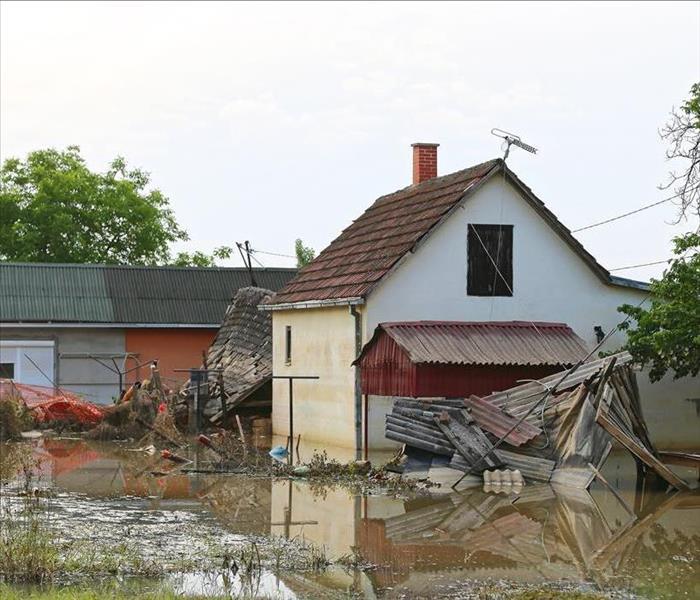 Flood damage in Eagleville, TN
Flood damage in Eagleville, TN
Residential Flood Cleanup
Few things are more tragic than having a home sustain damage during intense storms. After all, not only does your home represent your most significant financial investment, but it also is full of memories, personal keepsakes and valuables. You may not realize, however, that not all flooding is the same. Depending on the type of water damage you have, you must take different steps to restore your Eagleville, TN, home.
Broken Pipes Usually Cause Category One Damage
Unless you are away from your home when a pipe bursts, you are apt to notice this flood damage quickly. While the effects of destroyed plumbing systems can be bad, they are often not as severe as storm-related problems. This type of issue typically includes damage to the following:
- Drywall
- Carpeting
- Furniture
- Personal belongings
Restoration experts usually consider this sort of flooding to be low-level. Cleanup after these floods is often quicker and less invasive than for storm-caused damage.
Storms Often Cause Category Three Damage
When a hurricane, major thunderstorm or other severe weather rolls into town, your home may sustain considerable damage. Experts often assign this damage a category three rating. At this level, water often infiltrates parts of your home that you may not think about. Flood water may affect your basement, crawl space, carpeting, foundation and walls.
Restoration Experts Restore Value, Comfort and Appearance
While high waters can be unbelievably destructive, you may not have to completely abandon your home. On the contrary, restoration specialists usually have the knowledge and equipment necessary to return your home to its pre-flood condition. This first step to regaining your house’s value, comfort and appearance is to schedule an assessment from an emergency restoration service. Note, though, that timing is important. Waiting to start repairs can cause damage to worsen.
While flooding can be heartbreaking, you don’t have to walk away from your treasured home. By understanding the difference between pipe breaks and severe weather, you can best address the situation.
Altenatives to Traditional Candles
12/31/2021 (Permalink)
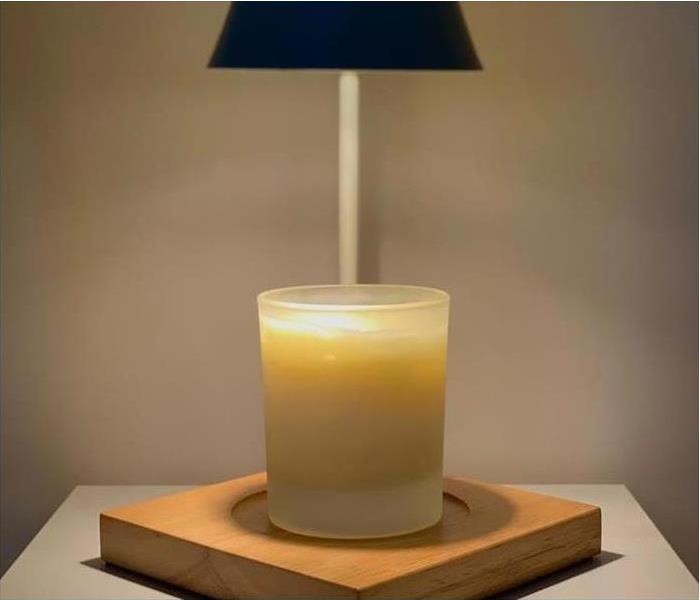 If you prefer the scent of a real wax candle, a candle warmer may be an excellent choice.
If you prefer the scent of a real wax candle, a candle warmer may be an excellent choice.
Consider Some Of These Trendy Ideas
If you want to try something in place of a traditional wax-burning candle, there are many new and exciting candle alternatives. Since traditional candles use an open flame, they pose a risk of fire. They may not be the best option if you are not able to keep a close eye on them, or if you have pets or small children that could knock them over. If you are looking for a safer way to create the same ambiance, consider some of these trendy ideas:
1. Candle Warmer If you prefer the scent of a real wax candle, a candle warmer may be an excellent choice. There are two types of warmers that work with candles in glass containers. Some warm up the base of the candle, while others use a hot lamp above the candle. Either way, the wax heats up and begins to melt, releasing an aroma in the same way a lit candle does. With these flameless candle alternatives, you get to use a real candle without the wick.
2. Scented LED Candle
These battery-operated candles light up. Some flicker like the real thing, only without the risk of causing a candle fire. If you choose one with real, scented wax on the outside, they may keep your home smelling fresh even when they are not lit. Some of these come with a remote and can cycle through a variety of colors.
3. Flameless Luminary This unique device consists of a battery-operated base with a light. Reminiscent of a Christmas luminaria, a decorative shade fits into the base and lights up in the pattern displayed on the outside. They are offered in a variety of colors, designs, and scents to match just about any decor.
With so many candle alternatives on the market, you do not need to risk leaving a burning candle unattended. However, if you do experience a candle fire in Christiana, TN, a professional fire restoration company can help restore your home to normal.
How Does Water Damage Result in Secondary Damage?
12/28/2021 (Permalink)
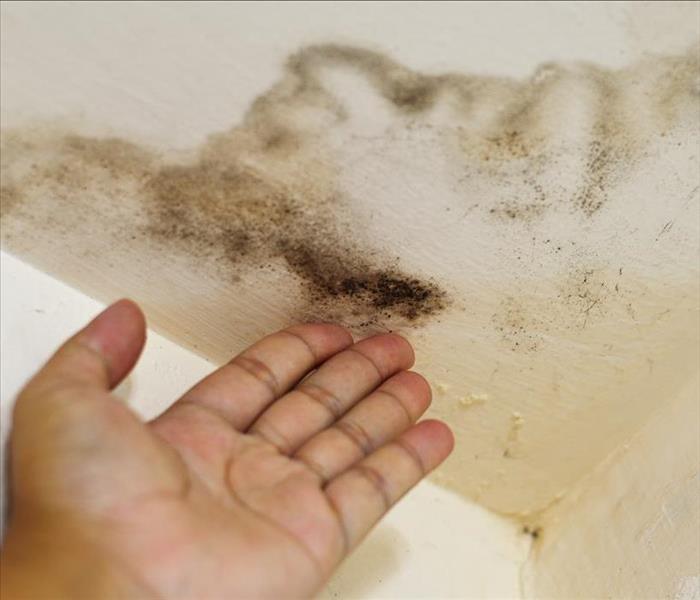 Water damage leads to mold growth in a home in La Vergne, TN.
Water damage leads to mold growth in a home in La Vergne, TN.
How To Prevent Secondary Damage
Water damage creates conditions that may lead to other types of damage. If timely measures are not taken to mitigate primary damage, additional damage is likely to result. Black mold is one possible consequence of water damage. Find out about how to prevent or mitigate three of the most common types of secondary damage.
Corrosion
Corrosion is a chemical reaction caused by dissolved gases and minerals found in most water. This type of damage:
- Affects metal components
- May cause electronics to short-circuit
- Can sometimes be cleaned
Corroded pipes or studs should be replaced. Restoration experts can recommend whether appliances or electrical devices that have sustained water damage can be restored or will need to be replaced. Corrosion may increase the risk of an electrical fire.
Mold
Many types of fungi may grow in a residence that has suffered water damage. There are more than 100,000 different types of mold, including Stachybotrys or black mold. Mold will thrive in areas that have:
- High humidity
- Food sources
- Poor ventilation
Some of the most common sources of nutriment for fungi include dirt, dust, and cellulose. The latter is a plant fiber found in building materials such as drywall, insulation, and wood.
Rot
Rot affects wooden building materials and contents. Depending on the severity of water damage, it may be possible to restore wood. Otherwise, it will be necessary to tear out and replaced damaged wood. Prevent rot by:
- Removing standing water
- Lowering humidity levels
- Sealing wood
These measures can help to reduce the likelihood of rot. Consult with restoration experts regarding the best methods for dealing with water-damaged wood.
These are only three of the most common types of secondary damage that result from water damage. The best way to lower the risk of electrical issues, structural damage, black mold, or ruined contents is to hire cleanup and restoration professionals in La Vergne, TN.
5 Steps for Drying Out a Water-Damaged Building
12/23/2021 (Permalink)
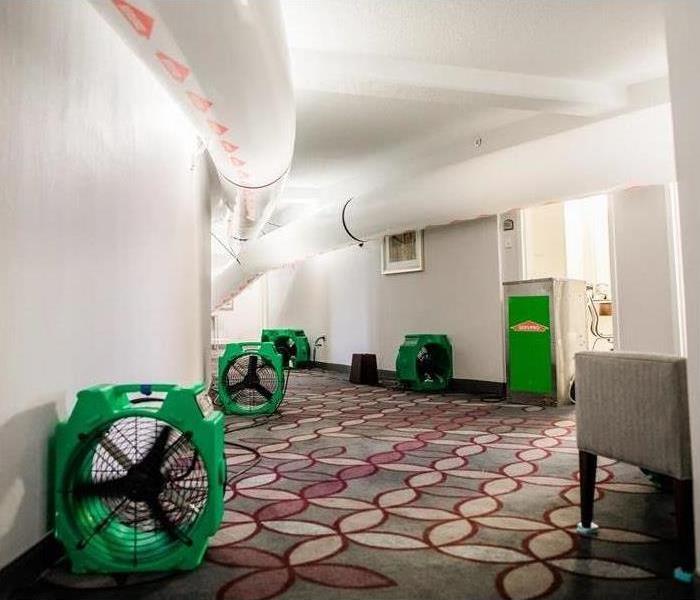 Commercial drying in Smyrna, TN.
Commercial drying in Smyrna, TN.
Water Damage Tips
When it comes to water damage, nothing is more important than acting quickly and calmly. These five practical water damage tips can help protect your belongings and commercial property in Smyrna, TN, from damage, or hold you over until water damage restoration specialists arrive.
1. Document All Damage
Immediately get photographic evidence of all the damage throughout the building. Try to identify the source of the leak, such as a pipe burst. Whatever the cause, documentation can save you time and stress when negotiating coverage with your insurance company.
2. Circulate Air
Of these damage tips, the most time-sensitive may be the use of air circulation to stave off further damage or warping. Buy or rent high-powered industrial fans to powerfully blow air. Open closet or cupboard doors to provide airflow. Depending on the humidity outside, crack open windows and vents. Large industrial dehumidifiers are also recommended to remove moisture from the air.
3. Remove Wet Items and Water
Remove wet flooring, furniture and other fixtures, as these only add to the moisture level. Keep in mind that household vacuums generally aren’t designed for water. Use an industrial wet/dry vacuum to absorb lingering water or mud.
4. Sanitize
Since the floodwater could contain waste and sewage, it should be cleaned up as soon as possible. Use warm, fresh, soapy water to clean floors, walls, or any other fixtures that have touched standing water. Don’t neglect ductwork; sanitize any ducts that were filled with water. These cleaning tips can help ensure that surfaces are safe for use.
5. Absorb Remaining Moisture
While fans and dehumidifiers are circulating and drying the air, you can tackle remaining moisture with desiccants, which are tubs of absorbent silica gel, clay or calcium oxide. Desiccants come in an array of sizes; visit your local supermarket or hardware store to find the size and formulation that’s right for you.
Discovering flooding or a pipe burst on your property can be overwhelming. By thinking quickly, staying calm and following these water damage tips, you’re sure to be standing on dry ground in no time!
Christmas Tree Fire Prevention
12/13/2021 (Permalink)
 Christmas Tree Fire Prevention
Christmas Tree Fire Prevention
Christmas is here in Murfreesboro, TN and fully loaded with the wonderful sights, sounds, and aromas! Music fills the house with the melodic joys of years gone by and those to come. Traditionally, a Christmas tree is the centerpiece of the family’s holiday. The tree is colorful and adorned with memories and beauty that we wait all year to see. If your family purchases live trees, the fragrance of Christmas fills the room with holiday cheer. The gifts underneath say that family is the real present of the season. SERVPRO of Rutherford County celebrates that treasure with you, because we believe that family is everything!
The Fire Damage Threat
The National Fire Prevention Association (nfpa.org) states that Christmas trees are the cause of an average of 160 house fires per year. The trees and needles are rich with highly flammable oils that can combust easily. Couple that dynamic with the oxygen in the large surface area, and porous structure of the tree, and you have a beautiful natural threat to your home without the proper caution and care. Additionally, short circuits in cheaply made Christmas lights are capable of igniting a fire that can quickly get out of control and cause real fire damage to your home and family. Even LED lights can get hot enough to catch fire.
Christmas Tree Safety Measures to Prevent Fire
If you enjoy live Christmas trees, make sure to take the appropriate safety measures to limit the possibilities of home fire damage this season. Keep your tree appropriately watered as the dryer the condition, the more flammable. Purchase quality lights and make sure that they are safely connected to each other and the electrical source. Install trees away from wood burning fireplaces, candles, heaters, and stoves. Also, keep your trees as far away as possible from hent vents. Turn off the lights when you sleep or are away from home. Finally, keep a fire extinguisher in the rooms where your trees are displayed.
Rock Around that Tannenbaum
At SERVPRO of Rutherford County, we hope your season is truly joyous and peaceful. In the hustle and bustle of the season, remember to be present and fully take in every sweet moment. As you enjoy your family and friends, rest in the fact that you took every precaution to protect what is most important to you this holiday season! We wish all our valued SERVPRO of Rutherford County customers and friends a Merry Christmas and Happy New Year!
Fire Restoration vs. Rebuilding? What Should You Do?
11/30/2021 (Permalink)
 Fire damage in a local home
Fire damage in a local home
Fire Restoration vs. Rebuilding?
Fire can wreak tremendous havoc on our homes or businesses. In the unfortunate event it occurs, what matters most is what you do as the affected party.
Getting your life back together should be your major concern.
After a fire, be sure to take the following measures:
- Take photos and videos of the damage for insurance purposes.
- Examine the stability of the house and whether it is safe to salvage your remaining items.
- Countercheck for electrical hazards such as exposed wires. If there are, seek professional assistance.
- Limit your activities in the house to areas that are safe.
A typical fire disaster will also involve water, soot, and smoke damage. The damages caused can be disorienting and truly upsetting. You might even decide to bring everything down and rebuild afresh.
But with a professional restoration company like SERVPRO, they will do everything they can to restore your home before the fire.
Fire Restoration vs. Rebuilding
Restoration is far more affordable than rebuilding. At SERVPRO, we will restore your home and all the damaged items. You even won’t know they were damaged.
Your family will be able to resettle back into their warm and cozy home in no time.
When SERVPRO arrives at your home, we will:
- Inspect and assess the damage of the fire.
- If water was used by the fire department to put off the fire, we will drain it completely.
- Repair the damaged structures of the house.
- Smoke and soot repair.
- General cleaning and sanitizing.
- Restore damaged items.
For Fire Restoration in Murfreesboro, SERVPRO is Here to Help
Fire restoration can be a daunting process. But you cannot do it alone. You need help – professional help!
SERVPRO is equipped with state-of-the-art restoration equipment and has trained professionals who will ensure that the job is done timely and perfectly.
It doesn’t matter the day or time – we are always available to help. Your satisfaction is our number one priority.
Will my Insurance Cover Water Damage? Answers to Important Water Damage Questions
11/10/2021 (Permalink)
A lot of people have this question after an unexpected plumbing incident or water backup in Murfreesboro, TN. No one wants to have a pipe burst in their home or experience a sewage backup that ruins their day. Because these things usually happen unexpectedly, it’s a great idea to be prepared in advance to minimize damages. That’s why it’s important to be well-informed so that in the case of an emergency, you can respond knowledgeably to a situation.
In this article, we’ll go over some of the most common questions about whether or not your insurance will cover the costs of repairing water damage at your home or business, as well as how to best prepare in advance for this situation.
We also offer a free Emergency Response Plan to further protect your business in the case of an emergency.
Will my Insurance Cover Water Damage?
When you get unexpected water damage in your home, your insurance provider will likely cover it. The question is how much they are going to pay for and what do you have to be prepared for when it comes time to file a claim.
Homeowners insurance is meant to cover you in the case of unexpected water damage from events like a pipe burst, toilet overflow, damaged water heater, or other water damage events.
While lack of maintenance can affect your coverage in the case of an emergency, this is not a common issue and is easy to resolve by ensuring you check your main water systems at least once per year. Examples to check could be your water heater, water meter, dishwasher, fridge, HVAC drain, and/or leaky faucets, drains, or showerheads. And if your home has them, your septic tank and water softener would also be important maintenance candidates.
Is Water Damage an Emergency?
Yes, when there is a great enough flow of water from a clean or contaminated source, water damage can be one of the most common emergencies you may face in your home. Whether the water comes from heavy rainfall with wind, a sudden flood, roof damage, burst pipes or appliance lines, or even a sewage backup, a water damage problem can become a serious threat to your property's safety and value. Not only is the water itself a property damaging issue, but if allowed to remain for more than 24-48 hours, mold can begin to take hold.
If you need immediate assistance, our team of trained technicians at SERVPRO of Rutherford County, we’ll make sure to leave your home "Like it never even happened."
Call us today at (615) 849-9794
You’ll Find Mold in These Six Surprising Places
10/27/2021 (Permalink)
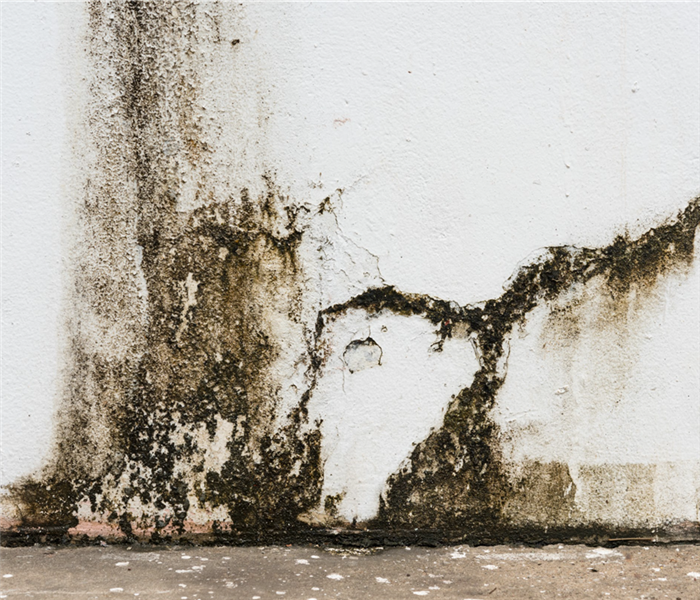 Mold damage in a Milton, TN home.
Mold damage in a Milton, TN home.
Six Places Where You Might Find Mold
You may think you’ve ferreted out all the mold in your Milton, TN residence, but the odds are you don’t even know all the places to start looking for mold growth in your home. Mold isn’t just a surface issue; did you know if you have mold on your walls, it’s likely you also have mold behind your walls as well? And not just there. Let’s take a look at six places where you might find mold, as long as you know where to look.
1. Behind your walls. Moldy drywall can leave your entire house smelling musty and can let mold spread unchecked and out of sight.
2. Underneath your carpeting. If moisture gets trapped under your carpet, it’s a perfect space for mold to grow – enclosed, dark, with pockets of wetness for it to feed on. It will also feed on organic matter such as carpet glue and carpet fiber.
3. Inside the wood of your floors. Because mold feeds on organic matter, older wood floors can be ripe for this. Mold on wood happens when wood gets old and begins to soften with frequent water absorption.
4. Under sinks. Drips and leaks can slowly accumulate under sinks until you don’t even think to check in this out-of-the-way place when mold growth can be slow – but once it starts, it’s hard to get rid of.
5. Underneath laminate flooring. Laminate flooring has many of the same problems as carpeting, and once moisture is trapped underneath, mold will happily devour the glue on the laminate.
6. Inside your appliances. Refrigerators and air conditioners are the worst culprits when they can often accumulate condensation that feeds mold. Any appliance that attracts condensation can grow mold, though.
Sometimes, you may not be able to identify mold growth in small spaces or have the tools to check for mold underneath flooring. That’s when a mold remediation specialist can come in handy – to help you get your mold problem under control.
When Security Fencing May Be Necessary After a Fire
10/27/2021 (Permalink)
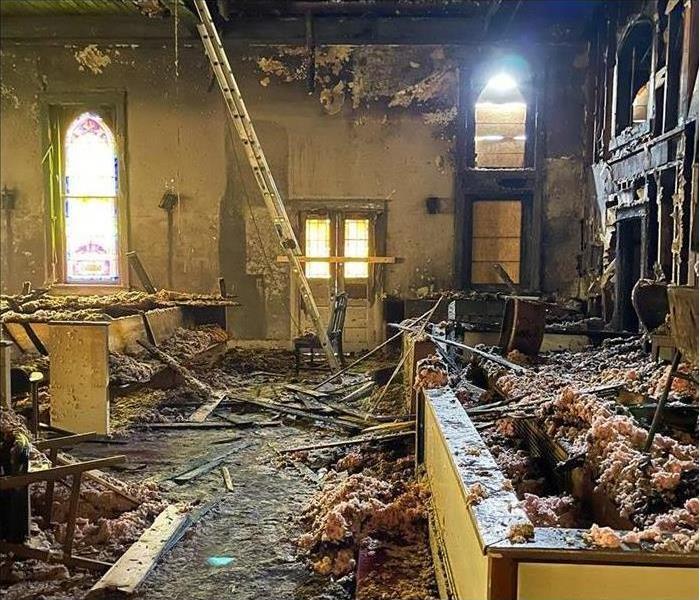 Fire damage to a commercial property in Murfreesboro, TN.
Fire damage to a commercial property in Murfreesboro, TN.
When Security Fencing May Be Required Following a Fire
If your building was recently devastated by a fire, you may be asked to vacate the premises until the structure has been fully remediated. While that is the safe thing to do, you may be concerned about the safety of your property while it’s uninhabited. After all, it is not uncommon for damaged or abandoned buildings to become victims of vandalism and theft, and vacancy may attract vagabonds. To keep your property safe, both your Murfreesboro, TN, fire remediation team and insurance adjuster may suggest a security fence. Before you install a fence, however, there are some things you should do beforehand:
- Call in all service providers, such as plumbers, electricians and gas suppliers, to inspect your building's internal systems and ensure that all are in safe, working condition.
- Turn off all utilities.
- Invest in shutters, storm doors, commercial locks and other means of keeping vandals out.
- Make a list of damaged and destroyed items.
- Discuss your options with your insurance provider.
Why You Should Install a Security Border
You never know how long a fire will keep you out of your building. Depending on the extent of the damage, and what kind of damage was done to the internal workings of your building, you may be out of your building for just a few weeks or a few months. If your Murfreesboro, TN, fire restoration team informs you that remediation efforts will take months, you may want to install a security fence in the meantime. Not only will a fence keep the bad guys out, but it can also give you peace of mind and reduce your insurance costs. Insurance companies like to see property owners take initiative to protect their properties, and are likely to give you a discount for doing so. On the flip side, if you don't invest in a fence, you may be viewed as a risk, and you may see a bump in your monthly premium.
Don't risk additional damage to your building by failing to invest in adequate security. Talk to your insurance company about security fence options today.
The Business Continuity Plan: What Is It and Why Does It Matter
9/26/2021 (Permalink)
Both small and large businesses can easily overlook a business continuity plan; however, it is often the most valuable tool in your arsenal when a disaster happens and threatens continued operation.
1. What Is It?
A business continuity plan (BCP) is an emergency document that ensures a business can continue to function during any unforeseen events. The BCP will likely include contacts, emergency response procedures, checklists, and any change management procedures. While a business may not be able to operate out of a specific location physically, it is still necessary to manage assets and vital information.
2. Why Does It Matter?
While a company can seek assistance from restoration specialists in the Walterhill, TN, area, their facility may be out of commission for a lengthy period, depending on the severity of the emergency. A BCP provides a company with an emergency response plan that helps operations continue despite any difficulty.
3. Basic Things to Consider
A basic BCP should focus on the continuity of business, and this means that it should include any revisions to management procedures, any necessary contacts, any critical data, and steps that outline any expected actions to be taken by the manager in charge. Also, BCPs are fluid documents, meaning that it may be necessary to change and revise them from time to time.
4. Where to Find More Information
If you are looking to begin the process of developing your business’s BCP, then you may want to review the information at ready.gov. You will find information on every aspect of a BCP, from the business impact analysis, recovery strategies, plan development, and to the testing and exercise phase.
A business continuity plan may be one of the most valuable documents to your business, as it ensures that in instances of emergency and business interruption, your company can still find a way to operate and maintain continuity.
Flooded Basement: What's the Cause?
9/19/2021 (Permalink)
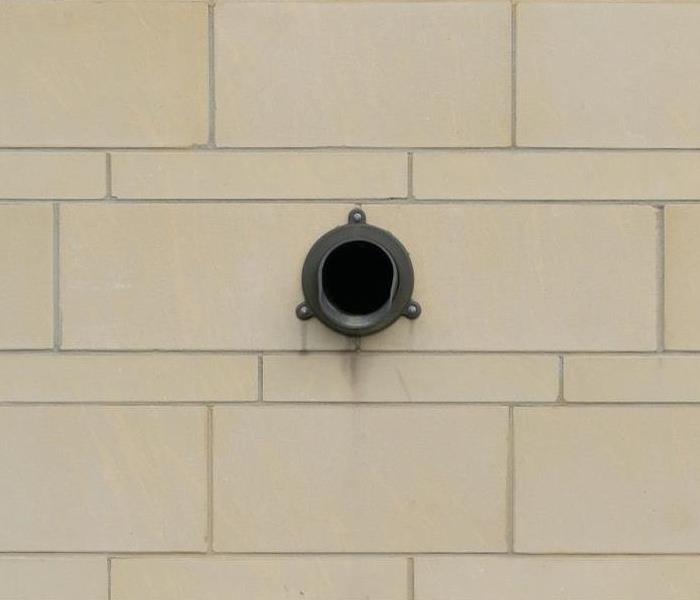 If you're dealing with a flooded basement, the best thing you can do is contact a flood restoration expert for cleanup assistance.
If you're dealing with a flooded basement, the best thing you can do is contact a flood restoration expert for cleanup assistance.
A flooded basement can cause a lot of stress and headache for the average homeowner, as most people store sentimental items, excess furniture, and stockpiled goods in this out-of-the-way area of the home. In addition to causing damage to stored items, unexpected water can destroy the walls, carpet, rugs, and other permanent fixtures.
Common Causes of Sewage Backup
Whether you're experiencing this problem for the first time or have dealt with a flood in the basement before, it's important to determine the cause to ensure that it doesn't happen again. Ask any Milton, TN, floor restoration expert, and he or she will tell you you’re your flooded basement likely occurred because of one of four reasons:
• Water from your home's surface somehow seeped through your foundation.
• Groundwater from outside saturated the soil to the point where it was forced to enter your home via hydrostatic pressure.
• Stormwater built up in the city's sewer system and backed up into your home.
• Your home's sewage line, the city's sewage line or both were clogged and the pressure caused a backup in your home.
Pinpointing the cause of the backup is key to finding a solution and implementing measures to prevent future sewage backups. A skilled plumber can help you determine why your system is backing up and what needs to be done to correct the issue.
Easy Fixes to a Sewage Backup
Not all plumbing issues require an expensive solution. If you're lucky, the fix will be something as simple and affordable as one of the following four solutions:
• Extend your downspouts farther away from your home.
• Redo the pavement around your home so that it slopes away from the foundation.
• Seal the pavement that buts up to your home to prevent water from leaking in through the cracks.
• Re-grade your landscaping so that water flows away from your home.
• Keep lawn irrigation away from your home.
If you're dealing with a flooded basement, the best thing you can do is contact a flood restoration expert for cleanup assistance. Afterward, schedule an appointment with a plumber to determine the root of the issue and fix it for good.
10 Facts About Mold
9/14/2021 (Permalink)
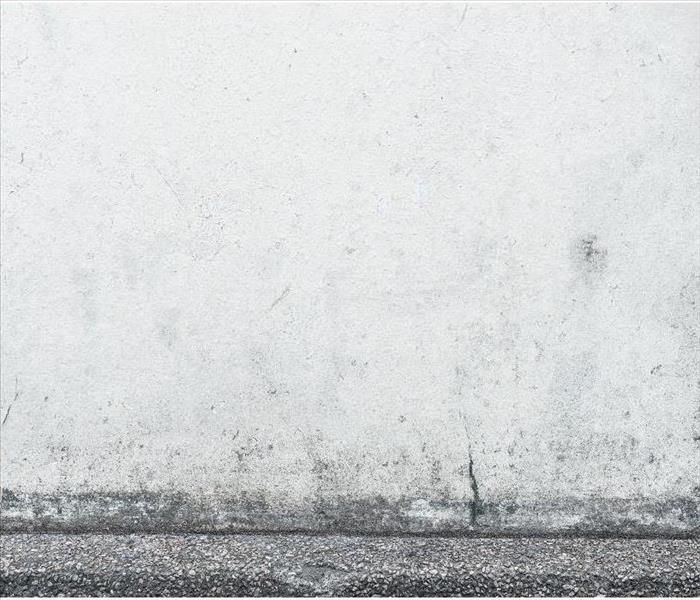 Whether the mold growth in your home is the result of water damage or humidity, knowing how to resolve the problem and prevent it is important.
Whether the mold growth in your home is the result of water damage or humidity, knowing how to resolve the problem and prevent it is important.
Many homeowners will experience mold damage at some point. If you think there is mold growth in your home in Blackman, TN, it may be helpful to understand a few facts about mold. There is a difference between mold being present and mold being a problem.
1. Mold is all around. Mold only becomes a problem when it is drawn to a surface to land and thrive on.
2. Mold likes moisture. Mold needs water to grow rapidly. Areas with high humidity often see more frequent mold growth.
3. Mold smells musty. One of the first signs that you have a mold problem is that you will smell a dank, stale odor.
4. Mildew is not mold. What most people think of as mildew in their bathroom is more likely a type of mold. Mildew mainly grows on plants, whereas mold tends to grow on surfaces.
5. Bleach doesn't kill mold. Because bleach is mostly water, it can actually increase mold growth. Rather than killing it, it merely turns it white.
6. Mold is airborne but doesn't stay that way. Mold travels indoors by hitching a ride on clothes, shoes, bags, and pets.
7. Mold is diverse. There are over 10,000 species of mold, and they come in a variety of colors and textures. Only a handful of species are common indoors.
8. Mold happens quickly. Mold can start to grow in as little as 24 hours after excess moisture has entered the environment.
9. Test kits aren't helpful. Because DIY test kits report the presence of mold rather than the excess of it, they aren't helpful in detecting a problem. A test by a certified industrial hygienist is necessary.
10. Mitigation is for the experts. While you may be able to take care of a small patch of mold in your home, large problems require professional mitigation so that they don't get bigger or return.
Whether the mold growth in your home is the result of water damage or humidity, knowing how to resolve the problem and prevent it is important. Armed with these facts, you are more likely to notice signs of mold.
What Homeowners Need To Know About Water Damage After Minor Flooding
8/23/2021 (Permalink)
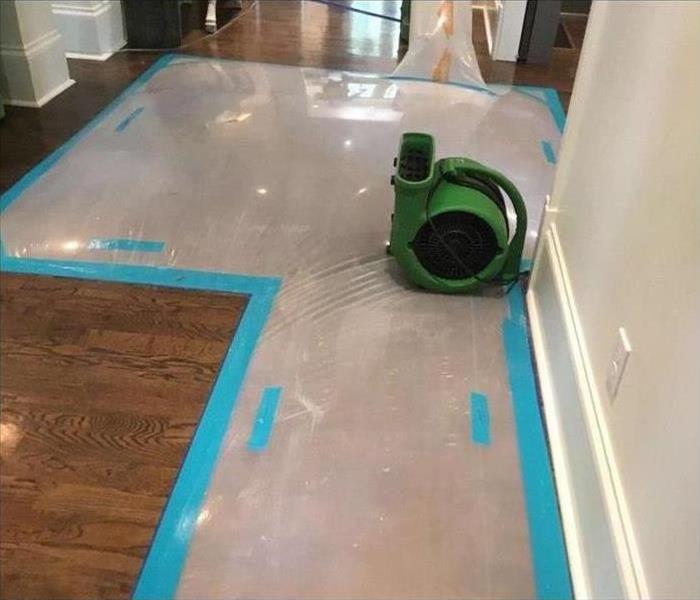 Residential water damage
Residential water damage
Water Damage After Minor Flooding
Water damage is easy to identify when flooding covers streets and submerges vehicles. When that same water pours into a home in Blackman, TN, and covers floors two feet deep, the resulting destruction is expected, and often immediately addressed. But what happens when clean water floods the floors an inch or two after a pipe burst? Homeowners may be unaware of the dangers small amounts of water can cause floor coverings, walls, and baseboards.
Potential Problems
A burst pipe, overflowing toilet, or broken water heater can all flood floors. Once the initial water
has been cleaned up, most homeowners know to look for, and quickly address, many common problems with a professional. Here are a few possibilities to consider:
• Ebbing water pressure – A possible rupture in a water line. This can range from a small, inconsistent leak at a connection to a continuous leak at a broken line.
• Discolored water or funny smell and taste – A possible rusty pipe or a broken pipe that allows foreign bodies into the water supply.
• Stains on walls – A possible water leak behind walls, or water seepage into wood or sheetrock by the flood waters.
Invisible Damages
Often after homeowners clean up a pipe burst caused flood, they look for the visible signs of water damage but are completely unaware of the hidden damages left behind. That is why it is usually expedient to contact a restoration team to evaluate the damage. The team can remove carpets and pads, check underflooring for damage, and set up dehumidifiers to speed the evaporation of remaining water. Most importantly, the restoration specialists can remove baseboards and ventilate the remaining water that is hidden behind the boards. This simple step can help thwart mold.
Effective Solutions
Dealing with the consequences of even a minor flood from a pipe burst in Blackman, TN, while the property is still wet can not only help mitigate the immediate damage, it can help prevent potential future problems. Property evaluation and decontamination can be time-sensitive matters.
How To Check a House for Mold
8/23/2021 (Permalink)
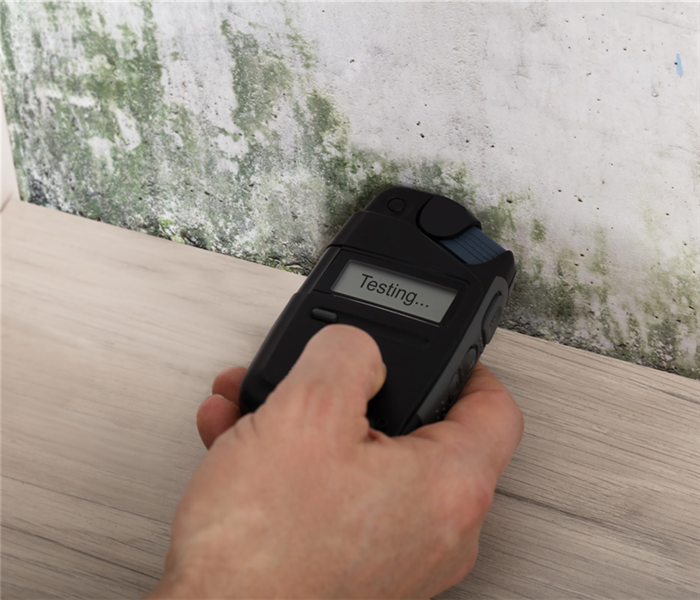 Mold testing
Mold testing
How to Examine a House for Mold
There are a number of situations in which you may want to check a house for mold growth. For example, if you’re thinking of buying a house in Milton, TN, or if you’ve experienced a significant water event in your own home. If a thorough visual inspection of the house, including the attic, closets, basement, or crawlspace, doesn’t turn up mold but you still suspect there may be a problem, you may want to call a certified indoor environmental specialist.
If the house has any of these issues, it may have a hidden mold problem:
- A musty or moldy smell
- Past flooding
- Leaks
- Humidity over 60 percent
What Is a Mold Test?
When you hire indoor environmental specialists, they will conduct a mold test. There are air tests, surface tests and bulk tests. A spore trap is a device with a sticky surface inside. When air passes through it, any mold spores in the air stick to the surface. When a dye is applied, it stains the mold spores so the tester can determine the number and types of mold spores present in the air. If your home has a higher spore count than the air outside, there’s a good chance you have hidden mold.
The surface test works in a similar way. An adhesive strip is applied to surfaces and then analyzed for mold spores. A bulk test actually removes suspect material from your home - for example, drywall damaged in a flood - and tests it for mold.
What Is a Moisture Assessment?
A qualified indoor environmental specialist in Milton, TN, can also perform a moisture assessment. Not only can this pinpoint the locations of hidden mold growth, but it can also locate the source of moisture problems that foster molds, like broken water pipes, leaking roofs, or areas of poor ventilation. These are carried out with moisture meters, infrared imaging and careful tracking of humidity, temperature and dew point.
If you suspect a mold problem but you can’t see one, hiring a professional to carry out a mold test and moisture assessment can give you the peace of mind you’re looking for.
Five Things To Know To Be Prepared for a Flood
8/8/2021 (Permalink)
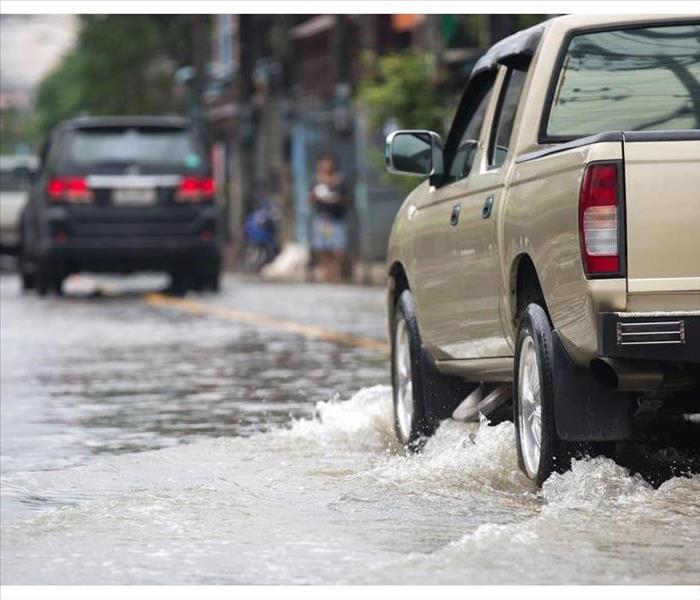 Never drive through flood waters.
Never drive through flood waters.
Five Things You Should Know to Prepare for a Flood
Are you prepared for a flood in Walterhill, TN? This preparation advice may not include conventional flood safety tips, but one of the biggest dangers in any emergency can be panic. With a few simple safety tips, you can mitigate that risk.
1. Know Your Home
Be sure you know what parts of your home may be vulnerable to flooding, such as a basement, and what you can do to mitigate the risk. Keep valuables on higher levels if possible, or make sure you have a place to move them when a storm is approaching.
2. Know the Risk
Is a flood likely in Walterhill, TN? Do some research to understand the likelihood of a flood in your area and what type of flooding to expect. Different types of floods may carry different risks for your home and family.
3. Know Where To Go
Check with your town or surrounding communities to find out where storm shelters are usually set up. Once you know the locations of the shelters, practice safe evacuation routes so you know how to get there. One of the most important flood safety tips is knowing how to travel during a flood, including never walking or driving through flood waters and avoiding bridges over swollen waterways.
4. Know What To Bring
Make a list of valuables, documents and other important items such as medicine that you would need to bring in the event of an evacuation. Store important items and documents you don’t plan to bring in a watertight container on an upper level if possible.
5. Know What To Do Next
Research proper cleanup techniques and safety precautions for when you are able to return to your home. Find the number of a remediation specialist to assist with proper cleanup, and contact the company as soon as possible.
By following these five flood safety tips, you should be able to stay calm and make the best decisions for your family and your property in an emergency. Proper preparation can go a long way toward reducing risk and easing recovery when disaster strikes.
How To Know If Your Facility Has Mold
7/26/2021 (Permalink)
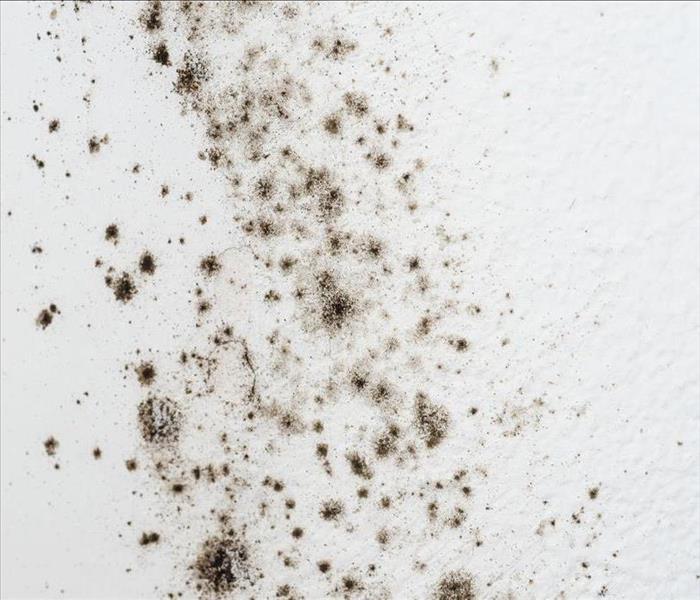 Mold damage in Lascassas, TN.
Mold damage in Lascassas, TN.
How to Tell If Your Building Is Moldy
No commercial building in Lascassas, TN, is completely immune from developing a mold problem. Mold can occur any time there is excess dampness or condensation inside a facility. If you’re unsure whether there is mold at your commercial property, an indoor environmental specialist can perform a mold test so you can try to catch it early.
First, here are a few questions to consider:
1. Has there been any recent water damage? Moisture is the primary source of mold, so whether it’s a leaky roof or the effects of flooding, any kind of water inside your commercial facility can lead to mold growth.
2. Are the air ducts cleaned regularly? HVAC and other ventilation systems are commonly known to carry mold, so it’s important to find out when they were last cleaned.
3. Is there a strong odor in the building? Sometimes a musty smell means there is mold present. If your employees report an unpleasant odor, it could be the presence of black mold, which is often smelled before it is seen.
Mold can hide in many places indoors, such as under carpet, inside walls and paneling, and in piping and insulation. It has also been found behind wallpaper, but it’s important to be cautious about investigating it without an indoor environmental specialist present; once exposed, mold spores can spread easily. It only takes two to three days for mold to grow indoors. If you do suspect a mold outbreak at your commercial facility, stay away from suspected areas until experts can come and perform the necessary tests.
If a mold breaks out but goes undetected for a long time, the more damage it can cause. That could disrupt your operations and impact you financially. If your building has suffered any water damage, watch for mold signs. The sooner it’s discovered, the sooner an indoor environmental specialist can come in to clean it up.
Brush Up Your Skill on Cleaning Your Grill
7/26/2021 (Permalink)
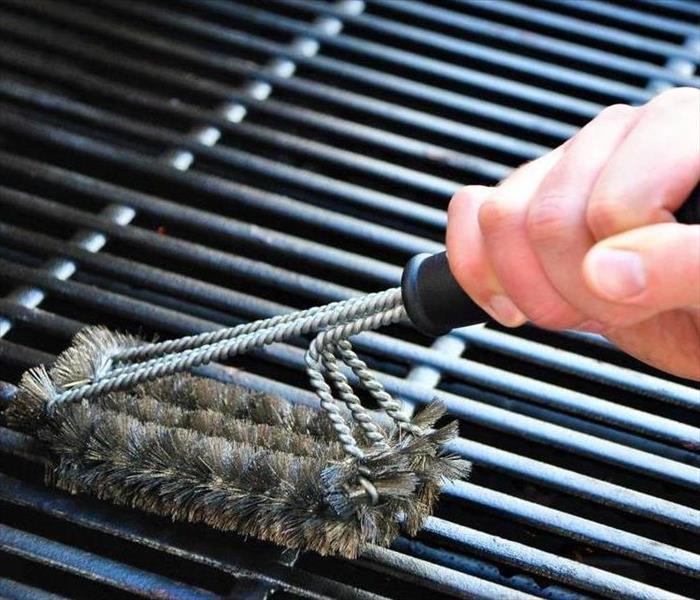 Your home’s safety is worth an occasional grill cleaning.
Your home’s safety is worth an occasional grill cleaning.
Steps For Grill Cleaning
With summer in Murfreesboro, TN it’s impossible to keep your mind off delicious grilled food. With use, the grill will build up residue. It needs proper maintenance to keep your cooking safe from fire and your food delicious with flavor. Knowing the steps for grill cleaning will protect your grill, food and home.
1. Gather the Necessary Cleanup Items
For this procedure, you will need gloves, a specialty grilling brush, a trash can, a bucket of hot, soapy water, paper towels and aluminum foil.
2. Prepare the Grill for Cleaning
All dials should be inspected to make sure they are off. If the grill is propane, the tank needs to be disconnected before grill cleaning. You should glove up before opening the grill.
Remove the grates and soak them in a bucket of soapy, hot water. After removing the grates, place aluminum foil over the exposed components for their protection.
3. Brush the Walls
Using the grill brush, scrub the walls of the grill’s interior. Once you finish scrubbing, wipe the walls with a moist paper towel. This step removes dangerous buildup that could cause a grease fire.
4. Drop the Drip Pan in With the Grate After Emptying
Remove the drip pan next. After it has been turned over and emptied into a trash can, put it in the bucket with the grates.
5. Finish Cleaning the Soaked Components
After removing all grates and the drip pan from the bucket, scrub them with the brush before rinsing them off with a hose.
6. Remove the Foil and Reassemble the Grill
The foil is no longer needed and should be removed. Now, use the grill brush to dust the grill elements lightly. Once you are done brushing, return the pan and grates to their original spots. The exterior can be wiped with stainless steel wipes or soapy water if a clean look is desired.
Your home’s safety is worth an occasional grill cleaning. In the event of a grill fire, the damage can be remedied by a professional fire restoration company. Regular grill maintenance, however, reduces the likelihood of a fire ruining your summer backyard gatherings.
The Right Way To Unclog a Pipe With a Snake Tool
6/28/2021 (Permalink)
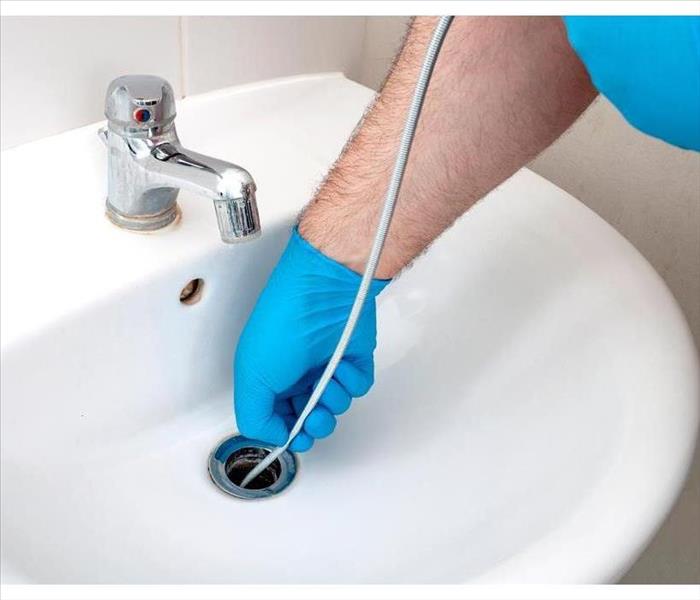 Unclog a pipe with a snake tool.
Unclog a pipe with a snake tool.
It’s hard to imagine anyone not dealing with a clogged drain at some point in his or her life. Whether it’s a kitchen sink, a toilet, a shower, or a drain in the laundry room, you’ve probably fussed with this issue at your Christiana, TN, home. You can always try cleaning the drain or trap, and plungers certainly can work. However, for your toughest jobs, a snake may be the way to go.
What It Does
A snake is a coiled, spiral tool you can use to unclog stopped drains. Normally, it’s about one-quarter of an inch thick and has a handle on the other end. It works differently than a plunger:
- You push the snake farther into the drain to meet the object causing the blockage.
- It breaks up the obstruction.
- It helps you pull out the obstruction.
- A snake is long and usually reaches far into the pipe.
- This device can help with a pipe break or a major clog.
Step One: Push It Into the Drain
Your first task is to take the snake by the handle and push the opposite end into the drain. At the same time, turn the handle. The auger will then start traveling deeper into the clogged drain.
Step Two: Keep Going
Some stopped drains have blockage far into the drain, so it’s important to continue pushing with high pressure and force. This will get your snake farther into the drain. If you continue to crank the handle, it should bend around the trap under the sink. You shouldn’t have much trouble at this point reaching the culprit.
Step Three: Rotate the Tool Until You Know You’ve Freed the Object
It may take some effort, but as you continue turning the snake, you should feel the object being released and moving freely in the pipe. You’ll either break up the object or pull it right out.
A clogged drain can be a pain to repair, but a snake could do the trick. You can also get in touch with a sewage cleanup specialist to give you a hand.
3 Surprising Things You Can Do To Reduce the Smell of Cigarette Smoke
6/28/2021 (Permalink)
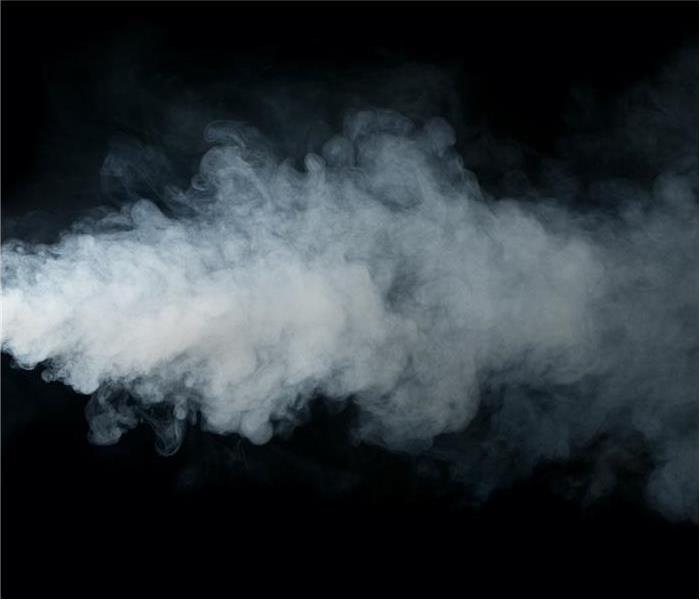 If you are dealing with home deodorization need call professional restoration services.
If you are dealing with home deodorization need call professional restoration services.
Ways To Reduce The Smell Of Cigarette Smoke
Home deodorization in Eagleville, TN, can be a challenge, especially if you or a family member smokes. Whether you are getting ready to host friends or family members or you just want to be ready for unexpected company, here are a few surprising things you can do to reduce the smell of cigarette smoke in your furniture and carpets and throughout your home.
1. Use Vinegar
Vinegar might not be the first thing that comes to mind when you think of cigarette removal, but it’s very good at removing stubborn scents from a variety of fabrics. If you have pillow cases, blankets, or decorative throws that are saturated with the scent of your cigarettes, throw them in the wash with two cups of vinegar. Then put them through a regular drying cycle. You’ll be surprised at how fresh-smelling they are when you pull them out. If the smell of cigarette smoke lingers, wash them once more to get rid of it completely.
2. Sprinkle Baking Soda on Furniture
Baking soda is a well-known air-freshening tool. It’s frequently used in refrigerators to soak up the smell of old, rotten food. You can also use it to absorb the smell of stale cigarette smoke. For home deodorization purposes, sprinkle baking soda on all soft furniture surfaces in your home. It won’t work very well on leather, but it should work great on fabric furniture. After sprinkling generously across all furniture, use your hands to smooth it out and make it disappear into the fabric. After letting it sit for at least 10 minutes, vacuum it up. You can use the same technique on carpets, rugs and drapes.
3. Repaint or Replace
In some cases, cigarette odor is so pervasive that it can’t be removed with simple cleaning methods. In this case, may want to consider repainting your home or replacing old, smelly carpets if the scent bothers you enough.
If you have tried the above steps and you still have an odor, try calling professional restoration services. They have the tools and expertise necessary to handle your home deodorization needs.
Why Do I Need Commercial Flood Insurance?
6/28/2021 (Permalink)
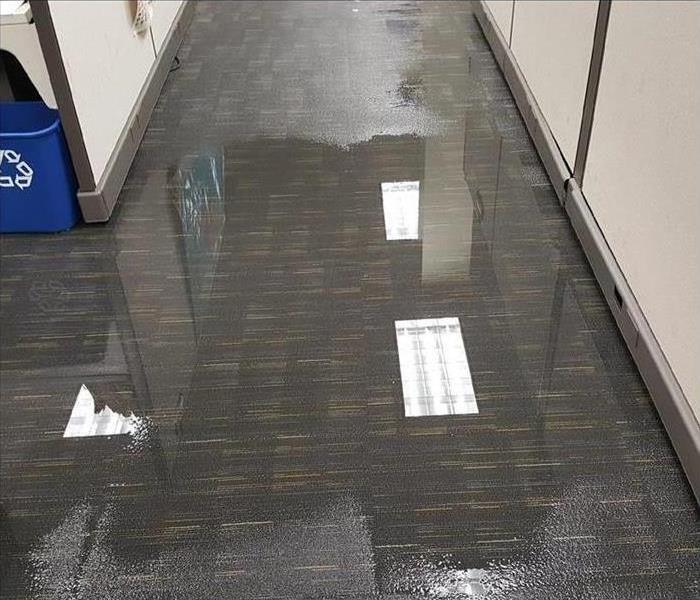 Storm damage in Rockvale, TN.
Storm damage in Rockvale, TN.
Expenditures are plentiful when you are a business owner in Rockvale, TN. However, you feel confident that the commercial insurance plan you have will cover your property and contents in a disaster. What about flood insurance? Is it mandatory? What are the benefits?
Mandatory Flood Insurance
There are times when you must purchase insurance coverage for potential flooding at your place of business:
• If your commercial property is located in a high-risk flood area, your mortgage company may require you to obtain this insurance.
• Flood zone maps designate which areas are low or high risk. When maps are rezoned, your business designation may change. The mortgage lender may notify you if your property is now in a high-risk flood zone, which requires purchasing additional insurance.
• At times, mortgage companies require insurance against flooding regardless of the flood zone.
Benefits of Insurance for Flooding
Flooding happens in areas regardless of the risk level. Even if you are not mandated to ensure your commercial property from floods, it is still a good idea:
• A basic commercial insurance policy does not typically cover floodwater. If water damage is not covered, you will probably have to pay a significant amount out of pocket.
• Even though there are federal programs in place to assist you in the event of a declared disaster, the money is not designed to fully cover complete restoration. Insurance can provide funds to restore your property to preflood condition.
• The water restoration specialist and your insurance agent can partner with you to seamlessly and efficiently get your business up and running after a flood.
Primarily depending on the location of your business in Rockvale, TN, you may be federally mandated to buy flood insurance. If you are not required to, it still makes good business sense to include it as a component of your commercial insurance policy. That way, you can be confident that your property is covered in the unfortunate event of flooding and water damage.
Why Your Business Needs a Power Generator
6/14/2021 (Permalink)
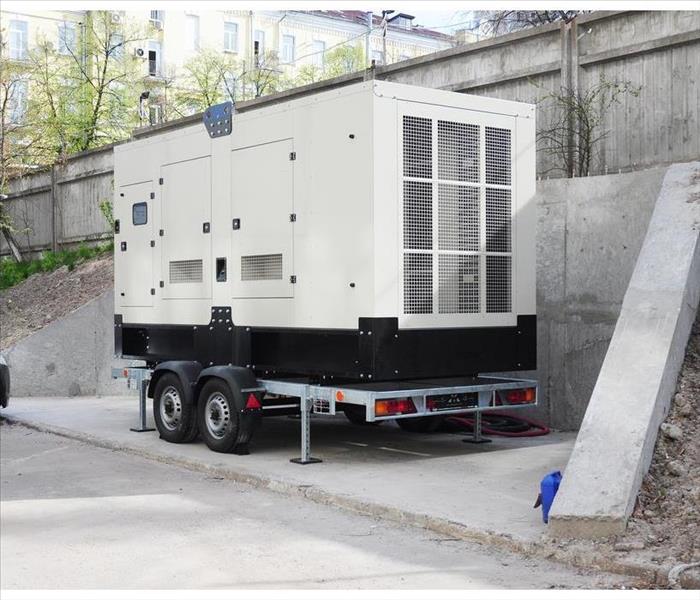 Commercial power generator.
Commercial power generator.
A severe storm can cause a power outage at your small business in Smyrna, TN. You don't need to shut down while you wait for it to return if you have a plan in place to rely on alternate power sources.
Why You Need a Back Up Plan
Severe weather, including rain, snow, hail and wind, can cause long-term damage to your business that may require the intervention of a disaster recovery service. If your business loses power, you risk additional financial harm due to:
- An inability to receive calls and emails from clients
- Reduction in employee productivity
- Lost electronic data
- Spoilage of perishable inventory
These consequences are avoidable if you use an alternate power source. Generators provide the most reliable solution for your business.
Generator Options
Choosing a generator for your business involves understanding your energy usage and the amount of space available to accommodate the unit. A portable generator is sufficient for most small businesses. It is usually mounted on a trailer and allows you to select the required voltage for specific tasks. These generators are easy to store when not in use.
Suppose a power outage at your business happens while you are not there, and losing power would cause significant hardship. In that case, you may prefer to invest in a standby generator that can kick in immediately. These generators integrate into a facility and are invaluable for businesses such as restaurants or grocery stores where food spoilage is a concern.
For businesses that handle sensitive information, such as accounting firms or medical offices, a standby generator coupled with an uninterruptible power supply is an ideal option. A UPS is a backup battery capable of running during a brief period before a standby generator begins working. It plays a vital role in the prevention of lost computer data.
Preparation Makes a Difference
When you expect weather that could lead to a power outage in Smyrna, TN, consider using a generator to continue business as usual.
5 Tips To Prevent Mold Growth in Your Bathroom
6/14/2021 (Permalink)
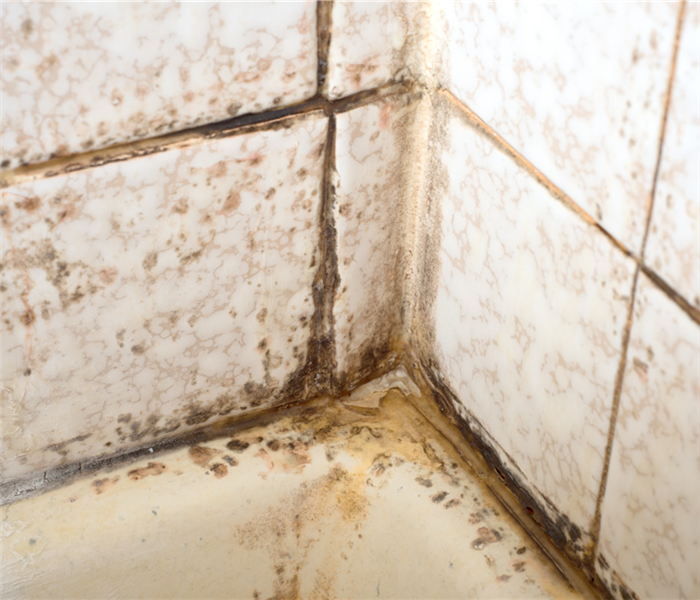 Mold damage in the bathroom.
Mold damage in the bathroom.
Keeping Your Bathroom Dry and Mold - Free
Can homeowners in La Vergne, TN, avoid unpleasant water damage and fungal growth in the bathroom? This space is a naturally moist location, fraught with humidity and pipes. Because the room is likely to develop this hazard, residents should take a proactive approach, consistently minimizing lingering water exposure. The following are five tips for keeping your bathroom dry and mold-free.
1. Use the Exhaust Systems
Inside your bathroom should be fans. These devices extract humidity from the air. This dampness, if allowed to linger, spawn mold. It's best to keep them on both during and after your shower or bath. Plan for about 30 minutes.
2. Dry Off Tile
Mold growth sets in when water meets fungus spores. These decomposing microbes live naturally within the house and yard. They become problematic when dampness triggers reproduction. At that point, the organism starts to feast on organic matter such as wood and insulation. Reduce the water sticking to your shower and tub by wiping it down after each use. Keep a squeegee in the shower stall. Grab it at the end.
3. Invest in Moisture-Absorbing Products
Some rooms are harder to keep dry. To stop water damage, place moisture-absorbing products in those sections. Consider under the sinks or within the toilet room.
4. Check Plumbing
For effective mold prevention, inspect the pipelines every so often. Open up the vanity doors. See if any leaks have started. Be cautious if rust or corrosion is present. Fix these concerns immediately. If you observe staining, a strange odor or discoloration, contact a mold remediation company for inspection.
5. Grout and Caulk Yearly
Don't let water penetrate through the tile. Be sure to seal it, maintaining a waterproof barrier. If dampness breaks through, it could begin a hidden mold colony. You may not know of the infestation until it has become severe.
Water damage isn't just excess fluid. It's the beginning of a mold infestation. To avoid this complication, concentrate on catching difficulties early and maintaining a dry environment.
3 Ways To Prepare for an Office Fire
4/19/2021 (Permalink)
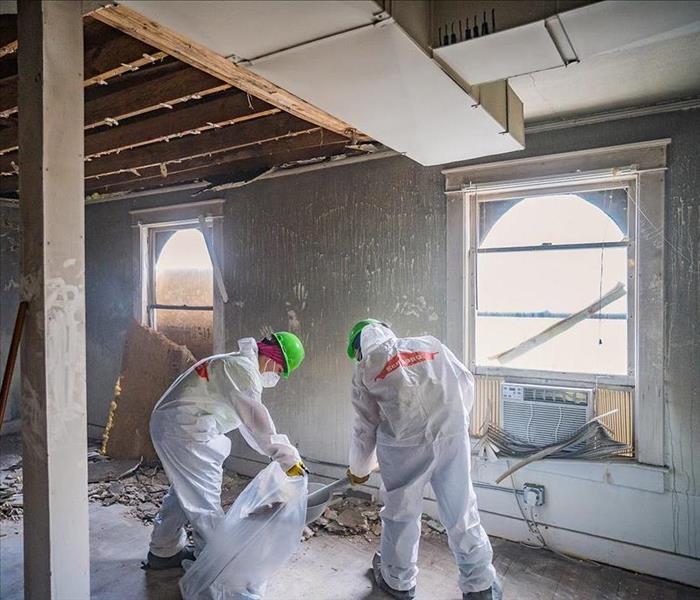 Clean up services after severe fire damage in Murfreesboro, TN.
Clean up services after severe fire damage in Murfreesboro, TN.
3 Ways To Prepare for an Office Fire
Thinking about a possible fire at your office in Murfreesboro, TN can be intimidating. However, office fires are not uncommon. According to the National Fire Protection Association, it is estimated that over 3,300 fires occurred annually in U.S. offices from 2007-2011. Thorough preparation of your fire sprinkler systems and other fire safety elements means your office can be better situated if a fire does occur.
1. Ensure Fire Detection and Suppression Systems Are Working
Preventing fires is always the best strategy, and working smoke detectors are essential. Check your office’s detectors monthly.
If a fire does break out, sprinklers may be your first line of defense in fire suppression. The National Fire Protection Association has thorough guidelines for inspecting sprinklers, which range from quarterly to annual inspections for different components of the system. Your office staff should be familiar with these guidelines to ensure your fire sprinkler system is functioning and equipped to deal with any problems.
2. Maintain an Office Fire Escape Plan
All employees should know to follow an up-to-date emergency plan. Hold regular drills and seminars to ensure that if a fire starts, employees know where to go and what to do. Be sure to identify and clearly mark emergency exits — whether by door or window — and an outdoor gathering place for employees to meet.
3. Be Prepared for the Aftermath of a Fire
What happens immediately after a fire can be as crucial as events during the fire itself. Damage can occur from flames, smoke, and water — fire sprinkler cleanup can end up being a significant chore in itself. Have contact information for a fire restoration service in Murfreesboro, TN, so you can take immediate action in the fire’s aftermath.
Office fires may be daunting, but readiness is a vital tool. Certifying that your staff, as well as your fire sprinkler systems, are prepared allows for a prompt response in case a fire does break out.
How To Protect Your Commercial Building From Rain Damage
3/30/2021 (Permalink)
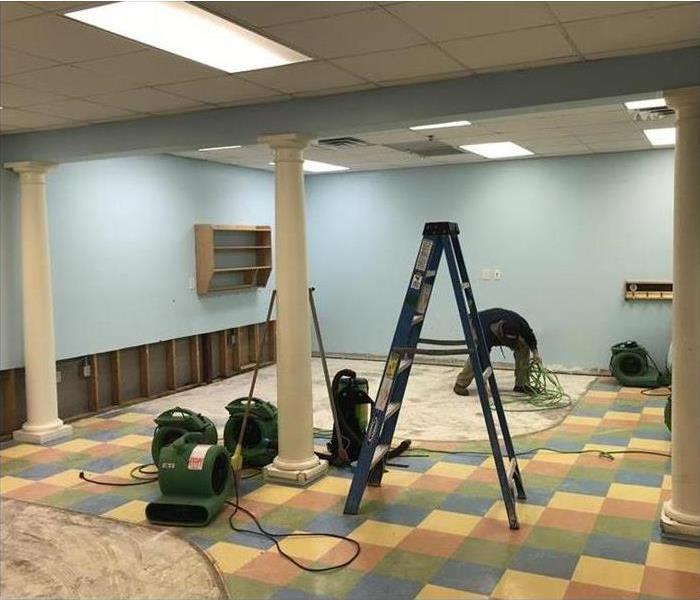 Drying equipment on a commercial building.
Drying equipment on a commercial building.
Rain damage can cause serious problems for your Milton, TN, business. Fortunately, proper maintenance can help keep the building protected and in good condition.
Prevention
To protect your commercial building from inclement weather, it is important to maintain the building envelope. The envelope is the barrier between the outdoors and indoors. An envelope is considered loose if it allows significant airflow from outside in and tight if it does not. The envelope is made up of several components:
- Roof
- Walls
- Foundation
- Windows
- Doors
Routine maintenance and regular inspections work together to keep your building's envelope strong and tight. Check for and repair cracks in the foundation and walls. Make sure the roof is leak-free and that the shingles or other roofing materials are secure. Doors and windows should be properly aligned and sealed.
Some business owners are comfortable performing inspections of the envelope themselves. Others prefer to hire a professional. Either way, it is important that the building be examined regularly to catch minor issues before they become serious problems.
Cleanup
Unfortunately, even buildings with properly maintained envelopes can suffer rain damage. If water inundates your business, it is important to act quickly to prevent structural damage and mold growth. Although black mold is the most notorious, all fungi can cause problems.
Dry the property out as quickly as possible. A certified restoration service can help with this step, but you may be able to start the process yourself if you have access to a wet/dry vacuum.
After the standing water has been removed, there will still be moisture in porous items. Fans and dehumidifiers can be used to finish drying the area. When everything is dry, professionals can help you determine what can be cleaned and salvaged and what needs to be replaced.
The building envelope is your commercial structure’s primary defense against storm and rain damage. Keeping it in good shape is the best way to protect your business from inclement weather.
5 Tips on How to Prevent Fire Damage to Your Home
3/25/2021 (Permalink)
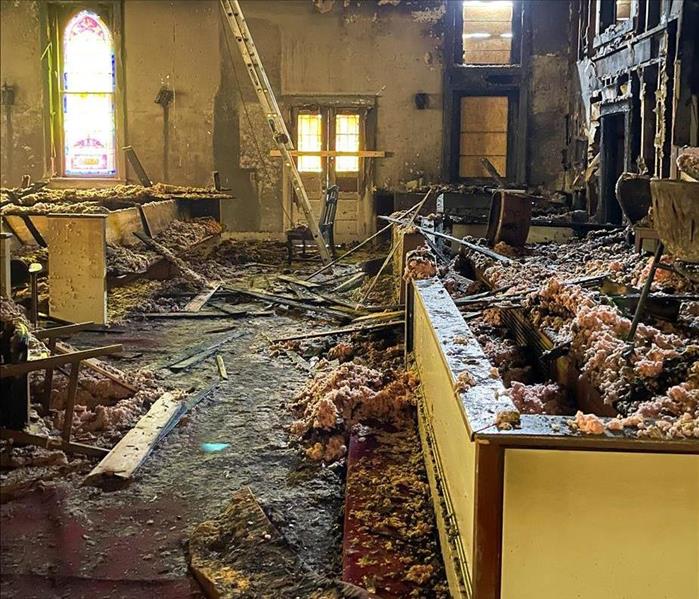 SERVPRO of Rutherford County can handle any size fire loss in the Murfreesboro area.
SERVPRO of Rutherford County can handle any size fire loss in the Murfreesboro area.
For the average homeowner, the very mention of fire damage is enough to strike terror into anyone’s heart.
According to FEMA, a fire can become life-threatening in just two minutes. In as little as five minutes, your home could be engulfed in fire.
When it comes to residential or commercial fire damage, fire safety is one thing that you can’t put on the back burner. Taking the proper steps on how to prevent fire damage can go a long way in saving your belongings and avoiding costly repairs.
5 Tips on How to Prevent Fire Damage
1. Observe Proper Installation of Fire Alarms
Fire alarms and smoke detectors are your home’s first line of defense. Early detection of smoke will not only save your property but most importantly, your life as well.
While the installation of smoke detectors has become a law, there are still many properties that don’t install their fire prevention systems properly. One of the first things to ensure is the proper installation of your fire alarm system. Larger buildings should have multiple fire alarms on each level.
As a general rule, you should follow these guidelines for a proper fire alarm installation:
- Avoid placing the detector in recessed ceilings
- Don’t install the detector near vents, doors, or fans
- Install the device 2 feet from any corner
- Install it 10 feet away from the stove
- Install it 2 feet away from any lighting fixture
It’s always a good idea to test your fire alarm system once every month. Batteries should be replaced at least twice a year.
2. Watch Out for Candle Burns
A little burning candle never really caused any real damage, right?
Well, not really!
According to the National Fire Protection Association, candles caused 2% of home structure fires. Any source of fire poses a risk to your property’s safety.
Candles are great for setting the mood and providing a nice scent for the room but they shouldn’t be left unattended. Also, make sure that you place the candles on flat surfaces and away from drapes, pets, and children.
3. Inspect Home Appliances and Lights
Inspection of your home appliances and lights should be a part of regular home maintenance.
Make sure that your wires, plugs, and bulbs are not damaged. Just by having pets or using the vacuum can cause damage to your appliance wires. Once damaged wires are plugged, it might cause the appliance or light fixture to catch fire. Always keep your wires and cords organized and refrain from placing them under a rug or between a piece of furniture and a wall.
Double checking your appliances before plugging will help prevent fire damage in your home.
4. Pay Attention to Cooking and Heating Equipment
Aside from open flames, cooking and heating equipment are also primary causes of fires in the home.
For starters, you should make it a habit to keep your stove and oven clean. You should pay more attention to cleaning the grease around your stovetop since this can lead to a grease fire. Clean the vents, filters, and grease traps to prevent grease fires. Also, you should make it a point to keep flammable items away from the stove.
As for your heating equipment, make sure that it is installed and maintained by a qualified professional. Also, you need to check the heating device for potential damage on a regular basis.
5. Have Fire Extinguishers at the Ready
The worst thing that can happen once a fire breaks out is having no way to extinguish it. If you don’t have one already, it’s important that you secure a fire extinguisher for your home.
However, just having a fire extinguisher is not enough.
Make sure that you inform every family member where to retrieve the fire extinguisher. On top of that, everyone should know how to properly use the extinguisher in case a fire breaks out.
Get Restoration Professionals to Help You
If you’re unlucky and weren’t able to prevent damage to your home, your best bet is to work with a company that specializes in fire damage restoration.
Restoration is often cheaper than replacing the damaged areas. Plus, the former solution is a lot faster as well. For your fire restoration needs in Rutherford County, Murfreesboro, and Smyrna, don’t hesitate to call SERVPRO of Rutherford County.
Tips for Preventing Water Damage When You Are Away
3/9/2021 (Permalink)
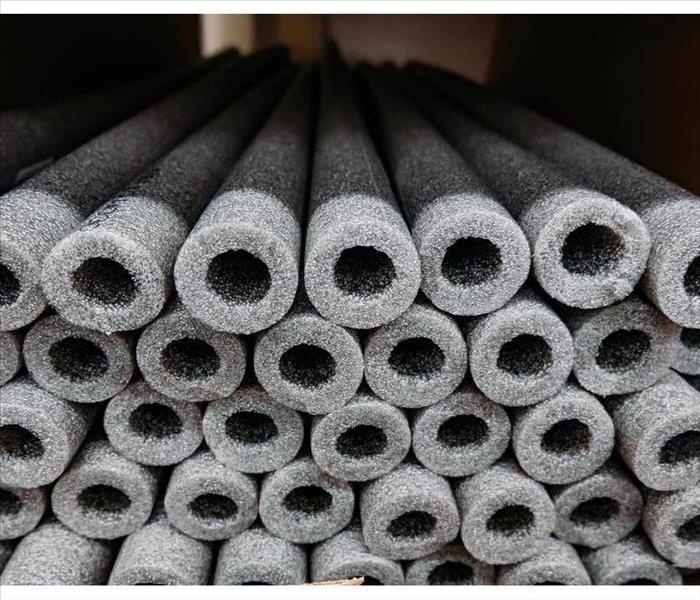 Insulate your pipes to protect them from extreme temperatures.
Insulate your pipes to protect them from extreme temperatures.
Tips for Preventing Water Damage When You Are Away
Taking a trip is a great way to unwind from the stress of everyday life. Coming home to find you need water pipe repair and damage mitigation can negate the relaxation you just enjoyed, though. Preparing your home before your trip is the best way to prevent unpleasant surprises when you return.
Inspection and Maintenance
According to water damage specialists, proper maintenance can help you avoid a flooded home. Before you go on your trip, complete your maintenance checklist:
- Check for cracked and rusted pipes or supply lines
- Inspect roof for damage or weak spots
- Clean gutters and downspouts
- Test your sump pump to ensure it's working properly
Pipe Protection
Water pipe repair becomes necessary when unprotected pipes burst from freezing or other types of damage. If you are traveling away from your home in Walterhill, TN, during the winter, make sure that you have taken the necessary precautions. Insulate your pipes to protect them from extreme temperatures, particularly if they are located in exterior walls. Keep the heater on in your home so that the interior temperature stays warm enough to keep pipes from freezing. Open cabinets under each sink to ensure that warm air can get to the pipes.
Outside Assistance
While you are away, it helps to have someone else who can be your eyes and ears in your absence. Enlist the help of friend or neighbor to keep a watch on your home and look for signs of a broken pipe or other trouble while you are not there. If there is no one available to help, consider turning off your water main before you leave to keep water out of your pipes.
The best time for water pipe repair is before the leak causes damage to your home. If you take the right preventative measures before you leave for your trip, you can relax knowing that your home is safe in your absence.
5 Myths About Polybutylene Plumbing
2/11/2021 (Permalink)
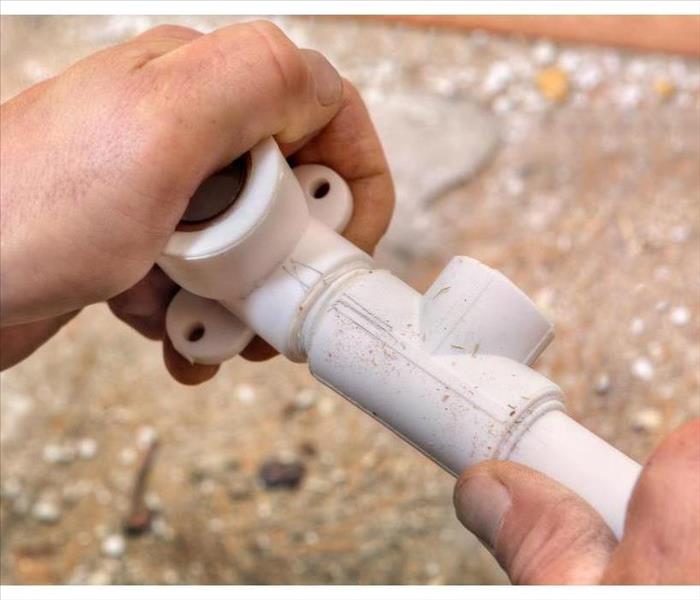 Most polybutylene systems won't fail for years.
Most polybutylene systems won't fail for years.
5 Myths About Polybutylene Plumbing
If you are running your business out of an older building, chances are the plumbing is using some materials of questionable integrity. Here are some myths about one particular material that may convince you it is time for new plumbing.
1. Only Pipes With Plastic Fittings Experience Problems
This is not true. Your system may have metal fittings, but that doesn’t mean it won't fail. This is because systems with metal fittings still contain polybutylene pipes and plastic valves, which can fail. However, systems with plastic fittings have more components that can break and have a greater failure rate. Basically, it is a classic bad versus worse scenario.
2. Replacing Them Is Expensive
Replacing older pipes costs roughly the same as putting in new carpet or redoing the roof. To put this cost into perspective, it is usually cheaper than replacing all of your windows or waterproofing the basement. However, this is contingent on you using a re-piping specialist. While it can be an unexpected cost associated with a business, it can prevent you from needing water restoration professionals.
3. Everything Is Covered Due to the Class-Action Settlement Fund
The class-action settlement was very generous. However, it doesn't cover everything. There are serious limitations on free pipe replacements in Murfreesboro, TN.
4. Problems Occur Due to Poor Installation
While installation problems can occur with polybutylene pipes, this is not the main problem. More common factors include degraded fittings, water quality issues, chlorine levels, and age. One or more of these factors can contribute to a failure over time. In other words, even those that were installed perfectly are still susceptible to failure.
5. These Pipes Have Lasted 10 Years, so They Are Still Good
This is not true. Most polybutylene systems won't fail for years. In fact, it usually takes about 10 years for leaks to develop.
Like many business owners, you probably want to avoid water damage in your building. If this is the case, you should consider these common myths about older pipes and whether you should replace yours.
The Complicated World of Mold Insurance Claims
2/2/2021 (Permalink)
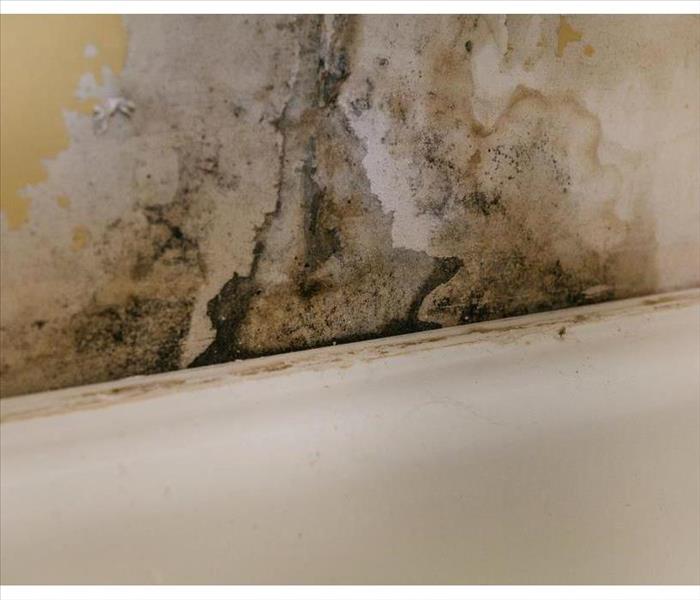 A professional mold mitigation franchise is your best protection against a fungal outbreak.
A professional mold mitigation franchise is your best protection against a fungal outbreak.
You can count on commercial insurance to cover your business in Murfreesboro, TN, in the case of many perils. When it comes to mold insurance claims, though, there are several unknowns and gray areas. This isn't too unusual in the insurance industry, but it can be even more complicated when dealing with mold. For this reason, it is always in your best interest to speak in depth with your insurance agent. Most policies have a fungus exclusion, which rules out coverage and payments, but there is also a thing called limited fungus coverage. This typically does provide some money to business owners for fungus damage, repair and repair under specified and named conditions.
Company Responsibility
There are several situations that are pretty clear when it comes to mold insurance claims. If you have acted negligently or improperly in maintaining your property, the insurance company is unlikely to honor a claim. This can take many forms:
- Failure to maintain an adequate roof system
- Failure to repair leaks
- Incompetence in cleaning up after a flood
- Failure to act on repairs in a timely fashion
In other words, if your company could have done something to limit damages and did not, and this inaction resulted in mold damage, the insurance provider will deny a mold claim. If you find mold on your property, it is crucial to take swift, appropriate action.
Mold Remediation
A professional mold mitigation franchise is your best protection against a fungal outbreak. A SERVPRO team is Faster to Any Size Disaster and they will come to your facility in a matter of hours. Trained technicians will work to stop and remove any standing water in the building, often the cause of mold growth, and they will take action to contain the spread of microscopic mold spores. The rest of the process includes removal, cleaning, and restoration of damages. The franchise, experienced with mold insurance claims, will help document any damages and repair costs to speed up the claims process.
How To Prevent Mold Damage After a Flood
1/15/2021 (Permalink)
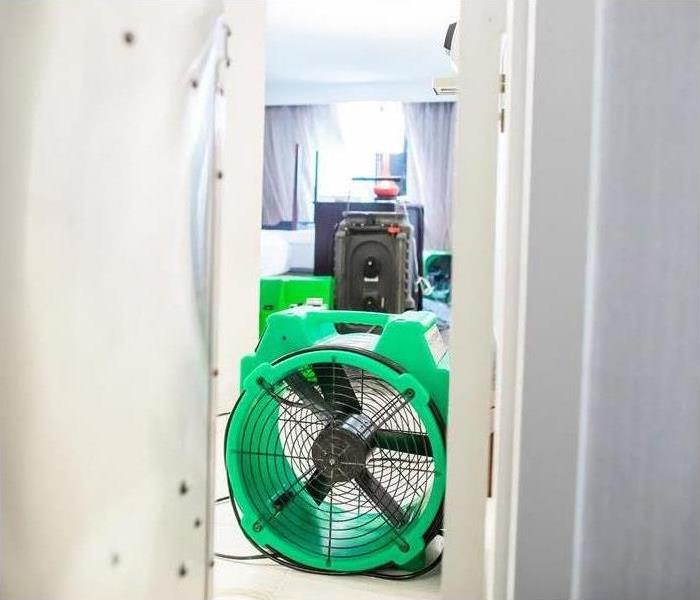 Calling a professional water cleanup service is always recommended after a flood
Calling a professional water cleanup service is always recommended after a flood
How To Prevent Mold Damage After a Flood
Major storms and hurricanes can cause severe damage to your home. Between the heavy rain and strong wind, many homes are subject to flooding in Murfreesboro, TN. If your home has suffered from a flood, it is important to act quickly to clean up your home and mitigate any loss from water damage or mold growth.
If you suspect you have mold in your home, remove it as soon as possible, as even small amounts of mold can lead to:
- Unpleasant odors
- Damage to your home
- Dark and unsightly stains
- Rapid mold growth and infestation
Dry Out Your House
If your home is flooded after a storm, you should remove standing water as quickly as possible and dry out the flooded area. The longer the water stays in your home, the more likely it is to cause damage. Damp, humid areas are a breeding ground for mold and mildew, so you need to eliminate as much moisture as possible.
Get Help Quickly
Calling a professional water cleanup service is always recommended after a flood, as they are expertly trained to handle flood cleanup and mold prevention. In addition to drying out the flooded area, they will also clean, deodorize, and disinfect your home to remove any bacteria that has seeped into your floors and walls.
Document the Damage
Remember to keep a file with all repairs and expenses to file with your insurance company if you plan to file a claim. Gather receipts that show the cost of any damaged property and any receipts from professional cleanup services. Always check with your insurance provider for coverage under your policy.
There is no time to spare when dealing with mold growth after a flood. If you think you have a mold problem, removing the water from your house and thoroughly drying and disinfecting the area is your best course of action. Getting professional help and maintaining good records will ensure that you eliminate the problem, mitigate the damage, and prevent any additional loss.
4 Steps To Fix a Flooded Basement
12/28/2020 (Permalink)
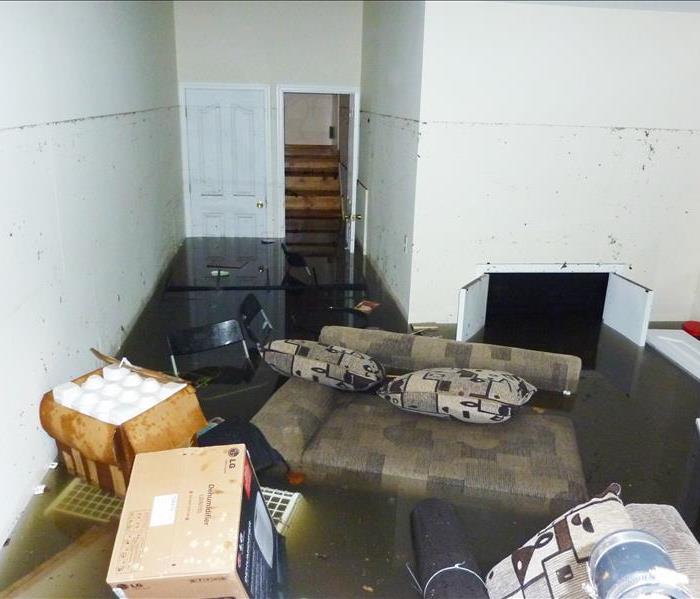 Flooded basement in Murfreesboro, TN.
Flooded basement in Murfreesboro, TN.
4 Steps To Fix a Flooded Basement
If you return to your Murfreesboro, TN, home and find a basement flood, it may feel like it can never be fixed or will be an expensive unexpected cost. If you live in a flood-prone area, having flood insurance coverage helps ease the second concern. When it comes to the fix, along with getting help from a certified water damage and restoration company, there are four steps to take to get your basement back to as it should be.
1. Water Extraction
The sooner you can get the standing water out, the better chances you have of salvaging items and avoiding secondary issues, such as mold. Before grabbing buckets, mops and wet/dry vacuum, ensure it is safe to enter the area. Anytime there is unwanted water, electrical hazards increase.
2. Clear Out Wet Items
When a basement flood happens, there is a good chance there are many objects and belongings that are saturated. After taking videos and pictures of everything as it is for insurance purposes, remove anything that you can and store it in a dry, safe place to dry out. For bigger objects that can’t easily be moved, temporarily cover them to keep them contained.
3. Dry It Out
The key to dealing with any flooded area is getting it dried out. If the basement has windows and the humidity level outside is lower than inside, open them to increase ventilation. Run fans and a humidifier to aid in the drying process until help arrives with industrial tools.
4. Consider Waterproofing Options
As you deal with the mess, it’s the perfect time to consider reinforcing your basement to guard against a repeat situation. The first step is to determine the source. If it wasn’t an unexpected event, such as a pipe burst, there are many sealants and waterproofing methods that can create a barrier from water infiltrating your home.
A basement flood is never anything wants to find themselves facing. By taking quick action and getting the right help, you can get back to “Like it never even happened.”
How To Prepare an Emergency Plan for Your Company
12/28/2020 (Permalink)
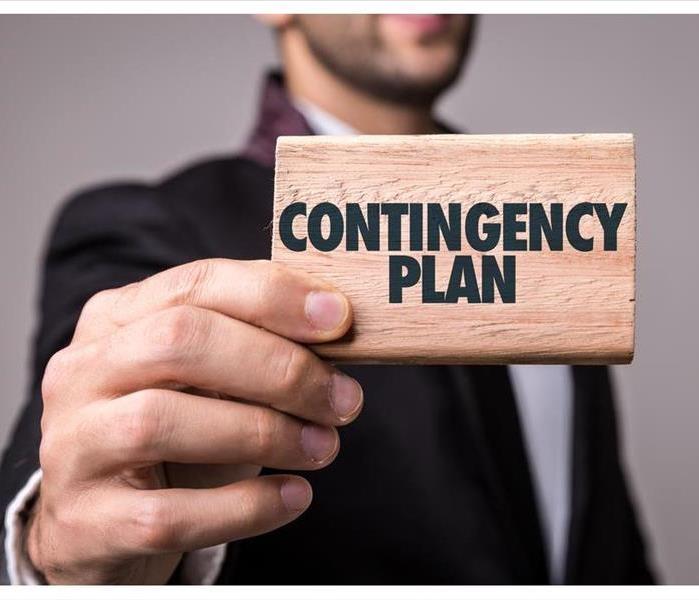 Organizing an emergency contingency plan for your company may take time, but the effort is worth it
Organizing an emergency contingency plan for your company may take time, but the effort is worth it
Here Are A Few Ideas On How To Prepare A Contingency Plan For Your Company
According to the Department of Labor, almost every business is required to have an emergency action plan. Since you care about your business and employees, you don't doubt the importance of having one, but sometimes it's difficult to know what all you need to include. After all, these are adults, not children, so everyone has experience with fire and emergency safety.
Make It Unique
Your company and your building in Murfreesboro, TN, is unique. If you run a small production factory, you shouldn't model your evacuation plan of a plan for a large, multi-floored office building. Walkthrough your space and note the exits, potential hazards, and resources for protecting yourselves. The number of employees you have, their physical abilities, and the location of your business should all be factors in your emergency plan.
Plan Different Scenarios
While fires are the most common type of business emergency, you may also need to prepare a contingency plan for other natural disasters such as hurricanes, tornadoes, earthquakes, or mudslides, depending on where your business is located. If you work with explosives or dangerous chemicals, or you're located in an area where those are factors, you need a plan to shelter-in-place or to evacuate quickly and safely. Assign roles to your employees to keep track of their coworkers so that any evacuation or sheltering scenario is executed efficiently.
Report An Emergency
Create a plan that everyone understands for reporting emergencies. How will reliable information get to your employees so that everyone knows what to do? Select leaders and alternates to sound alarms, make announcements and call for the appropriate type of help whether fire rescue, EMTs, or emergency mitigation services.
Organizing an emergency contingency plan for your company may take time, but the effort is worth it so that you and your employees can stay safe during a disaster.
3 Mold Remediation Steps
12/8/2020 (Permalink)
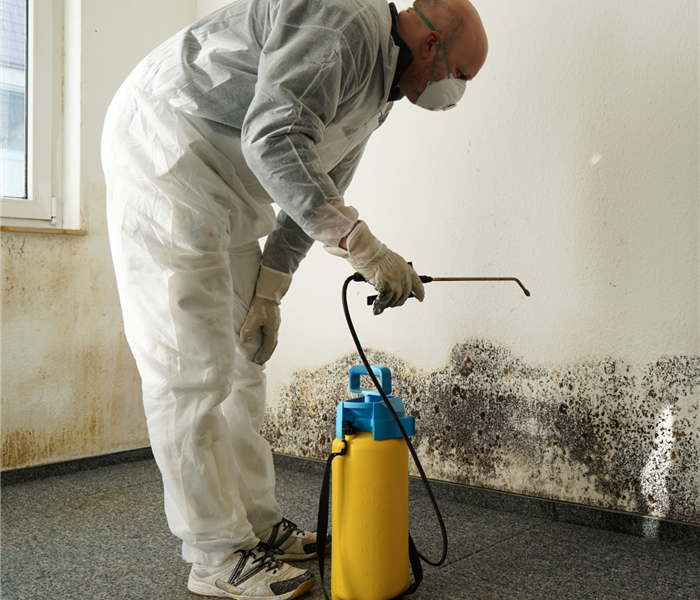 Mold remediation in Murfreesboro, TN
Mold remediation in Murfreesboro, TN
Mold Remediation Steps
If you have discovered black mold in your building, prompt mold remediation is key to mitigating your damages and avoiding future problems. You can help make the process go more smoothly by familiarizing yourself with the steps involved.
1. Follow the Moisture
Mold can be difficult to track down because it often grows in places you can not see. One way professional mold remediation companies discover all of the areas of mold growth in a building is to look for the sources of moisture that fuel its growth. By locating moisture sources and tracing them to their point of origin, mold cleanup professionals can ensure all existing mold is removed and prevent future mold problems.
2. Make a Plan
Once all of the black mold has been located, your mold removal team will document it with writing, photos and video and then use that documentation to create a removal plan. The plan should include information such as when work is expected to start and be completed, who will be doing what, any testing that is needed and whether you will need to keep employees and clients out of the building while the work is being done.
3. Remediate Mold Contamination
The next step after creating the plan is to execute it. Mold professionals in Murfreesboro, TN, will work to eliminate all of the existing mold in your building while maintaining safety measures to avoid exposure. The process will involve isolating the contaminated area, suppressing dust, removing damaged materials, cleaning, testing and drying. You may need additional assistance to repair any leaks and replace damaged materials, such as drywall, furniture or ceiling tiles.
Black mold remediation is a multi-step process that involves assessment, planning and execution. Your professional mold removal team will have the experience and equipment necessary to safely locate and combat your mold problem and prevent additional damage and future problems.
Prevention Key to Avoiding a Water-Related Business Claim
12/8/2020 (Permalink)
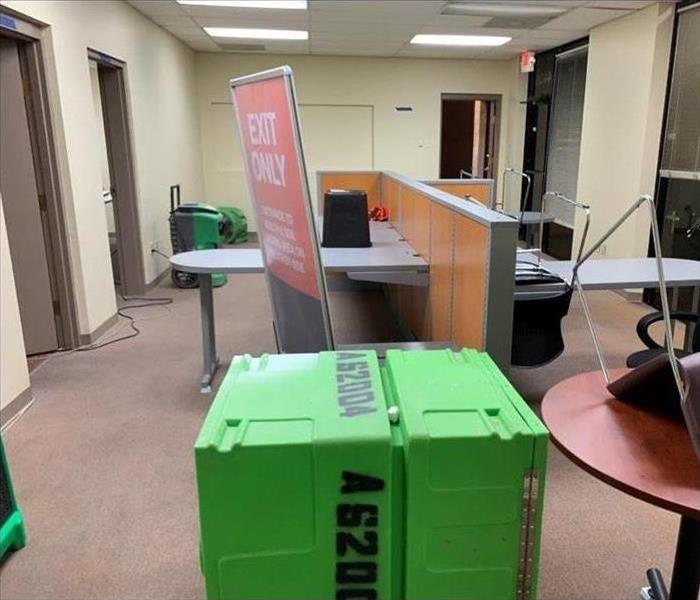 Water damage in an office building
Water damage in an office building
Business owners in Murfreesboro, TN, know the importance of having commercial insurance for unexpected events. While that may provide peace of mind, avoiding a business claim altogether is the best option. One of the top causes of claims is water damage to the commercial building and contents. Although not all water issues can be prevented, proper maintenance of the plumbing system can avert such problems as a burst pipe or leak.
Prevention Tips
In most cases, the insurer will cover an accidental pipe break. If mold growth occurs because of this issue, it may or may not be included. If the leak was ongoing and already resulted in the mold, or if precautions weren’t taken after a break to mitigate secondary damage, your business claim for mold will likely be denied. Instead of getting a surprise, help keep your business in the best shape possible with these tips:
- Insulate any exposed pipes.
- Maintain indoor temperatures above 55 degrees even if the building is empty.
- Verify that wall cracks and lines for electrical conduits, utility services and fire protection are properly sealed.
- Insulate recessed lighting fixtures and drafty areas near pipes, including attics.
- Ensure gutters and downspouts are clear of debris and properly draining away from the building.
- Consider installing an automatic excess flow switch to monitor the waterline.
Call the Professionals
If a pipe has already burst, immediate action is needed. The first step is to turn off the water to stop the incoming flow. A broken pipe can unleash many gallons of water, which increases the need for extensive cleanup and repairs. Along with calling a plumber and making a business claim, contact a mold and water damage restoration company to assess the circumstances. They have the necessary expertise, tools and techniques to clean up the situation and prevent secondary damage from happening.
While filing a claim due to unexpected water or flood damage isn’t completely avoidable, maintaining your property and making a few improvements can help prevent an emergency.
The Optimal Number of Fire Alarms in Your Home
12/8/2020 (Permalink)
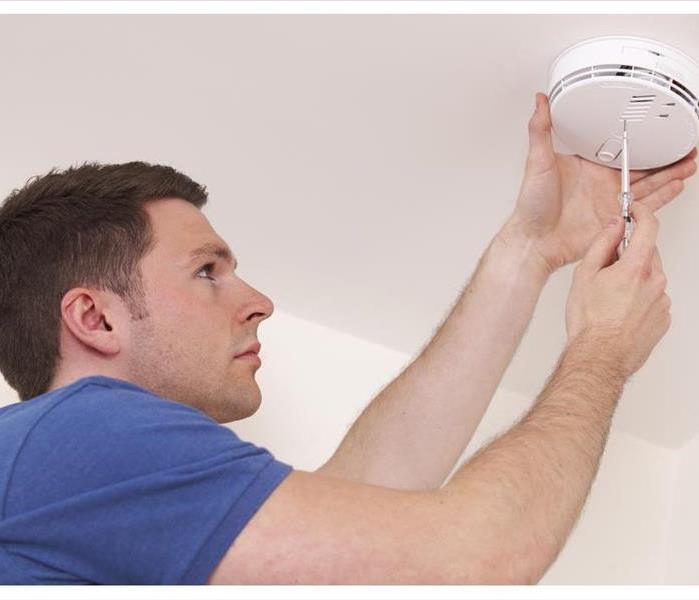 Man installing a smoke alarm in a Murfreesboro, TN home
Man installing a smoke alarm in a Murfreesboro, TN home
How Many Alarms Should You Have In Your Home
A fire is certainly a scary thing. It has the ability to destroy your home in Murfreesboro, TN, and it poses a serious threat to the safety of your family. For these reasons, it makes sense to arm yourself with a few tools of fire prevention. Every home should have at least one fire extinguisher, and probably one for each floor. A fire alarm is crucial, too. This can provide a quick alert to everyone that something is amiss and that it might be time to get out of the home. It can save lives and property. For your home to be adequately protected, you should consider how many alarms are optimal.
An Alarm on Every Floor
If your home fire alarm system is not interconnected, you should put an alarm on every floor at the minimum. You want everyone in the house to be able to hear it when it sounds. For extra safety, alarms should be placed in rooms where fires are more likely to occur such as kitchens. Finally, it is beneficial to place alarms in every bedroom for the following reasons:
- People might not hear a distant alarm when they are sleeping
- Individuals in one part of the home can alert others
- People are most vulnerable at night
A quick notice of an incipient fire is one protection against fire damage. The quicker a fire can be put out, the less devastation a fire will cause.
The Importance of a Professional Cleanup
While a fire alarm can save lives and reduce damage, even the smallest fire causes an array of odors and other problems. Cleaning up after a fire is difficult and requires a certain level of expertise. The services of a quality fire remediation franchise is the surest way to get your home back in order again and to remove smoke damage. Technicians will make sure the home is free of all the problems caused by fire. It is another way to protect your home from the ravages of fire.
Can a Toilet Overflow Cause (or Be Caused By) Sewer Damage?
11/24/2020 (Permalink)
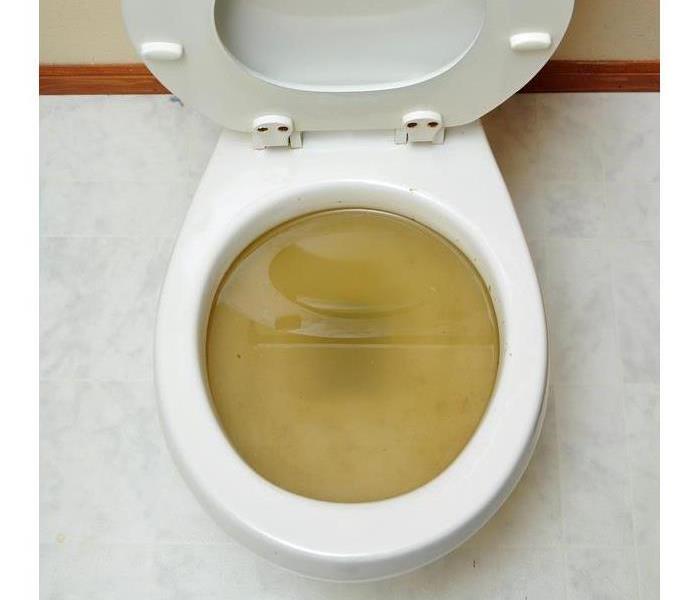 A toilet overflow can be a nasty mess
A toilet overflow can be a nasty mess
Can a Toilet Overflow Cause Sewer Damage?
A toilet overflow can be a nasty mess. Sewage water, also called black water, gets everywhere. Unless the flooded toilet was unused since the last full cleaning, areas where the black water reaches should be considered a biological contamination zone.
Sewer damage or septic problems are a possible cause of toilet flooding. However, in most cases, the issue is with the toilet itself.
The three most common causes of overflow are:
- A blocked drain
- A malfunctioning float
- A blocked vent pipe
What Should You Do First?
If you can access the toilet shutoff valve, turn the water off immediately! Every ounce of water creates a much larger mess.
If there’s no shutoff valve, open the tank lid and carefully lift the float up. Don’t yank it —it could break off, causing a worse disaster. Once the float is high enough, you can prop it up using whatever is handy. However, always use the shutoff valve if one is available.
What Next?
You can now consider what to do with the water in the bowl, but be careful what you stick in the toilet! It can cause sewer damage. If the sewage company finds things you shoved down the toilet, they may conceivably bill you for damages.
If you have a plunger, carefully use that. Follow good practices for use, because if used incorrectly, a plunger is often useless — or it could even make the mess larger.
If a plunger doesn’t work and you know how to use a snake (and have one available), go ahead and carefully try to snake the toilet. A blocked vent pipe can also often be cleared by a snake, so they’re very handy to keep in your toolkit.
If you’ve avoided sewer damage, you can concentrate on cleaning up the black water. Because of the pathogens, this should be left to a certified sewage cleanup company. Professionals have commercial disinfectants that can make quick work of toilet overflow damage.
3 Ways Renters Insurance Covers Mold Damage
11/24/2020 (Permalink)
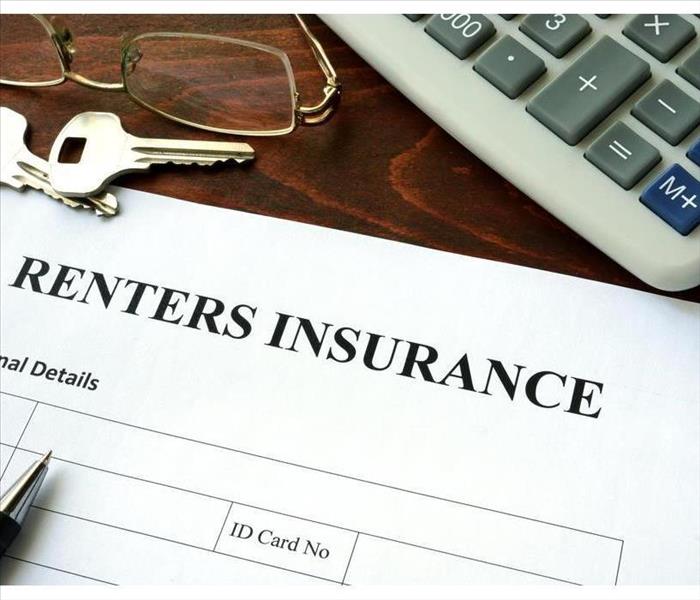 Renters insurance can protect it against the ravages of mold damage after a flood
Renters insurance can protect it against the ravages of mold damage after a flood
3 Ways Renters Insurance Covers Mold Damage
When your Rockvale, TN, rented property suffers water damage, you may wonder if your rental insurance covers costs for secondary damage, such as mold growth. You may encounter different types of fungi growth after a flood, many of which can take hold as soon as 24 hours after a flood. Understanding coverage circumstances for such an issue may help you maintain peace of mind in the wake of mold and water events.
1. Internal Flooding
Indoor flooding, such as water from burst pipes, leaking appliances or water lines and malfunctioning air conditioning units, can all cause mold growth soon after. Even if you dry the area with fans or towels, mold damage might still occur under cabinets or carpeting, which makes it difficult to spot. You may want to report the presence of mold to your insurance representative and your landlord as soon as you discover it.
2. Water Heater Damage
Rental insurance is likely to cover any mold problems caused by your rented apartment’s water heater. These appliances can crack and leak on occasion, which may cause mold growth at the source. Over time, spores become airborne and can travel to other parts of your home and find warm, moist places to grow anew. You can ask your insurance representative about the extent of your coverage for this circumstance.
3. Property Damage
Furniture, clothing and other personal belongings can be severely damaged by mold growth. A mold removal and remediation service may be able to restore some items, and your insurance will probably cover the cost. However, because insurance companies and policies vary, speak with your local agent before you commit to any type of restorations.
Rental insurance for your Rockvale, TN, apartment or other rental property can protect it against the ravages of mold damage after a flood. The better you understand your coverage, the faster you may be able to act when these problems arise.
Smoke Removal After a Fire
11/11/2020 (Permalink)
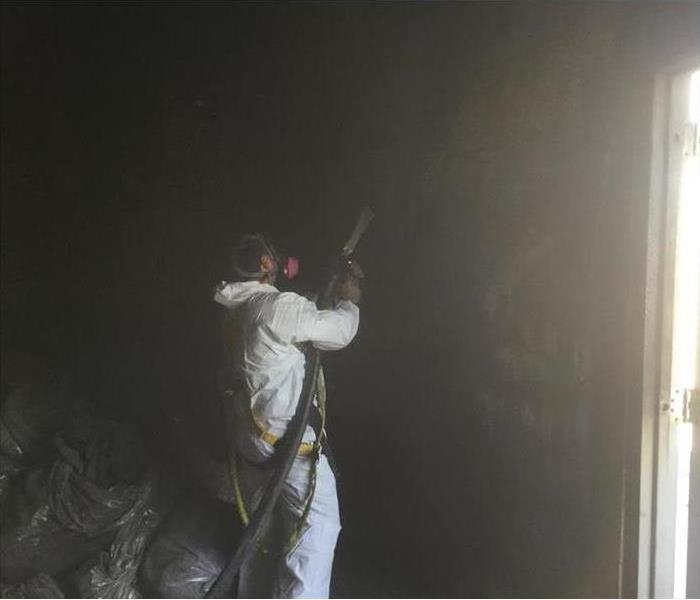 Smoke odor removal in Smyrna, TN
Smoke odor removal in Smyrna, TN
When a fire loss happens, no matter how big or small, the cleanup process often means replacing drywall, carpeting and other materials in your Smyrna, TN, building. Even after everything looks like its back to normal, there may still be lingering effects. A professional fire damage and restoration professional will ensure that proper smoke cleaning and soot removal are completed.
Smoke Removal Process
Unfortunately, smoke damage can last a long time. Along with soot, many of the burned materials produce gases while burning that can penetrate materials without leaving a visible sign of an issue. Removing the residue and odors means cleaning burned items to restore them back to normal. Below are steps taken to make it “Like it never even happened.”
Salvageable Items – Depending on what the belonging is, an array of methods or used to clean items. Oftentimes it will involve pressure washing, scrubbing and disinfecting surfaces.
Air Ducts – Since smoke and soot are in the air, particles can easily make their way into an HVAC system. Cleaning the air ducts is necessary to avoid contaminating other areas of the building and eliminating the problem.
Tackling the Air – Airborne odor requires innovative methods to get rid of. Certified professionals have high-tech tools on-hand to make the interior air fresh again.
Air Cleaning Techniques
To completely remove smoke odor, the smoke cleaning techniques used include:
Air Scrubbing – This involves a HEPA scrubber that removes airborne particles.
Thermal Fogging – A device is used to fill the air with a deodorizer. It creates a chemical reaction with odor molecules to eliminate them. This method does require leaving the property when in use.
Vapor Modification – A mineral oil-based compound is released into the air to combat the odor. It also penetrates affected porous materials.
Ozone Generation – Some types of smoke are harder to eliminate. This method oxidizes molecules via releasing oxygen. It often requires 24 to 48 hours in a controlled environment.
Fires can be an overwhelming experience, even long after the flames are out and repairs are done. Smoke cleaning services can help ensure the problem doesn’t linger.
How To Write a Business Continuity Plan
11/11/2020 (Permalink)
 A business continuity plan is vital
A business continuity plan is vital
Steps To Develop Your Emergency Response Plan
Sustained business interruption can cost your business thousands of dollars in lost revenues. Having a business continuity plan in place can help you mitigate your losses during a natural disaster, fire or another event that may interrupt your normal operations. These steps can help you develop your emergency response plan.
Set Realistic Goals for Your Plan
Before you begin writing your plan, you need to determine what you want to accomplish with it. The overall goal of your plan should be to keep your business running as efficiently as possible during a disruption event; however, it is a good idea to set smaller goals that will help you achieve your larger goal. You should consider and prioritize essential business processes:
- Operations
- Human resources
- Administration
- Maintenance
- Marketing
- Customer Service
- Information Technology
- Shipping and Receiving
- Billing
Complete a Risk Assessment and Business Impact Analysis
Completing a risk assessment and business impact analysis will allow you to determine what the most severe possible risks are to your business during a disruption event. You should talk to key stakeholders to determine what the impact on your business would be if key business functions were interrupted and prioritize addressing these functions in your business continuity plan by how likely disruption to that function is likely to occur and how severe the impact is likely to be.
Write a Plan for All Essential Functions
Once you have established which functions are essential and how to prioritize them in your plan, you should write a plan for dealing with disruption to each essential function. Consider including the names and contact information of professional disaster recovery services in La Vergne, TN, that can be called upon to help get your business running again during a disaster.
A business continuity plan is vital to minimize revenue loss and keep your business functioning during a disaster or other business interruption. These steps can help you get started on your plan.
Who Pays For Flood Damage to a Rental Property?
11/11/2020 (Permalink)
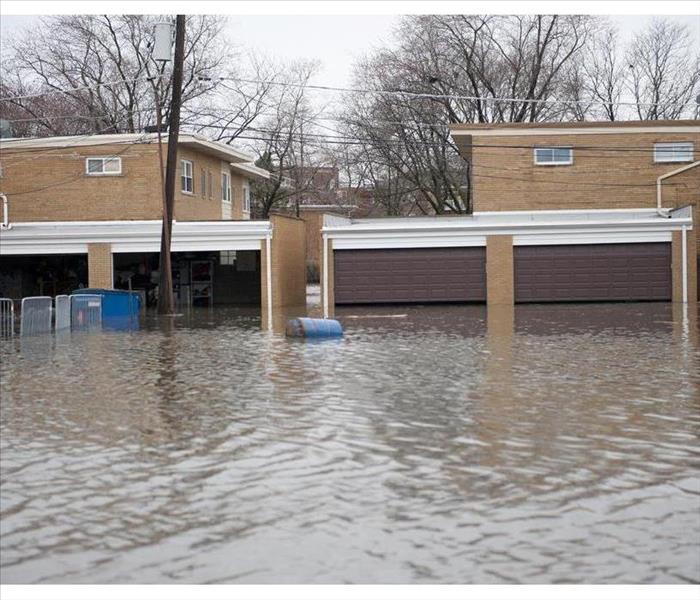 Flood damage in Christiana, TN area
Flood damage in Christiana, TN area
Understand Each Party's Responsibilities
When a rental property floods, it’s not always clear what happens next. Many leases don’t include any provisions addressing potential disasters. It’s helpful to understand each party’s responsibilities, as well as the roles that property insurance and renter's insurance play in covering the costs of flood damage.
Owner’s Responsibilities
After a flood, it’s ultimately the landlord’s responsibility to get the property back into a habitable condition. This means the owner must
Repair any structural damage to the building.
Ensure that the property has been fully decontaminated in accordance with applicable health and safety guidelines.
Replace or repair any damaged appliances or other fixtures that were included in the lease.
Most restoration expenses and repair costs should be covered by the landlord’s property insurance; however, some property insurance policies specifically exclude flood damage caused by rising water or storms. If the property is within a federal flood zone, the landlord will typically have a separate flood insurance policy to cover those expenses.
Renter’s Responsibilities
In the event of flooding, a tenant is responsible for anything inside the property that was not included with the property as part of the lease. In most cases, renter's insurance will cover damage to things like furniture and clothing. Rental insurance typically also covers the cost of alternate housing, if necessary, until flood damage remediation is complete.
Like property insurance, most rental insurance policies do not cover flood damage caused by storms or rising water. However, there are specific flood policies available to renters, especially for properties in flood-prone areas. FEMA also offers some disaster relief options for renters impacted by storm-related flooding. Renters can check FEMA’s website to see whether Christiana, TN, is included within a federally declared disaster area.
Flooding can be a gray area when it comes to insurance coverage for property owners and for tenants. If the rental property is in a flood zone, tenants should consider purchasing a flood policy to cover flood damage not covered by ordinary renter's insurance.
How To Prevent Mold Growth After Water Damage
10/20/2020 (Permalink)
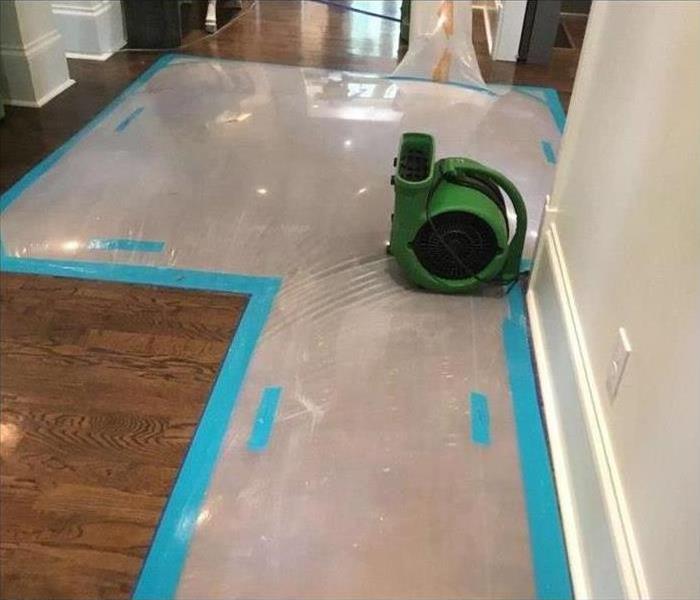 Drying process in a Murfreesboro, TN home
Drying process in a Murfreesboro, TN home
Water Cleanup Process
If your Murfreesboro, TN, home experiences water damage, it is important to act quickly to prevent mold growth. The following steps outline the water cleanup process. These steps apply regardless of the source of the water.
1. Make sure it is safe to begin work. Water and electricity can be a dangerous combination. Make sure the power is off in all the affected areas. If you cannot do this yourself, call an electrician.
2. Document the damage. Before you begin repairs, be sure to take photo or video evidence of the damage. This will help the insurance company properly compensate you for the loss. Call your agent and ask if there are any special instructions regarding documentation.
3. Dry the property. Because standing water can lead to mold growth within 24 hours, it is important to complete this step as quickly as possible. You can use specialized pumps and vacuums to extract the water. If necessary, you can also use buckets to scoop out the water. After the standing water has been removed, there will still be moisture left in porous surfaces. Dehumidifiers and fans can speed the drying process for these items. If the humidity outdoors is low enough, you can also open windows and doors to increase airflow.
4. Clean the affected areas. Depending on the source of the water, it may be contaminated with bacteria. Fortunately, there are many cleaning products on the market today. Choose one appropriate for the surface and contamination level you are dealing with.
5. Repair and replace damaged items. Everything that cannot be fully cleaned and dried should be thrown away to prevent contamination, mold growth, etc. Other items may be restorable. Delicate items, including electronics and antiques, will likely need professional restoration. Depending on their skill level, homeowners may be able to complete some of the other repairs.
The water damage restoration process can be overwhelming, especially if it has led to mold growth. If you need help getting your home back to normal, a certified restoration service can do the job quickly and safely.
2 Ways to Safely Dry Wet Documents
10/14/2020 (Permalink)
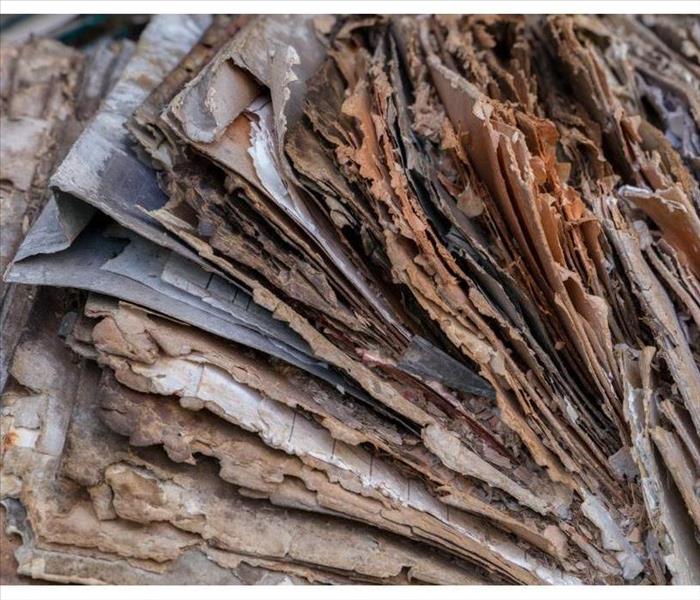 Documents damaged by water
Documents damaged by water
Methods You Can Use To Restore Wet Documents
There are a lot of tasks to keep track of when attempting to restore your commercial building in Murfreesboro, TN, after a flood. Attempting to salvage wet documents after the incident can be frustrating, especially if you neglected to make backup copies. Luckily, there are multiple methods that you can use to restore important papers:
Air Drying Documents
Using this natural document drying method is ideal if you only have a small amount of papers that need to be restored:
- Spread your wet papers out on a flat surface where they'll be able to sit undisturbed for a few hours. Make sure the area you select is in a room with adequate air circulation.
- Gently dab the wet documents with a towel.
- This can help soak up excess moisture, ultimately aiding the drying process.
- Set up an oscillating fan to aid with air circulation.
- Once your papers have dried a bit, weigh them down with a sturdy object, such as a book, to help prevent the edges of the paper from curling.
Freeze Drying Documents
You should use this method if you have 200 or more separate documents to salvage after severe flooding:
- As soon as you notice the water damage, wrap the papers in a ziplock bag. Do not try to separate any pages that are clearly soaked.
- Place the ziplock bag in the freezer. Leave the papers alone for several hours to allow them to freeze completely.
- Remove the bag from the freezer and take the papers out. Repeat the steps from the previous method to air dry the documents.
Wet documents can cause problems for your commercial business, especially if you don't have any backup copies. The above methods can certainly help salvage these important documents after a flood. If these tactics are unsuccessful for any reason, you need to contact flood remediation experts as soon as you can for additional help.
3 Steps to Ward off Mold in the Wake of Water Damage
9/30/2020 (Permalink)
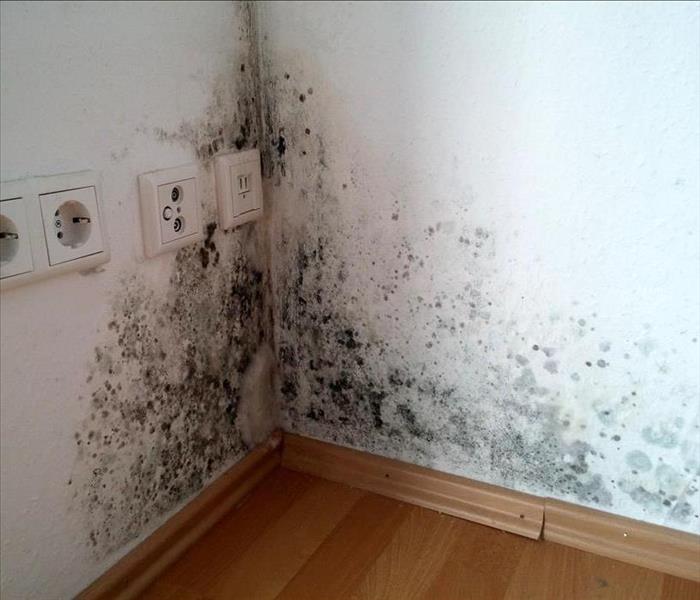 Mold damage in Blackman, TN
Mold damage in Blackman, TN
Three Simple Mold Prevention Steps
Has your Blackman, TN, home been flooded, or has a pipe burst? The water damage you're facing now might feel overwhelming, but if you don't take these crucial precautions, you'll have the nightmare of mold growth on your hands soon enough. Mold is a nasty fungus that requires professional mold expertise to remove and can grow on almost any moist surface, including:
- Ceilings and walls
- Wooden floors
- Carpeting and rugs
- Curtains
- Upholstery
You'll be thanking yourself later for taking these three simple mold prevention steps.
1. Sop Up the Water
This one might seem like a no-brainer, but you'd be surprised how often homeowners waste precious time before cleaning up the flooded area. The first step in mold prevention is to collect all the surface water, using mops, rags, and if possible, a wet vacuum. If you let the water stand, mold is almost certain to crop up in the surrounding areas on top of the worsened water damage.
2. Dehumidify for Days
No mop or wet vacuum can sop up every bit of water, as it's sure to have sunk deeper into the nooks and crannies of the surface. As soon as the surface water is taken care of, crank up your heat or AC and set up a dehumidifier. If you're worried about whether these measures are doing the job, pop over to your local home goods store and purchase a humidity meter.
3. Ask for Help
From here, you may feel safe from mold, but this is a dangerous misconception. Sometimes mold is only identifiable through professional analysis, especially in the early stages. If you can catch the mold growth before it's even spread far enough for you to see it, your mold remediation process will be a piece of cake!
Water damage is a disaster on its own, so don't let it evolve into a mold growth as well.
3 Important Tips for Smoke Alarm Maintenance
9/18/2020 (Permalink)
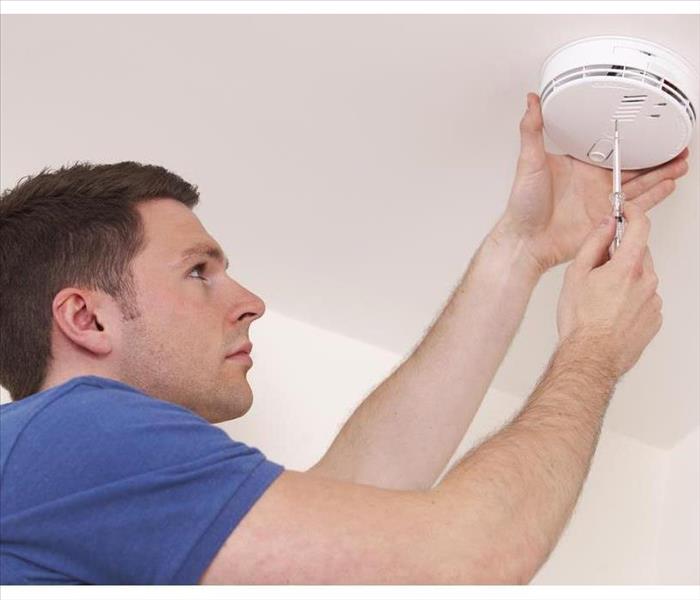 Smoke alarm maintenance in a Walterhill, TN
Smoke alarm maintenance in a Walterhill, TN
Smoke Alarm Maintenance
When you have a smoke alarm in your Walterhill, TN, home, it’s important to properly maintain the unit. A functional alarm helps you prevent large-scale damage by alerting you to the danger of a house fire in time to call the fire department. Afterward, a local fire restoration service can help with repairs. Here are three important tips for maintaining any alarms located in your home.
1. Regularly Change the Batteries
One way to help keep your smoke detector working so that it can alert you in time to avoid fire damage is to replace the batteries regularly. This should be done at least once a year. Most people choose an easy day to remember, such as daylight savings, on which to change their alarm batteries and inspect the unit.
2. Keep the Unit Clean
Keeping your smoke alarm clean can also help it retain its functionality. In many cases, you can clean the unit at the same time you change the batteries. A damp cloth can be used to carefully wipe off the outside, while compressed air can be used to clean the inside. This is also a good time to check if the unit may need to be replaced.
3. Replace Old Models
If your smoke detector looks to be in poor repair or if it has been in service longer than the recommended usage date, then it’s important to replace the alarm as quickly as possible. On average the lifespan of these devices is around eight years. However, if you experience problems with anyone in your home, it’s a good idea to choose a new unit as well.
Maintaining a smoke alarm by changing the batteries, cleaning it, and replacing it when it is expired is an important part of protecting your home against a fire. A little maintenance now can prevent a disaster in the future.
How To Run Your Business During a Power Outage
9/9/2020 (Permalink)
 Look for a Wi-fi connection you and your employees can connect to
Look for a Wi-fi connection you and your employees can connect to
Strategies To Keep Your Business Running During A Power Outage
Modern technology provides amazing tools for your Lascassas, TN, business. Yet because you rely so much on electronics, a major storm could be devastating. Heavy rains may cause flood damage to important appliances and devices. Meanwhile, lighting and strong wind could lead to a power outage.
Still, there are ways to overcome these obstacles. Storm cleanup specialists can dry off your property and restore your company's assets. You can even continue running your business while the power is out. Just follow the below suggestions.
1. Take Advantage of Data Packages
While electricians work to restore power in your building, you can access the internet on your phone or mobile device. Your tablet or cell usually includes a data package that lets you send emails and perform other essential business functions without an internet connection.
You should thus utilize these devices until they run out of battery life. Avoid running games or apps that could drain the phone's battery.
2. Use Wi-Fi
Find a local coffee shop or convenience store that did not suffer a power outage. The business may have a Wi-Fi connection that you and your employees can use.
3. Work Offline
Not every work task requires electricity. Use the outage to fill out paperwork, brainstorm, or perform other jobs that can be done without a computer or internet.
If you find out that a storm is heading your way, you should also prepare for a potential outage. Purchase a portable generator that will keep the electricity working in your building. You should also install an uninterrupted power supply on each computer. This way, if the power does go out, you and your employees will have time to save any unsaved data before the device shuts down.
A heavy storm does not have to destroy your business. Flood cleanup experts can help you repair the physical damage to your property, including the electronics. You can also utilize the above strategies to keep your company running during a power outage.
Mold Standards and the 3 Institutions That Create Them
8/19/2020 (Permalink)
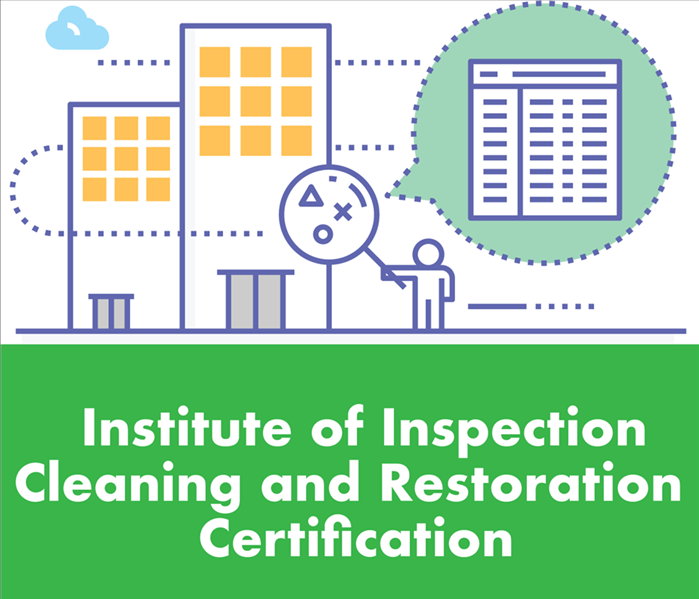 The IICRC is a nonprofit and recognized certifying body for the remediation and restoration industry
The IICRC is a nonprofit and recognized certifying body for the remediation and restoration industry
Mold Standards
When managing a commercial facility, you likely get used to complying with federal and state regulations, but that does not mean you are familiar with all rules, especially when it comes to disaster mitigation. Too many businesses and property owners assume that disaster cleanup, like mold clean up, is easy and not guided by governmental or professional bodies, but that is an incorrect assumption. There are mold standards, and there are at least three bodies that dictate the processes for removal and safety.
IICRC
OSHA
EPA
IICRC
The Institute of Inspection, Cleaning and Restoration is a nonprofit and recognized certifying body for the remediation and restoration industry. Before hiring any mold remediation company in Eagleville, TN, make sure they hold an IICRC certification. Having the IICRC seal means that the company is aware of the mold standards necessary for restoring your facility in the event of a black mold disaster, giving you the confidence to leave the restoration to that business.
OSHA
The Occupational Safety and Health Administration is a governmental body dedicated to the safety of American workers. OSHA likely has several rules regarding employees working around or near potentially hazardous materials. Therefore, instead of putting your workforce at risk, contact a remediation specialist who is trained in mold removal.
EPA
The Environmental Protection Agency is the federal institution responsible for regulating environmental safety standards for businesses, which includes the disposal of hazardous waste. You cannot merely bag up the mold and throw it in a garbage can. Instead of risking fines from the EPA, call a mold removal expert who is certified and licensed in the handling of the materials.
It is always tempting to save a buck, especially if your business is strapped for working capital. However, when dealing with mold remediation, it is better to call on a professional who understands mold standards, then risk violating OSHA or EPA regulations. Make sure that whoever you call has an IICRC certification.
The Important Step of Ridding a Home of Mold Odor
7/29/2020 (Permalink)
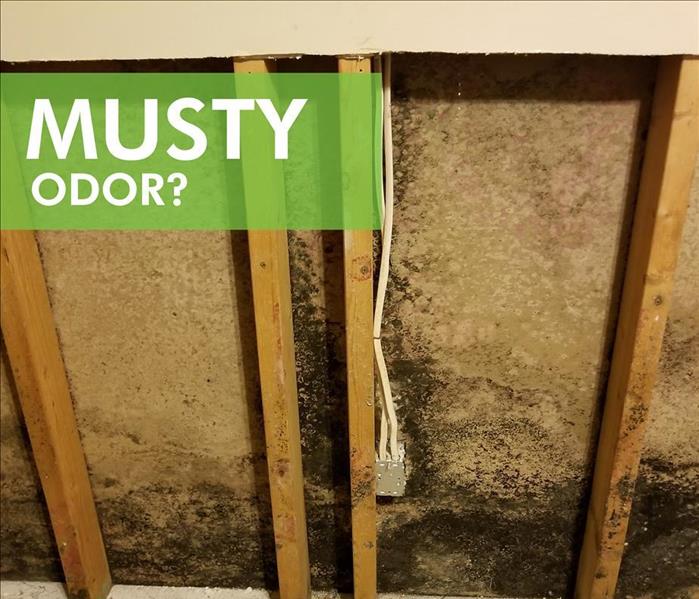 Mold produces an unpleasant odor
Mold produces an unpleasant odor
Mold in a home causes a number of problems for those living there. When mold forms into colonies it has a dark green or black appearance that often looks somewhat slimy or even fuzzy. Over time, the mold can break down materials and penetrate deeply into porous items such as clothing, carpeting, and curtains. It also produces a stale, unpleasant odor. The odor can come from a mycotoxin present in many types of mold. To rid a home of high levels of mold, a local mold mitigation franchise in La Vergne, TN, is the most effective route to take.
Treating the Musty Odor
Decreasing the high levels of mold in a home will also treat the odors associated with the fungus. This is done through a multiple-step program that can take several days to complete and which will also treat the mycotoxin levels as well. The main steps in the process are as follows:
- Inspection and assessment
- Testing
- Mold containment
- Air filtration
- Cleaning and sanitizing
- Restoration
Highly-trained and certified technicians follow the best practices set forth by the cleaning industry. An important part of any mold remediation job is finding and removing any excess moisture in a home. Rooms that register higher than 45 percent humidity are susceptible to mold growth. Microscopic mold spores are basically always present in most homes though at low levels.
Finishing the Remediation
Each job is different. Not all molds contain a mycotoxin. This depends on the type of mold and on the substance the mold is growing on. The longer the mold has been present and the more widespread the infestation is the more involved the restoration will be. Sometimes drywall needs to be removed and replaced with new materials. Other times a thorough cleaning and a fresh coat of paint will be satisfactory. The ultimate goal of mold cleanup is to mitigate mold damage, eliminate odors and restore a home to its original condition.
5 Steps To Take After a Fire
7/9/2020 (Permalink)
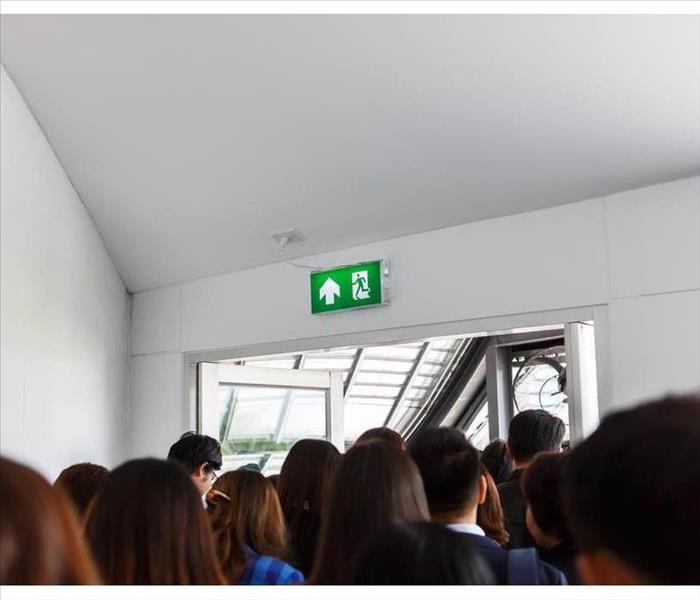 Evacuate the building safely
Evacuate the building safely
5 Steps To Take After a Fire
Fires can be frightening and disruptive to your business, but it is important to take the right fire restoration steps to get your business back to preloss condition quickly. Here are five steps to take after a fire.
1. Evacuate the Building
Even if the situation does not look immediately dangerous, fires can escalate quickly and there may be hidden dangers, such as toxic chemicals or smoke inhalation. Once everyone in the building has evacuated to a safe place, you can move on to the next step.
2. Call 9-1-1
Your priority after evacuating should be getting emergency services on the scene so that they can extinguish the fire and treat anyone who may have been injured. The best way to do this is to call 9-1-1. The 9-1-1 operator will be able to contact the fire department, police, ambulance, and any other Smyrna, TN, emergency services you may need.
3. Call Your Insurance Company
Before you can begin the fire restoration process, you will need to file a claim with your fire insurance company. You should contact your insurance company as soon as you safely can after a fire so that they can get the process of settling your claim started.
4. Stay Out of the Building
Structures that have been damaged by the fire may not be safe to enter until repairs have been made. You should wait until an inspection has been performed and you have been given the OK before returning to your fire-damaged building.
5. Clean and Repair Your Property
Even property that has not been damaged by flames may not be usable after a fire due to damage from smoke and water. A professional restoration company can assist you with smoke cleaning, water damage, and other fire cleanup services.
Recovering from a fire can be a traumatic experience. However, you can make the process easier by following the proper fire restoration steps after a loss occurs.
How To Replace a Leaking Toilet
6/15/2020 (Permalink)
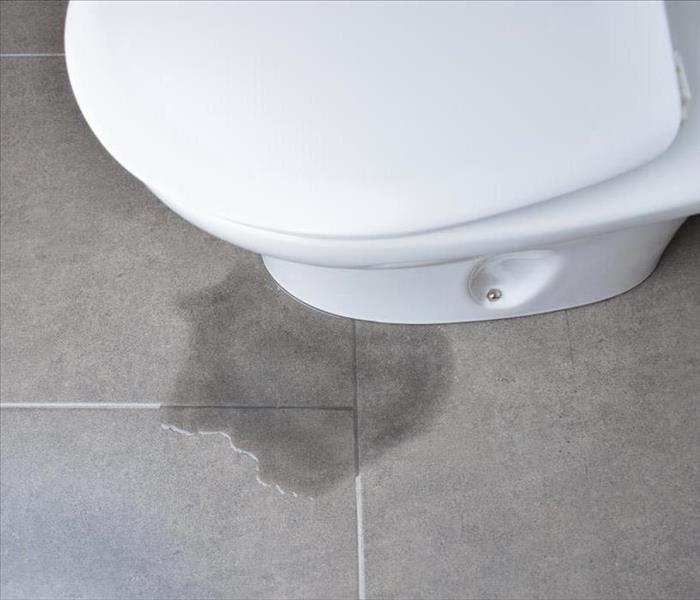 Leaking toilet in Murfreesboro, GA
Leaking toilet in Murfreesboro, GA
Several Types To Replace a Toilet
If you find a leaking toilet in your commercial restroom, you want to get it fixed as quickly as possible to avoid any further damage. Many things can cause a toilet to leak. Regardless of the cause, you may find that replacing a toilet is easier than you think. If you need a toilet repair in Murfreesboro, GA, there are several steps you can take to replace it.
1. Turn Off the Water
Be sure to turn off the shut off valve. It is usually located on the floor or wall behind the leaking toilet. If in doubt, you can turn off the water to the building. You need to drain and clean the water from the tank and bowl to avoid any spillover.
2. Remove the Toilet
By prying off the caps that cover the closet bolts and using a wrench to remove the hex nuts, you should be able to lift your old toilet off the ground. Be sure to place your hands around the bowl when lifting.
3. Clean the Area
Parts of the old wax gasket may still be attached to the closet flange. You may need to loosen the screws and install a repair strap underneath the closet flange. After tightening the screws, place the new wax gasket over the closet flange.
3. Install Your New Toilet
Connect the water supply to the bottom of the toilet tank and then center the toilet over the new gaskets. Press down on the toilet while tightening the closet bolts. You may need to repeat the pressing and tightening several times to get a secure fit. After replacing the caps, connect the supply tube and open the shutoff valve.
As a business owner with a leaking toilet, you may find that you have additional water damage or want someone to replace it for you. You can hire a professional water remediation company to clean, disinfect, and repair any water damage you may have sustained.
What To Do Before a Home Adjuster Visits
6/2/2020 (Permalink)
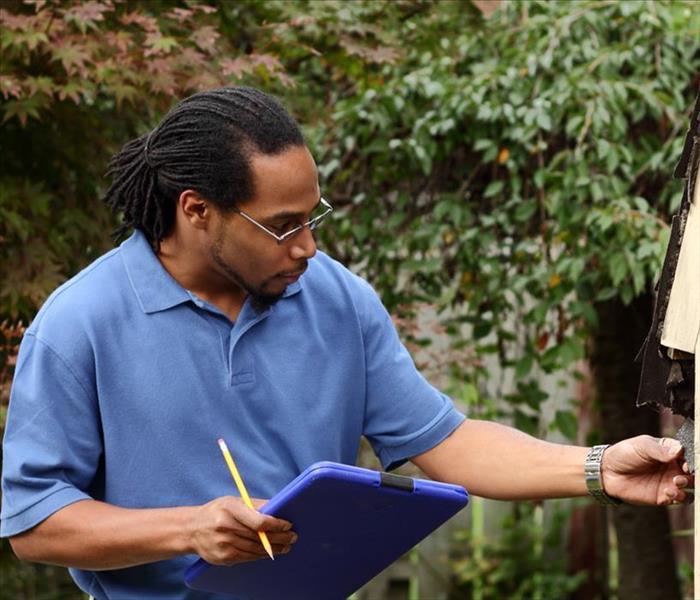 The home adjuster is going to verify that you need aid
The home adjuster is going to verify that you need aid
Consider the Following Three Tips To Help Prepare For The Experience
Water damage is no laughing matter. Whether a broken pipe or overflow, your residence in Murfreesboro, TN, is now greatly impacted, interfering with your everyday life. During this stressful time, chances are you may turn to your insurance agency for financial assistance, filing a claim to alleviate rebuilding and cleaning costs. Part of this process means a home adjuster visit. While this may seem intimidating, don't let it ruffle your feathers. Instead, consider the following three tips to help prepare for the experience.
1. Take Picture or Video
Documentation is extremely important when creating your insurance claim. It's the proof that often validates why you need the money and how it's spent. Go through your old videos and photos. Look for images that clearly illustrate the impacted room and your belongings. This shows the good condition before the incident. Then, snap additional images for comparison. The contrast should indicate the severity of the problem as well as the need to replace or repair. Keep these handy for the visit, in case the adjuster has questions.
2. Survey the Property
The home adjuster is going to walk the premises; however, you should also do this prior to the appointment. With a clipboard in hand, make a note of anything you think is suspect. Write out changes or concerns, and be prepared to share it as you walk through the officially scheduled time. Keep an inventory of items destroyed or affected.
3. Get Estimates
Don't hesitate to provide alternate estimates with the insurance claim. The adjuster determines one projection, but this could be quick and without looking at certain areas such as the roof or electric. Arrange to have a water restoration company come out and offer you quotes, providing their opinion about any further complications. Provide these write-ups and assessments so that these may be considered as well.
The home adjuster is going to verify that you need aid. Be ready with evidence and knowledge to back up your claim.
3 Candle Alternatives To Use in Your Home
6/2/2020 (Permalink)
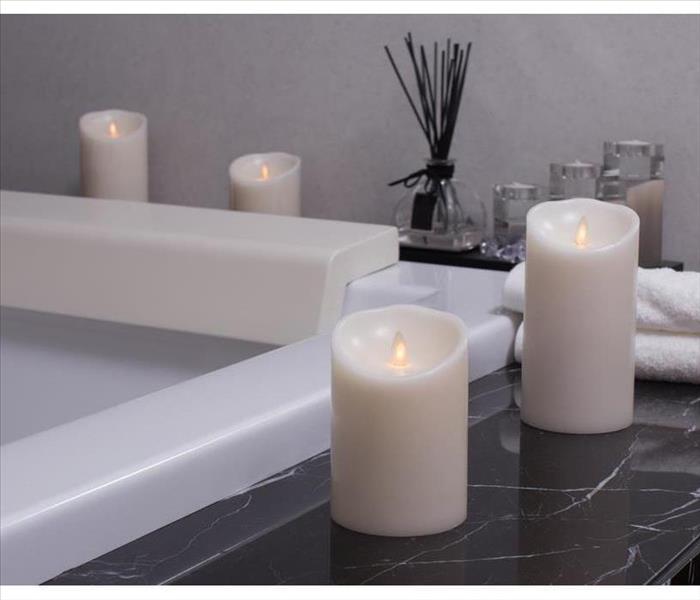 If you want the true candle experience, your best option is a battery-operated flameless candle
If you want the true candle experience, your best option is a battery-operated flameless candle
Candle Alternatives
Candles can be an easy way to create an inviting or relaxing atmosphere in your Smyrna, TN, home. Unfortunately, these popular decorative items come with some risk. While you can certainly take steps to use them safely and reduce the likelihood of a fire, there are some candle alternatives that you can use as well.
1. Battery-Operated Candles
If you want the true candle experience, your best option is a battery-operated flameless candle. These are designed to look like traditional candles and often have flickering lights to mimic the appearance of the flame. Along with reducing the risk of fire, these items have the added benefit of lasting much longer than a real candle.
2. Warm Light Bulbs
If you are looking for candle alternatives that provide similar lighting to a candle, then try warm-colored light bulbs. These bulbs give off light that is more yellow than white, resulting in a softer appearance. It can help to create a more comfortable and cozy environment. You can purchase these bulbs for use in ceiling lights or lamps, depending on your preference.
3. Wax Melts, Oils or Diffusers
Another reason that candles are popular in the home is that they come in a variety of scents. Luckily, there are many candle alternatives that can effectively and safely fill your house with a beautiful fragrance. Electric wax and oil warmers use a tray over a small lightbulb to heat the product and spread the scent. Diffusers use water and essential oils to create a scented mist that fills the air.
While you may enjoy using candles, a candle fire can be devastating to your home. In some cases, it can spread quickly and cause large amounts of damage that require the services of a clean up and restoration company. Using alternative items in place of candles can help prevent disasters from happening and keep your home safe.
The Importance of Hiring a Certified Water Damage Expert
5/14/2020 (Permalink)
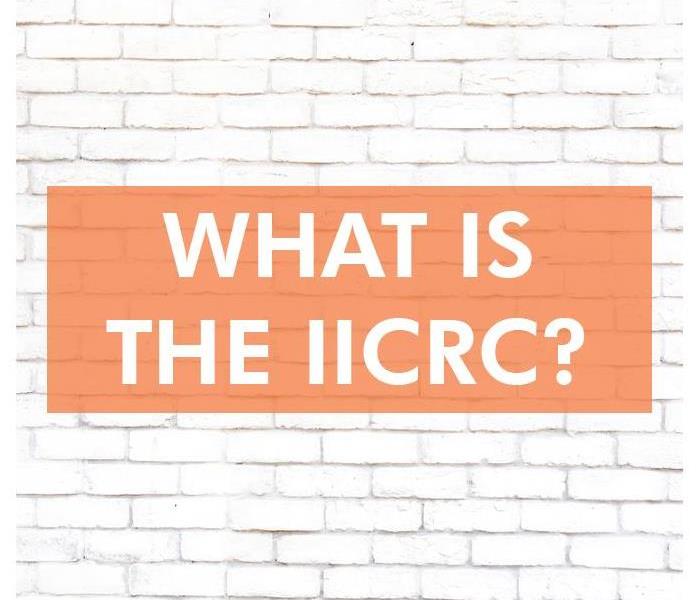 The IICRC is the acronym for the Institute of Inspection, Cleaning and Restoration Certification
The IICRC is the acronym for the Institute of Inspection, Cleaning and Restoration Certification
As a business owner, you have come to expect the unexpected. Sometimes, that can be in the form of a disaster. In Blackman, TN, disasters come in varying degrees and sizes and can involve different elements such as fire, water, and wind. When your disaster involves water clean up, it's important to understand who to go to for help with that cleanup.
Water disasters are a common occurrence. Anything from a toilet overflow to a broken pipe can leave you with a large pool of water in a matter of minutes. What's worse is when you are caught unaware of the situation and it sits for any length of time. In this situation, water clean up becomes a hazard. It's important to utilize a commercial drying specialist certified through the IICRC.
Who is the IICRC?
The IICRC is the acronym for the Institute of Inspection, Cleaning and Restoration Certification. This non-profit organization is the certifying body for the cleaning and restoration industry. The purpose of the IICRC is to ensure best practices during clean up and to develop industry-centric language and terminology for use among its experts.
Why Should I Hire a Certified Water Damage Expert?
The IICRC has experts who have determined the best and safest solution for performing industry-specific tasks, and this includes ensuring the least damage possible occurs to your property and fixtures. These practices prevent errors and speed up the process to you end up paying less. Hiring a commercial drying specialist certified through the IICRC ensures that specialist is proficient in the understanding of commercial structures.
Just like life, disasters will happen. When they involve hazardous or extensive clean up, it is always best to leave the task to certified specialists knowledgeable in industry best practices. A water clean up can be stressful, but knowing it was done right can bring peace of mind.
Commercial Insurance Coverage for Mold Damages
5/14/2020 (Permalink)
 Make sure you understand your commercial insurance coverage before you find mold
Make sure you understand your commercial insurance coverage before you find mold
Commercial Insurance Coverage for Mold Damages
Property owners' commercial insurance policies may have vague or complicated wording when they describe the coverage of mold damage. This being the case, it's sometimes difficult to understand when damage is covered by mold insurance and when it isn't. However, there are some general guidelines that may simplify the issue:
- Damage due to aging and wear and tear is usually not covered.
- When mold is the result of a covered type of damage, mold may be covered.
- Sudden damages, such as fire, may cause mold that your insurance will cover.
Most of the time, mold removal is covered when the source of the contamination is already covered by your commercial property owner's coverage. Sudden accidents may include burst pipes, overflows, fires, natural disasters, and so on.
Damages That Aren't Covered
If it's evident that you haven't kept up with maintenance and proper care for your building, related damages probably won't be covered. For example, if you notice drops of water gathering on a pipe, but you don't do anything about it, the resulting damages aren't covered by your commercial insurance. Regional flooding could lead to damages that aren't covered unless you've purchased flood insurance separately.
Coverage, Exclusions, and Exceptions
Commercial property and rental property insurance policies have several differences, so the best way to determine how much coverage you have available to pay mold cleanup and mitigation professionals is to talk with your insurance agent. Carefully read and understand your mold insurance policy, taking notice of terms such as "specified peril" and "exclusions." Some policies have long lists of exclusions, including corrosion and pollution. Sometimes, there are exceptions to exclusions.
Quick Action Prevents Spread
Ultimately, you need to take quick action when you discover mold damage. The best way to avoid further contamination is to hire Milton, TN, mold remediation professionals right away. Make sure you understand your commercial insurance coverage before you find mold.
5 Tips to Keep Your Sump Pump Running Like a Champ
5/1/2020 (Permalink)
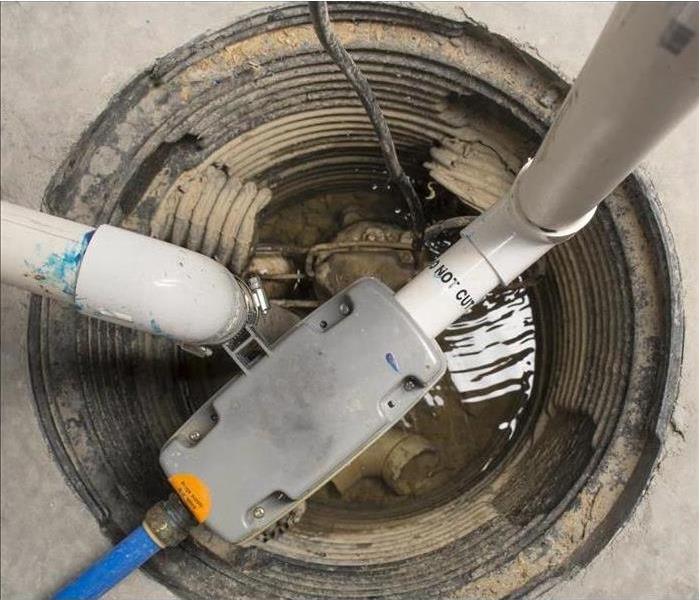 A working sump pump is essential for most basements in Walterhill, TN
A working sump pump is essential for most basements in Walterhill, TN
Five Basic Steps To Perform Pump Maintenance
A working sump pump is essential for most basements in Walterhill, TN. As part of the invisible infrastructure, it’s typically only noticed when it isn’t working right. However, they do require some maintenance to remain in service for a long time. When neglected, they have a nasty tendency to break down during the heaviest needs, leaving you with a potential disaster.
There are five basic steps to performing pump maintenance:
- Test the ground fault circuit interrupter (GFCI).
- Test the backup battery.
- Test the trigger mechanism.
- Clean the pump screen and inspect for objects blocking inlet or discharge.
- Inspect the sump pit for debris.
Most Sump Pumps Are Wonderfully Simple Devices (Yet Perform a Vital Function)
In wet soil or in areas with a high water table, it’s natural for water to try to migrate into a basement. A sump pit is dug where the water would naturally accumulate and may have additional lines run to the pit to facilitate the flow of water. Once the water level reaches a certain point in the pit, the sump pump in the pit is designed to automatically turn on and shut off as needed.
Most Maintenance Is Simple
A GFCI circuit has a button labeled “test.” Press that button to see if it trips. If it does, reset it with the “reset” button; if not, you’ll need an electrician to repair it. The backup battery (if it has one) should also have a button to test it. You can also test the sump pump trigger by either manually (and carefully) lifting the float valve or pouring in enough water to actuate the pump.
Cleaning the screen and pit is relatively simple for those comfortable with basic machines. The pump should easily detach so you can inspect for blockage in the screen, hoses, or the pit itself. Simply remove the debris and reinsert the pump.
If you aren’t comfortable doing this (or if it’s not working right), you should call a local company used to working with water damage and pumps. They can help you deal with flood damage as well.
Best Methods for Restoring Items After a Fire
4/21/2020 (Permalink)
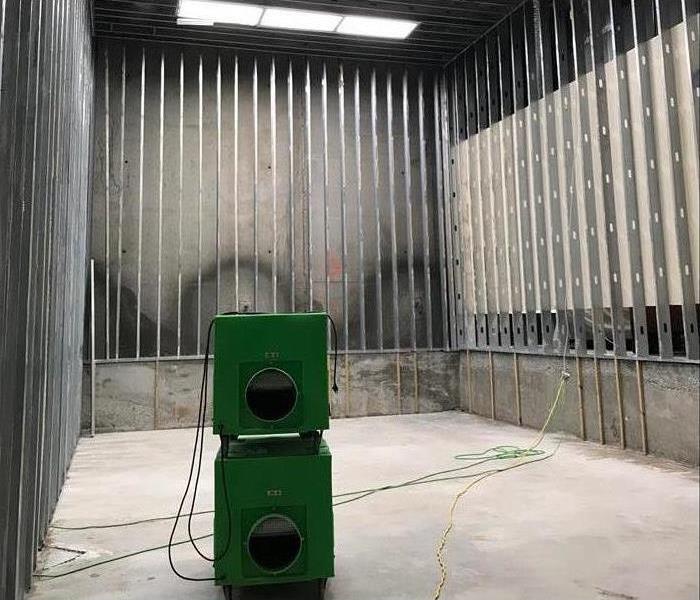 We have the equipment to handle any fire damage in Lascassas, TN
We have the equipment to handle any fire damage in Lascassas, TN
Best Methods for Restoring Items After a Fire
All items are usually not destroyed when a fire sweeps through a commercial building. In some areas, the flames burn hot and the fire loss is complete, but in other areas, many items survive the fire or can be restored to good condition. Part of the expertise of a storm mitigation company in Lascassas, TN, is determining what can be restored and what needs to be replaced. Pretesting methods allow technicians to identify likely candidates for cleaning. In many cases, it will be less expensive to restore than replace. Objects that only suffer smoke damage can often be cleaned sufficiently to reuse.
Partial Loss
For insurance purposes, there is a distinction between complete fire loss and partial loss. With a complete loss, the object in question is fully replaced and paid for in accordance with the policy. For partial loss, the claim usually pays for the restoration of the item. It pays to be aware of the following situations concerning a partial loss:
- Hidden damage such as mold, air ducts, and soot
- Improperly repaired items
- Delays in settling a claim
- Disputes over items that qualify for a partial loss
As with all insurance claims, documentation is always critical and can speed up the settlement of a claim. An experienced storm remediation company can help with this aspect of fire recovery by itemizing all work and expenses and sending this on to the insurance company.
Complete Recovery
No matter the size of a fire, a full recovery for a business is possible. Fire restoration services include water removal and extraction, soot and odor removal, cleaning and sanitizing and repair and replacement of damaged items. Fire loss can be a challenging time, but there are services that are Here to Help. Trained and certified technicians have seen it all before and know the best methods to clean the damages caused by a fire.
The Cost of Mold Damage and Removal
3/27/2020 (Permalink)
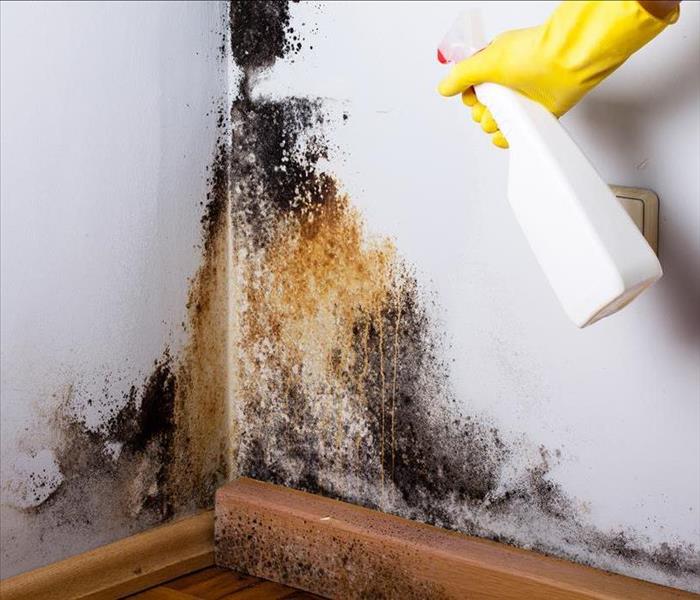 Mold removal in Eagleville, TN
Mold removal in Eagleville, TN
No homeowner in Eagleville, TN, wants to see mold on the premises. This can be a nightmare when it's time to sell or refinance. It's also unsettling to find no matter your living situation. It's nice to know that you can hire experienced technicians to handle the mold removal. Still, this will come at a cost to you, especially if your insurance doesn't cover the mold growth. Be prepared to know what you're up against.
Where You'll Usually Find Mold
Mold spores are in the air outside all around you, but if they make it into your home, mold can thrive under certain conditions. This growth occurs in humid, damp areas. Some of the most usual places to spot mold are:
- Basements, cellars, crawl spaces and attics
- Bathrooms, especially shower walls
- Under sinks and appliances where there has been water leakage
On the Low End
Mold removal costs can vary considerably depending on the extent of the damage and how long it has gone untreated. For a professional mold remediation company to remove a small patch of mold, you should expect to pay at least $500 or $15 to $20 a square foot. If you have damage to more than a couple of square feet, you should rely on the skills of a professional to handle it.
On the High End
If mold has infiltrated your home and covered widespread areas, you could be looking at thousands of dollars in damage. Black mold removal in extensive parts of the home could cost $5,000 or more.
What the Pros Do
A technician will inspect the area and evaluate what was damaged. Teams will tear out carpet, drywall and ceiling tiles, if necessary. Porous items may not be salvageable, but technicians can clean many places and items in your home with powerful chemicals and effective methods.
For mold removal, you can call a professional team to provide relief. Be ready for a possible significant financial commitment to get your home back in living condition.
Quick Commercial Storm Damage Cleanup
3/26/2020 (Permalink)
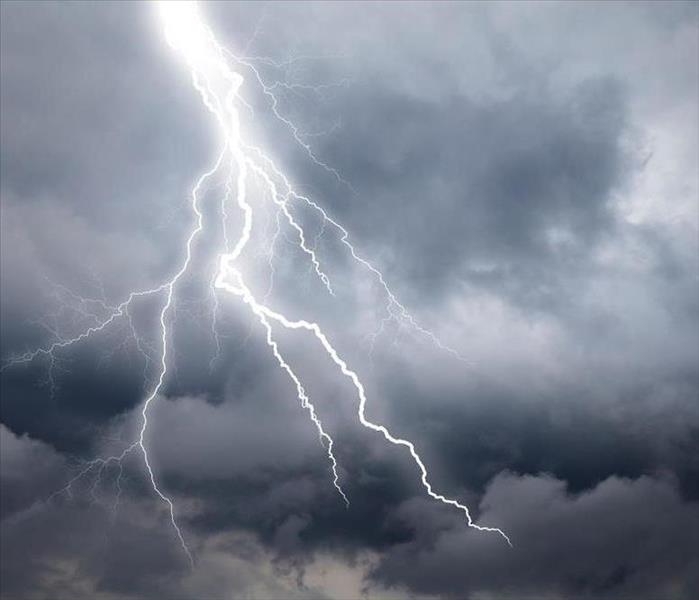 If a storm does damage to your property, give us a call.
If a storm does damage to your property, give us a call.
Just like any other building, commercial buildings are subject to the costly damages of Mother Nature’s wrath. Depending on your location and the season, losses can be caused by blizzards, hurricanes, earthquakes, and tornadoes. But one of the most common weather disasters is storms.
You can predict the storm, but cannot predict the extent of damage it will have on your commercial building. Flooding is often the biggest concern in this regard.
According to National Geographic, flooding accounts for more than $6 billion in damages every year. While typical floods may happen over days, flash floods can destroy properties in minutes.
The serious structural and cosmetic damage of your commercial building is more than just a headache to business owners – it’s a source of huge financial loss and an interruption to the normal operations of your business.
After a storm, you may want to replace everything and start from scratch. But this is not the best option as it is way too expensive, especially at such a time. Instead, you can try restoration.
Get the Right Commercial Storm Cleanup Services
A professional restoration company is able to handle all of your commercial damage cleanup and repairs. And since there is never a convenient time for flooding and storm damage, get a company that is available 24/7. Keep in mind that every hour wasted is an hour of lost productivity and revenue.
SERVPRO has the experience, training, and equipment to handle small and large commercial storm damage emergencies. Our technicians respond quickly to clean the mess and manage the restoration project from start to finish.
6 Main Stages of Our Commercial Storm Cleanup Services
This brief overview explains how SERVPRO experts may approach to resolve the storm damage at your commercial building:
- Examine the Damage: The restoration specialists will assess the extent of the damage and discuss the results with you and your insurer.
- Prevent Secondary Damage: This step involves boarding and tarp up services which prevent secondary water damages.
- Remove the Standing Water: With industry-leading vacuums and pumps, our restorers will be able to completely remove the water from the affected areas.
- Remove Damaged Building Materials: Damaged materials should be carefully removed and properly disposed of prior to the cleaning process.
- Clean and Disinfect the Surfaces: Our technicians will use customized cleaners to disinfect the affected surfaces as well as restore salvageable items.
- Dry the Building: Commercial air movers and dehumidifiers will facilitate the drying process and prevent the growth of mold and mildew on surfaces. Building materials are replaced after the affected areas are completely dry.
- Repaint and Add Final Touches: When walls are exposed to excess moisture for a few hours, they absorb water, and this may cause the paint to flake. When the walls are completely dry, our experts will repaint them for a dazzling finish.
What Next After the Commercial Storm Damage Cleanup?
As a property manager, a disaster preparedness plan will go a long way toward addressing your flooding concerns. You cannot stop the storm, but you can take the necessary actions to keep your building from another water-related disaster.
After the cleanup, consider the following preventive measures:
Flood-Proof Your Building
If flooding has been a problem in the past, consider flood-proofing your commercial building. This will prevent water-related damages in the future. One of the best practices is covering your building with a waterproof coating to keep water from seeping in.
Improve Your Landscaping
If possible, try to elevate the area around your commercial building before the rains begin. You can also build a system that will allow water to flow away from the building. Don’t forget to install downspouts to direct water away from the foundation.
The cost of this project will depend on the size of your building. Nonetheless, this cost will be far less expensive than the cost of repairing the damage.
Pay Special Attention to Basements
After a storm, the basement and foundation of your building may face serious damage.
It’s recommended to contact a specialist who will patch the foundation walls and caulk huge cracks. Moreover, you should consider installing a sump pump and dehumidifiers to keep the building dry always.
SERVPRO Will Be With You All Through the Commercial Storm Damage Cleanup
In the unfortunate event your commercial building is damaged by a storm, then do not hesitate to call SERVPRO in Smyrna, Rutherford County, for help. We will not only restore your property, but we will also help you review and make recommendations to safeguard your building from future storm damage.
What to Expect from the Commercial Fire Restoration Process
3/26/2020 (Permalink)
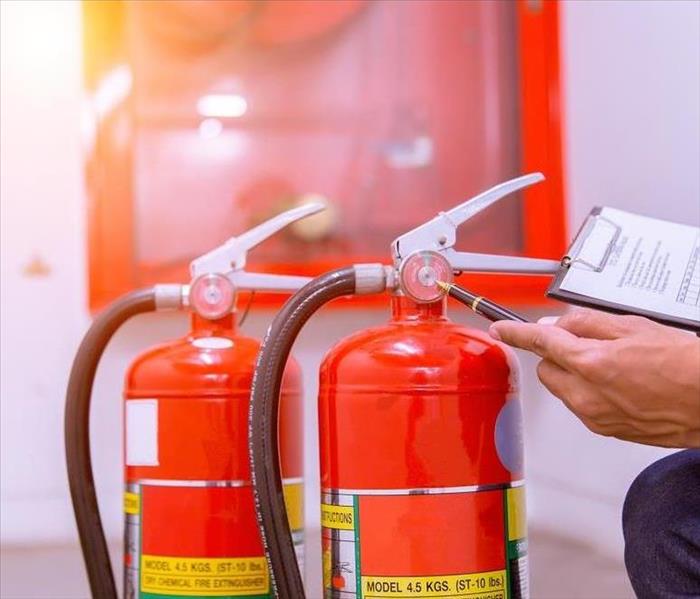 What to expect from a fire restoration
What to expect from a fire restoration
A building fire can be a scary experience. Even after the flames are put out and the danger has passed, the aftermath can be a confusing time. You may not know what to do about your burned commercial property or what to expect during cleanup and restoration.
After the fire is put out by emergency responders, you should call a professional fire damage restoration company. These experts will walk you through the process of assessing damage and beginning the big task of restoring the site. Along the way you should feel free to ask questions, but here are the basic steps of the process so you know what to expect up front.
Step 1: Assessment
The restoration company you hire will first assess the extent of the fire damage your property has suffered. They’ll look at heat, soot, and smoke damage to all structures and furnishings to see how far the fire reached and how badly it affected all materials it touched. With this information, the company will devise a plan of action and be able to give you an accurate quote for how much the restoration job will cost as well as a reasonable timeline for getting the job done.
Step 2: Preventing further damage
Before cleanup and restoration can begin, the main priority will be to prevent further damage to your property. Damage from the fire might have exposed building interiors to the elements, putting you at risk for further damage from the weather or wildlife. The restoration company can put up tarps and other protective measures to keep the elements out for the most part.
Keeping vandals and looters out of the site might also be a concern. A professional restoration company should have methods for this, such as securing doors and windows or even hiring a security company to monitor the site.
Other safety measures might be shutting off all utilities to the site if that hasn’t been done already and disabling the possible cause of the fire. For instance, if faulty wiring is thought to be the cause of the fire, electricity should be shut off to prevent another fire from happening again before new wiring can be installed.
Step 3: Cleaning up
Finally cleanup can begin. This step may seem like a whole process in and of itself. Water from the fire department or damaged plumbing will be pumped away. Charred and broken debris will be removed. Soot will be washed away and surfaces scrubbed. Damaged furnishings will be disposed of for you. Interiors and undamaged surfaces and furnishings will be deodorized to get rid of the smell of smoke. Dirt and dust will be swept up. Soon your property will begin looking like itself again.
Step 4: Renovation
Once the site is cleaned up, repairs can begin. If there was structural damage done to your building, it will need to be renovated to be functional again. Interior surfaces and fixtures that were too damaged to be cleaned will be replaced. New furnishings will be bought. Utilities will be turned back on. You can choose to match the previous look of the property as much as possible or take this opportunity to make some updates and have a fresh start.
Step 5: Prevention
Finally, the nightmare is over! All repairs and cleanup are completed and your property is ready for business again. But not so fast. The final step may be a consultation with the restoration company to discuss how to prevent future fires. This kind of meeting might depend on the cause of the fire and the company you hired, but if the fire had been preventable they may offer some ideas for avoiding a repeat situation such as placing smoke detectors and fire extinguishers in better places.
Your fire restoration team is here for you
You might be feeling overwhelmed after a commercial property fire, but hiring a great restoration company will set you on the right track. At SERVPRO of Rutherford County, our trained fire restoration technicians have you covered. With our 24-hour emergency service, we can get to your business quickly and begin immediate cleanup and restoration. No matter the size of your disaster, our goal is to restore your property and get your business back to functioning as quickly as possible.
Storm Damage Cleanup Made Easier
3/25/2020 (Permalink)
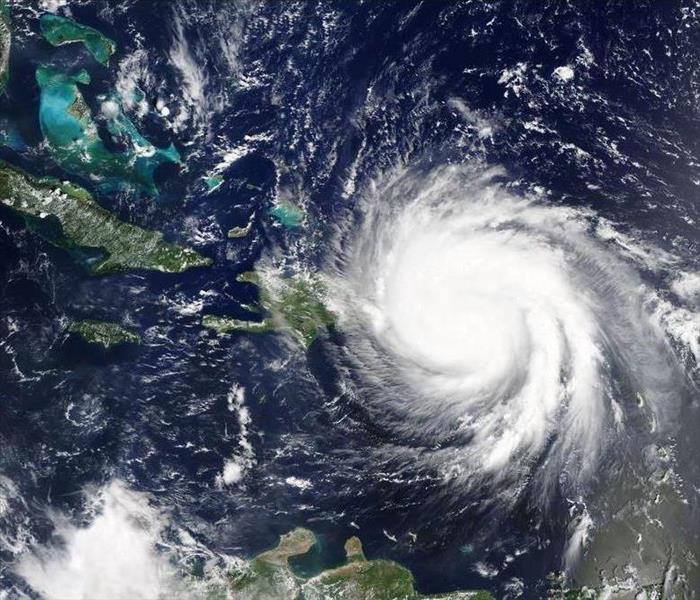 We can handle any sized storm loss
We can handle any sized storm loss
It’s hurricane season once again! This season always comes with storms and flash floods that can destroy massive amounts of property, both outside and inside homes.
If your home has ever flooded, then you understand how stressful and challenging the cleanup process can be. From ruined electronics to soaked carpets, water damage is a headache to homeowners.
If you want to take on smaller and safer tasks before help arrives, make sure that you are protected. The Environmental Protection Agency (EPA) recommends that you wear boots, long pants, a long shirt, gloves, and an N-95 respirator to protect against mold spores.
Unfortunately, the flooding experienced from a storm is a far too serious matter to handle alone.
Here’s Why Storm Damage Cleanup is Not for Everyone
Flood waters can destroy your home in the following ways:
- HVAC: When water enters the internal components of air conditioners and heaters, it damages its electrical systems. The venting system can also be contaminated by mold, and it may require professional cleaning to prevent mold spores from being blown through the air.
- Home Appliances: Flood waters can short out these appliances and make them leak harmful gases into the air. They need to be repaired and cleaned by a professional before use.
- Electrical Wiring and Pipes: Storms can strip electrical wiring and break water pipes. Work with a contractor if you notice these damages. For safety purposes, do not try to repair the problem yourself.
- Painted Concrete: Concrete walls flake when exposed to excess moisture and may require repainting. Concrete floors, on the other hand, are quite absorbent and will develop whitish deposits when exposed to moisture. Restorers should use HEPA vacuuming and EPA-registered disinfectants to get rid of these deposits.
- Floor Coverings: Most carpets are usually thrown out after they are damaged by standing water. However, a professional cleaner is able to restore your valuable carpets. Just remember to remove the soaked carpets from the flooded house as soon as possible to minimize the damage.
- Furniture and Other Wooden Items: Solid wood items may weaken, warp, and crack following a flood. Fortunately, they can be saved when dried properly.
- Insulation: Insulation foam sheets that have been affected by flood water need to be hosed off and dried. However, cellulose insulation made of treated paper needs to be replaced and removed.
- Plaster: Even though this thick material may not be replaced, it may take a really long time to dry. Professional storm damage cleanup companies have the necessary equipment to dry plaster quickly and more efficiently.
- Drywall and Wallboard: These are porous materials that become very fragile when wet. If they are not dried out properly, they can get contaminated.
Hiring a Storm Damage Cleanup Professional
Cleaning up after a storm is a dangerous task, and should largely be left to professionals.
SERVPRO may be in a position to help you during this difficult time. We are a locally-based storm damage cleanup company in Murfreesboro of Rutherford County. Our highly skilled experts have access to industry-leading equipment to quickly reverse the effects of water damage.
Restoration is better and far less expensive than replacement.
Before the cleanup process begins, the experts will examine the extent of the damage outside and inside your home. The results will be discussed with you and your insurer.
The type of damage present will determine the types of restoration equipment and tools needed. In the case of flooding, specialized vacuums and pumps will be used to remove water from the affected areas.
When drying your house, there are four main considerations that come to play – temperature, humidity, air movement, and the amount of water present. Drying occurs faster under low humidity levels and high temperatures.
Moreover, the damp air in the water-damaged rooms should be replaced by dry air to hasten the drying. Commercial air movers and dehumidifiers can facilitate the drying process and prevent the growth of mold and mildew on surfaces.
Our specialists will also use customized cleaners to disinfect the surfaces as well as restore salvageable items. Minor house repairs will be done and air fresheners will be used to combat the damp odor of a flooded home. Your house will be restored to its pre-storm state in no time!
SERVPRO is Available 24/7 for Professional Storm Damage Cleanup Services
Natural disasters like storms come without warning and they can flood and damage your property. But if you act fast, SERVPRO of Rutherford County can restore your home. Call us today!
How to Prevent Fires During the Holidays
3/24/2020 (Permalink)
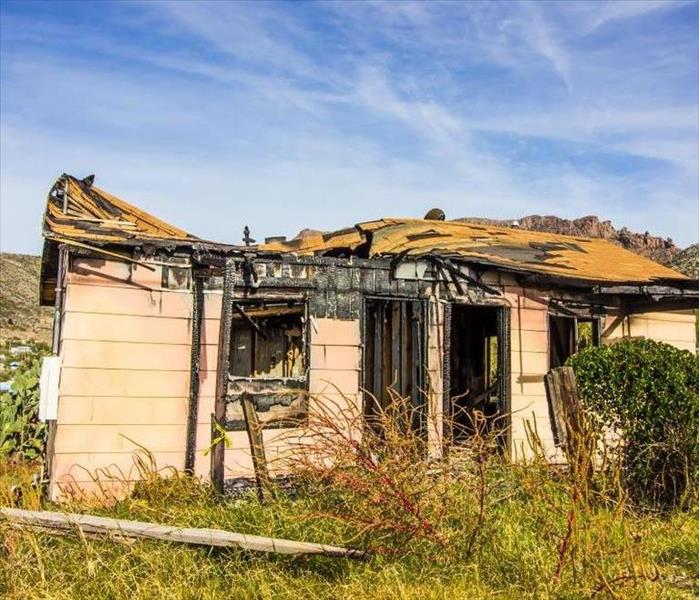 Be prepared in case you encounter a fire loss.
Be prepared in case you encounter a fire loss.
Scrumptious dinners, flickering lights, and making merry are all hallmarks of the holiday season. However, this is also the time when your home is at high risk of burning down.
According to the National Fire Protection Association (NFPA), more residential fires happen in the end-of-year period than any other time of the year.
For this reason, fire prevention and safety should be on top of your priority list this holiday season. To help stay safe during this wonderful time of the year, consider the following tips.
Fire Damage Prevention Tips from Restoration Experts
Before the season fully kicks in, have the following fire prevention tips in mind:
1. Pay Attention to Your Festive Decorations
While Christmas trees and decorations are part of the festivities, they are also one of the major causes of holiday fires.
When decorating your house, test all cords and lights to ensure they are working properly. This is especially important if the decorative lights have been in storage for a long time. Faulty products should be disposed of and replaced with new ones. Also, you’ll want to hang the lights with clips instead of nails to reduce the risk of damaging the cords.
Place your Christmas trees (and any other seasonal plants) several feet away from any heat source. Before going to bed or leaving the house, ensure you turn off the decorative lights on the tree. Also, it’s important to water the tree daily to prevent it from being brittle and dry. Dry trees catch fire easily.
And, when the festivities end, get rid of the tree as soon as possible. Don’t leave it to dry out in your garage or shed.
2. Take Cooking Safety Precautions
According to the U.S. Fire Administration, unattended cooking is the leading cause of residential fires. And it’s clear to see why. With all the chaotic holiday preparation, it’s easy to neglect the food cooking on your stoves and oven.
As a rule of thumb, stay in the kitchen until everything is out of the oven or stove. Also, make sure that you invest in fire extinguishers, smoke detectors, and fire sprinklers for your kitchen. If you are planning on deep-frying your holiday turkey, do it outdoors, on a flat surface at least 10 feet from the house.
3. Be Careful with Candles
Candle fires happen the most during the holiday season. To reduce the risk, set the candle several feet away from anything combustible. Also, set the candles on sturdy bases and cover them with hurricane globes.
Don’t leave a burning candle unattended, especially if you have kids and pets. Before going to bed, make sure all the candles are blown out.
If possible, consider other safer alternatives to candles like electric candles.
4. Don’t Forget About Matches and Lighters
An open flame is a serious fire risk when handled improperly. Keep matches, lighters, and other fire-starting materials away from kids. For guests who smoke, create a designated space outdoors where they can smoke and dispose of cigarette butts. It’s recommended to dampen cigarette butts before throwing them in the trash can.
5. Get Your Indoor and Outdoor Fireplaces Inspected
Have your chimney and fireplaces inspected by a professional before using it. This is especially important if you haven’t used them for months. Also, avoid using damp firewood on your fireplaces as they produce smoke which causes choking hazards.
If you are using space heaters to keep your house warm during the winter, make sure that they’re at least three feet away from items that can easily catch fire like clothing, beddings, furniture, and curtains. Unplug the appliance when you are done using it and don’t leave it unattended.
When using outdoor fireplaces, exercise caution. While gathering around the fire pit can be cozy, it can cause serious injuries if handled wrongly. Ensure that everybody is at least three feet from the fire, and other structures more than 10 feet. Be extra cautious during windy days as fire can quickly spread to unintended areas.
Call SERVPRO for Fire Damage Restoration
If you keep the tips in mind, you will be sure to enjoy your holidays with your family and friends without the fear of a fire disaster.
However, in the unfortunate event of fire damage in your home, you’ll need professionals to take care of the disaster. Doing it yourself is risky and time-consuming. At SERVPRO of Rutherford County, we have the right tools and equipment to handle any fire damage regardless of the size.
3 Steps for Reducing Water Damage After a Flood at Your Business
3/24/2020 (Permalink)
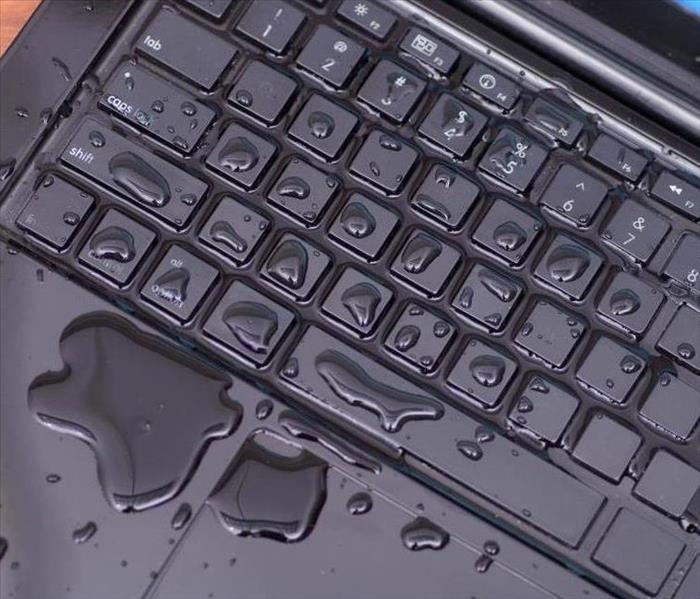 You can reduce water damage by being prepared
You can reduce water damage by being prepared
When your Murfreesboro, TN commercial building is damaged by flooding, it can be difficult to know where to begin with cleanup efforts. Waterlogged drywall, ruined carpeting and damaged machinery may only be a few issues you have to deal with. However, there are a few steps you can take to begin the recovery process, and knowing some helpful damage tips may give you peace of mind as you work to restore your business.
When your commercial building is damaged by flooding, it can be difficult to know where to begin with cleanup efforts. Waterlogged drywall, ruined carpeting and damaged machinery may only be a few issues you have to deal with. However, there are a few steps you can take to begin the recovery process, and knowing some helpful damage tips may give you peace of mind as you work to restore your business.
1. Reduce Humidity Levels
After a flood, the humidity levels in your building may spike due to increased water vapor in the air. This may accelerate mold growth, especially in the case of black mold. Because this type of fungus can spread quickly, it is wise to lower humidity any way you can. Open the windows, run fans and turn on your building’s air conditioner if you have been told it is safe to do so. These damage tips may help you keep the threat of mold at bay until help arrives.
2. Call for Professional Flood Mitigation
If a pipe burst in your employee restroom and caused a flood, you may believe there is no hurry in calling for cleanup because the damage has already been done. However, calling in a flood damage and restoration company as soon as you can may reduce the risk of long-term problems, such as mold growth and structural weakness. Flood technicians might also be able to prevent the spread of flood waters to other areas of your building and prevent them from reaching major systems, such as electrical fuse panels.
3. Sort and Set Aside Items for Restoration
Flood technicians may be able to offer you cleaning tips and restoration options for your inventory or office equipment. While not all items may be salvageable, having assistance during this process can help you feel more confident about recovery.
Facing a flood at your Murfreesboro, TN business can be a stressful experience. However, being aware of a few helpful damage tips can give you the peace of mind you need to begin cleanup and restoration efforts.
1. Reduce Humidity Levels
After a flood, the humidity levels in your building may spike due to increased water vapor in the air. This may accelerate mold growth, especially in the case of black mold. Because this type of fungus can spread quickly, it is wise to lower humidity any way you can. Open the windows, run fans and turn on your building’s air conditioner if you have been told it is safe to do so. These damage tips may help you keep the threat of mold at bay until help arrives.
2. Call for Professional Flood Mitigation
If a pipe burst in your employee restroom and caused a flood, you may believe there is no hurry in calling for cleanup because the damage has already been done. However, calling in a flood damage and restoration company as soon as you can may reduce the risk of long-term problems, such as mold growth and structural weakness. Flood technicians might also be able to prevent the spread of flood waters to other areas of your building and prevent them from reaching major systems, such as electrical fuse panels.
3. Sort and Set Aside Items for Restoration
Flood technicians may be able to offer you cleaning tips and restoration options for your inventory or office equipment. While not all items may be salvageable, having assistance during this process can help you feel more confident about recovery.
Facing a flood at your business can be a stressful experience. However, being aware of a few helpful damage tips can give you the peace of mind you need to begin cleanup and restoration efforts.
A Moldy Affair: Mold Remediation
3/23/2020 (Permalink)
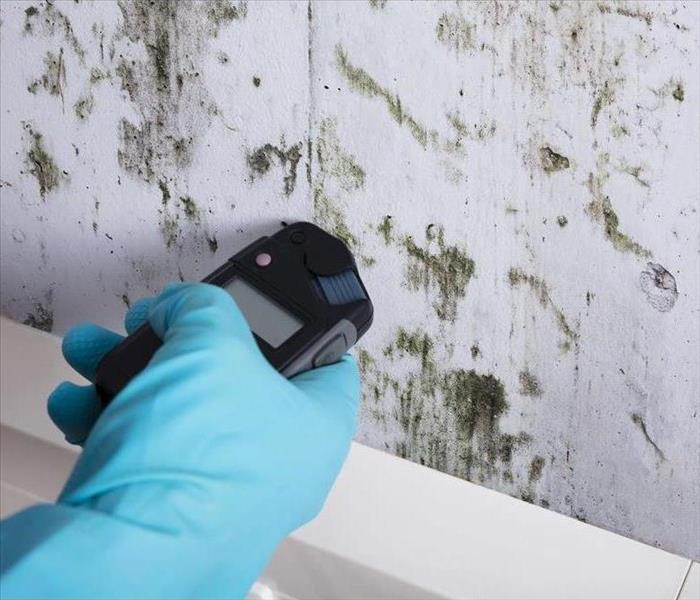 Mold can grow in as little as 48 hours after a water loss.
Mold can grow in as little as 48 hours after a water loss.
Keeping a functioning and safe home is no small task.
Whether your household is comprised of just you and Fido, or if it’s you, your spouse, your children and Fido – it’s still your home.
It’s safe to say that no matter what your home is like, it’s something special to you and your family.
You’ve put in a great deal of time picking out furniture, putting up pictures, and adding all those little details that represent your family.
The ultimate goal as a homeowner is to keep a safe, secure, and happy environment for everyone who enters your home.
However, mold is the uninvited houseguest you probably never anticipated.
Mold is a common issue which almost everyone will come across at some point during their life. Unfortunately, it’s something that can easily occur in your home and it can lead to some very costly repairs.
At SERVPRO, we’ve seen our share of mold related cases throughout our time servicing the community of Smyrna in Rutherford County.
Part of our professional charge is to make sure you know how mold occurs. With the right information, you can take action to prevent mold in your home. And, you’ll know what to do in the event that you’re in need of mold remediation.
Here’s a quick look into how mold can occur in your home and how it can be prevented.
Mold Loves Moisture and Warmth
Mold has got to be the common cold equivalent of issues facing homeowners.
It’s as easy to overlook as it is to facilitate its spread throughout your house. Additionally, it can be just as simple to prevent it.
There are many common causes of mold in homes that can be provoked with a variety of situations. Something as seemingly nonthreatening as a pipe leak can lead to large mold issues in the future.
Flooding and heavy rains can also cause anywhere from minimal to extensive water damage, which all can mark the beginnings of mold.
No matter what the scenario is, the causes of mold in homes will always have moisture involved. Mold occurs when unchecked moisture meets warm climates. This can be particularly troublesome during summer months or in humid climates where mold has the chance to thrive.
Mold eats through any organic material as long as conditions for its growth are present. This means that what could have been remedied by a simple call to a plumber results in mold spreading through your walls, carpet, and ceilings.
Leaky pipes are issues you can easily check for to prevent mold from ever starting to spread. But less known or hidden water damage can be much more difficult to catch. Be sure to check any spaces where you have appliances, to see if there are any leaks.
Also, if there has been any significant rainfall during a storm, it’s a good idea to check your home. Leaks through your roof are a prime area for mold growth given the combination of continued rainfall and summer heat.
Mold Remediation Services at SERVPRO
If mold has already taken root or spread throughout your home, there are services which can solve this. Mold remediation is a professional service where mold is cleaned and removed from your home.
While a mold problem is something you may initially notice on your own, it’s best to bring in a professional to make sure a full assessment is done on the situation.
A professional will uncover not only what the causes of the mold are, but they’ll also be able to discover how extensive the mold damage to your home actually is.
In addition to offering services to stop the source of the problem, mold remediation is the ideal solution for cases where mold has damaged your home. These services also include cleaning and removing the mold-compromised zones using special chemical applications and methods to make sure mold doesn’t return.
Keep Your Home Mold-Free
Keeping your home mold-free should be on your list of routine checkups.
As simple as a routine home check could have already prevented mold growth and extensive damage, but it’s one of those things that can be easily overlooked. Mold could be spreading in all the moist, dark corners of your basement that you rarely check.
In the event that mold and mold damage can get out of hand, SERVPRO is your local source for mold remediation services.
Commercial Mold Remediation: A Professional Touch
3/18/2020 (Permalink)
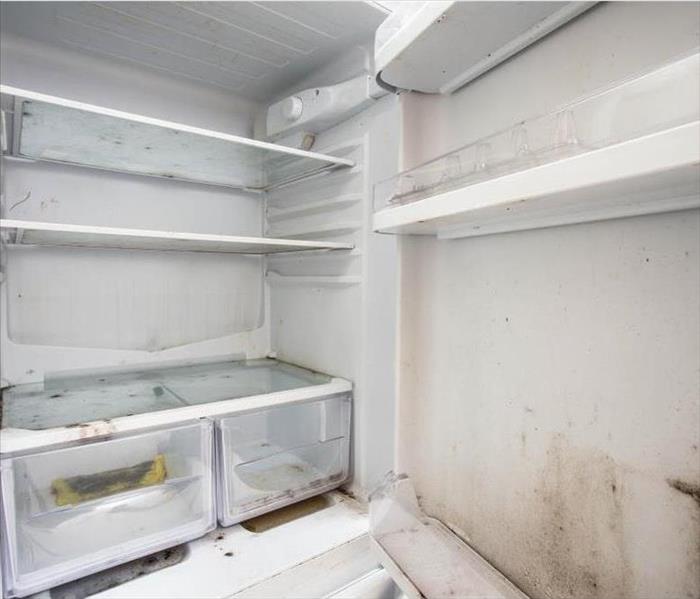 Mold can be extremely dangerous
Mold can be extremely dangerous
Brick and mortar storefronts are a staple of our economy, allowing for local customers to walk in the front door of a neighborhood business for goods or services.
There is great value in being able to have contact with a friendly face in an environment where you have confidence in the employees, and a general sense of trust that they have your best interests at heart.
As a business owner, you’re aware that there are many challenges to be tackled on a daily basis. The last thing you need is a problem to disrupt your work, especially in relation to your place of business.
A common workplace threat that falls under our area of expertise is the potential for mold growth in commercial spaces.
Perhaps you’re familiar with mold issues at home, but your business can be just as at risk. Understanding how to remedy this is important, not just to your customers, but to your livelihood as well.
Commercial mold remediation is a service that SERVPRO is happy to provide to the businesses in Murfreesboro, Rutherford County. It’s just as important for you to know what causes mold as it is to have professional input on any remediation needs.
In this blog, we’ll discuss both how mold growth begins, and also, how mold remediation services can combat potential damage.
How Exactly Does Mold Occur?
Mold growth happens when there is a perfect mixture of conditions – and unfortunately, it can happen far too easily.
All it takes is a combination of moisture, warmth, and in applicable situations, food – and you could have a serious mold issue in your hands.
Mold in your business will most likely occur in places like bathrooms, basements, kitchens, or anywhere else where there is some kind of moisture.
For example, if an unchecked pipe leak teams up with the summer heat, you could be in for an ugly surprise.
What is Mold Remediation?
Perhaps you’ve already seen mold in your place of business and that’s why you’re here.
Mold remediation is a key service which, when done professionally, can have your business mold-free in no time. This service basically involves cleaning, thorough removal, and mold treatment done throughout your building.
Mold tends to spread if its conditions for growth go untreated. In most extensive cases, mold can even grow quickly through multiple areas – including walls, carpets, and ceilings.
Commercial mold remediation will use special methods, chemicals, and cleaners to remove all mold present and to prevent it from returning.
A Mold Threat in Commercial Buildings
Mold is an issue that can threaten multiple parts of your business, so it’s important to know exactly how to approach it.
It’s vital to bring in a specialist to first asses your mold situation.
Mold is a natural organism which forms whenever the proper conditions are available. While you may initially only notice it in one spot, it’s very common to find that the small damage you’ve identified is just the beginning.
Examining the area with just your eyes may not show the more extensive growth which has spread throughout your building. A professional assessment will take a true account of the areas that have been affected and they will also let you know what needs to be removed or replaced.
A professional assessment will also investigate where the source of the mold is coming from. This is essential because replacing the walls and carpets could be a complete waste if you don’t find the source of the mold.
Getting commercial mold remediation for your business is a sure way to not only eradicate the current issue, but also, to take the proper steps so it doesn’t happen again.
Call the Professionals Every Time
Mold is one of those issues which, when it strikes, can become a huge inconvenience to you.
The most extreme cases can result in the walls and floors of your business needing to be removed and this could require you to close for a period of time.
Taking pride in serving communities, SERVPRO ensures that your mold remediation work is handled promptly and professionally.
If you’ve noticed any current mold issues, or if you have any general questions about how you can keep your business mold free, SERVPRO professionals are here to make sure your business is mold-free, so you can focus on doing what you love instead.
Mold Remediation: Top Signs and Causes of Mold Infestation in Homes
3/11/2020 (Permalink)
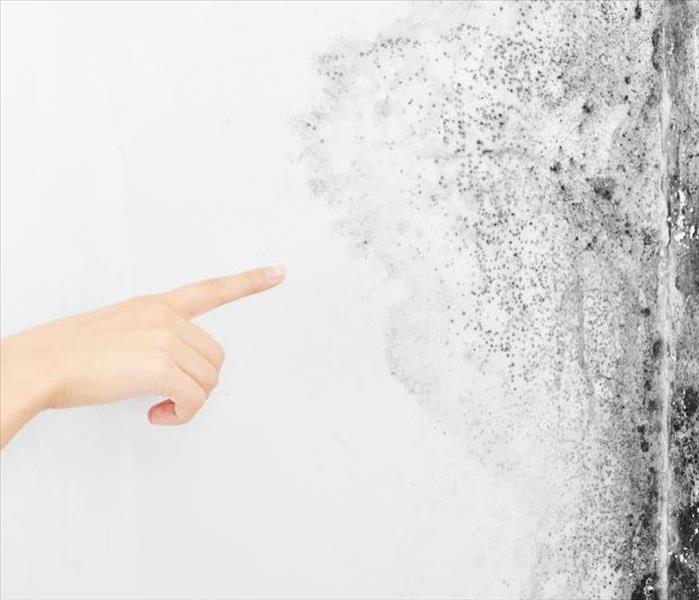 If you find mold, call us immediately.
If you find mold, call us immediately.
Mold growth is more common in homes located in flood-prone areas, but it can occur in any home. It looks unsightly, but can also cause major structural damage if left unattended for a long time.
The best way to deal with infestation of this annoying fungus is to be proactive. Being proactive here means you should know the signs and causes mold growth, so you can address the problem immediately and stop it in its tracks.
How to Tell if There is a Mold Problem in Your Home
If you notice any of the following signs in your home, you could be having a mold problem:
- Can you see colored, flat spots or fluffy patches forming on the walls, ceilings or floors of your dwelling?
- Do you notice a pungent or musty odor when you enter your house?
- Can you see water stains on your walls, ceilings, floors and other surfaces?
- Is the paint on the interior surfaces of your abode coming or peeling off?
- Do you have rusty water pipes in your abode?
If the answer to one or more of these questions is a resounding yes, you might have a mold problem in your home.
4 Common Causes of Mold Infestation in Homes
Mold thrives in areas that stay wet, and none will grow on surfaces without direct exposure to oxygen. Besides flooding, there are many other potential water or moisture sources that could encourage its growth within a home.
Continue reading on below to find out a few “typical” culprits behind mold growth and damage in homes.
1. Leaky Water Pipes
Every home requires a consistent supply of clean water for drinking, cooking, cleaning dirty dishes, bathing, doing laundry, and more. Surviving a day without running water is almost unimaginable.
The water connection to your abode comprises a series of water pipes that deliver water to the various faucets or points of use within the home.
When you have a dripping water pipe, you may experience a considerable decline in water pressure, depending on how big or small the leak is. But that is not the only thing that should worry you.
The water leakage may encourage mold infestation, especially if it’s hidden and goes unnoticed for a long time. Leaks that occur underneath sinks installed on bathroom vanities are a perfect example of leaks that may take time to detect.
Once you have called in an emergency plumber to stop the leakage, you should immediately contact a remediation specialist to inspect the affected area for mold growth and determine the extent of damage caused by the mold.
2. Leaky Roofs
Like dripping water pipes, leaky roofs are another common cause of mold damage. Mold growth from roof leaks typically happens during the rainy spell when rainwater runs off the rooftop.
The presence of water stains on your ceiling or interior walls is a tell-tale sign of a leak from above. A roof repair specialist can fix the leaks for you, but they may not have the expertise and experience required to inspect your roof and home for mold damage.
You will need to enlist the services of a water and mold damage professional to protect your family from mold exposure and growth in your home.
3. Hot Showers
Bathrooms are by design wet areas, but are you aware that those long, foggy hot showers you like taking every day could increase the risk of mold growth?
Hot showers cause moisture-heavy air, called condensation, to build up on your bathroom surfaces. This, in turn, encourages mold growth in your bathroom.
To minimize condensation and prevent this growth in your bathroom, you should consider leaving your bathroom windows open when taking hot showers.
When opened, your bathroom windows will allow excess moisture to exit the room to the outdoors. To facilitate quicker expulsion of excess moisture from your bathroom, you should consider installing a ventilator fan.
4. Drafty Doors and Windows
Doors and windows that leak out air are a leading source of energy inefficiency in homes, but they could also promote mold growth by leaking in water from outside when it rains.
Luckily, all you may need to do to remedy the problem is to replace the caulking or weather-stripping around the window.
If you suspect that your house has suffered mold damage, it is best to contact a remediation expert immediately. This will ensure prompt removal as well as prevention of further damage.
Contact SERVPRO for Help
Mold spreads fast, so any sign of growth requires prompt intervention. If you have an infestation in your Murfreesboro home, don’t hesitate to turn to the seasoned remediation specialists at SERVPRO for help.
Standard Renter’s Insurance Doesn’t Cover Floods
3/9/2020 (Permalink)
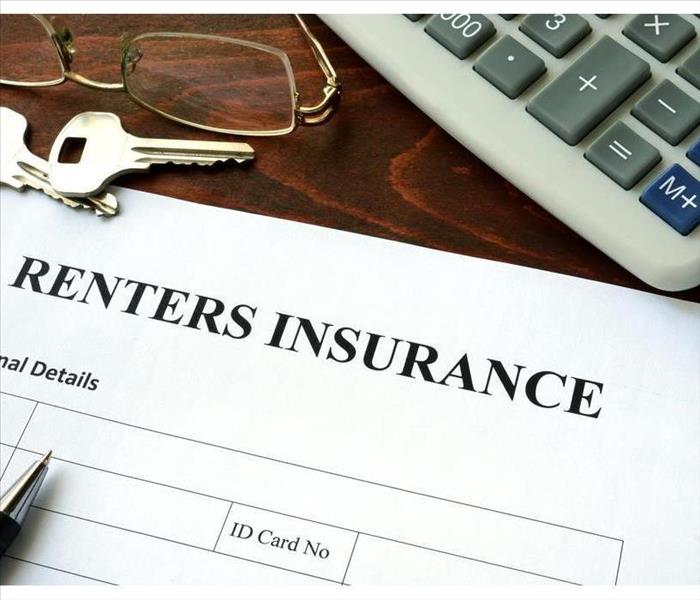 Having renter's insurance in Christiana, GA can certainly add to your peace of mind
Having renter's insurance in Christiana, GA can certainly add to your peace of mind
Standard Renter’s Insurance Doesn’t Cover Floods
Having renter's insurance in Christiana, GA can certainly add to your peace of mind. It’s nice to be covered in case of an incident, but you should be aware of the exclusions and deductibles your policy has.
A standard policy will usually cover most major types of loss, including
- Fire
- Theft
- Vandalism
- Storm damage
- Explosions
- Smoke damage
Each company will offer different coverage, premiums, and deductibles. For instance, a renter's insurance policy may – or may not – cover identity theft if your ID or credit cards were stolen from home. Most will cover liability if someone is injured on the premises, such as the infamous slip-and-fall lawsuit.
However, virtually no standard policy will cover flood damage. Some companies can offer riders that will cover floods, but they must be specifically asked for. Usually, the best rates are found through the National Flood Insurance Program (NFIP), but not in every case, so it’s best to shop around and check a few insurance companies.
Flood Insurance Isn’t Just for Homeowners
Homeowners who are allowed to build within the 100-year flood plain are often required to get flood insurance coverage if they have a mortgage. However, anyone who owns property in participating communities, including personal property, can get coverage through the NFIP.
In any case, if your home does suffer a loss, such as a flood, fire or theft, your landlord won’t be responsible for the damage to your personal property unless serious negligence is involved. Also, flood insurance may pay for the additional costs associated with a forced move, including hotel bills and getting into a new rental. Some coverage will even include items stolen from a vehicle parked at the rental. Each policy has different payout caps and deductibles, but it’s usually relatively easy to find a renter's insurance policy that matches your needs.
If you have a flood that impacts your rental in Christiana, GA, contact the property managers immediately. You’ll need a storm damage cleanup company to get there as soon as possible to tarp and board exposed areas – a key step to preventing further losses for you and your landlord.
We Can Restore Your Kitchen After Fire Damage!
2/28/2020 (Permalink)
 We can restore your kitchen after a fire
We can restore your kitchen after a fire
Kitchen fires in the home can be traumatic. A minor incident with simple smoke damages or a larger blaze can wreak havoc on a home. Once the flames are out, you're likely left with the smell of smoke throughout the home. Water damage from firefighting efforts and a lingering smell that reminds you of the incident can be hard to take. There are several steps to help remove the smell, damage, and negative impact inside your home. We'll help your family return to normal and you can enjoy your home once again.
Air Ducts
Many people don't realize that dust, allergens, and other materials circulate through the home via air ducts. Fire-related smells can remain in the ducts long after the flames are put out, leaving a smell of smoke in the entire home. Even with a small kitchen blaze, smoke rises up into the ducts and that smell proves difficult to remove. Professionals can check the entire duct system to see if cleaning them is necessary to regain clean air in your home.
Removing Evidence of Damages
Even the smallest flames can result in smoke damages in the home. You also have the after-effects of using water or fire extinguishers to put out the flames. Those techniques can leave marks that need removal too. Even if the flames were small and you were able to contain them without firefighters, it’s likely there are damages there to remind your family of the traumatic event. Water and fire-related damages are our specialties. We can restore your home, remove the smell and any other fire-related evidence.
After you experience this type of event, always call the professionals. At SERVPRO of Rutherford County, we can remove smoke and flames in your kitchen and the rest of the home if needed. We have experience in removing fire-related damages throughout the area. We provide 24-hour emergency services to ensure that your family can get back into the home as quickly as possible. Our fire restoration team is equipped with everything needed to remove evidence of flames and get you back in your home.
4 Storm Preparation Tips That Will Help Your Business Survive a Storm
2/28/2020 (Permalink)
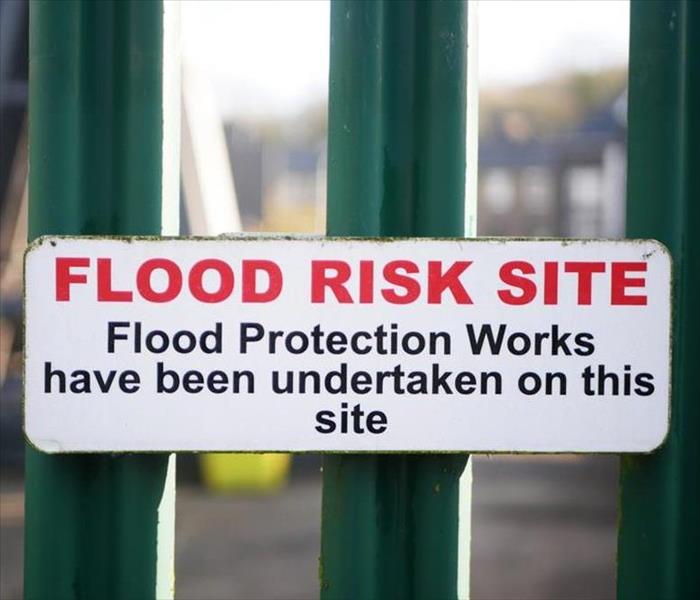 Be prepared for the worst!
Be prepared for the worst!
Storm preparation is vital for any company. A flooded building can disrupt business and stop an inflow of income. Along with that, flood water can cause a lot of damage and may require restoration services. Here are a few ways you can prepare your building to reduce risks of flooding and save money.
1. Back Up All Critical Information
If important documents or technology get ruined in a storm, this information may be gone forever. Back up anything important on hard drives and have copies of documents in a secure location. That way, once the aftermath has cleared, your company can continue to run smoothly.
2. Consider Flood Insurance
Whether you are in a mapped flood zone or not, it’s a good idea to have flood insurance. Flood water in the building can completely disrupt business if one affects your building. This can help you cover restoration expenses as well as business and employee costs.
3. Have Emergency Kits Ready
The most important part of your business is your employees. Have emergency kits ready for any disaster. A few important emergency kit supplies include the following:
• Enough water to last 24 hours
• Flashlights
• First-Aid kits
• Batteries
• Non-perishable food
If a disaster does occur, you can be confident that your employees will be taken care of.
4. Waterproof Your Building
If your business in Murfreesboro, TN, is based in an old or leaky building, consider doing any repairs that might stop water from entering the building. Caulk any cracks, install a drainage system, and add waterproof sealant to anything that might result in a leak.
Although you may never deal with flood water in your commercial building, it doesn’t hurt to take precautions to reduce the water damage if a flood were to occur. If a severe storm does affect your business, take care of your employees and call in restoration services quickly. Once everything is repaired and secured, your business can start up again.
How Storms Can Damage the Roof of Your Business or Home
2/26/2020 (Permalink)
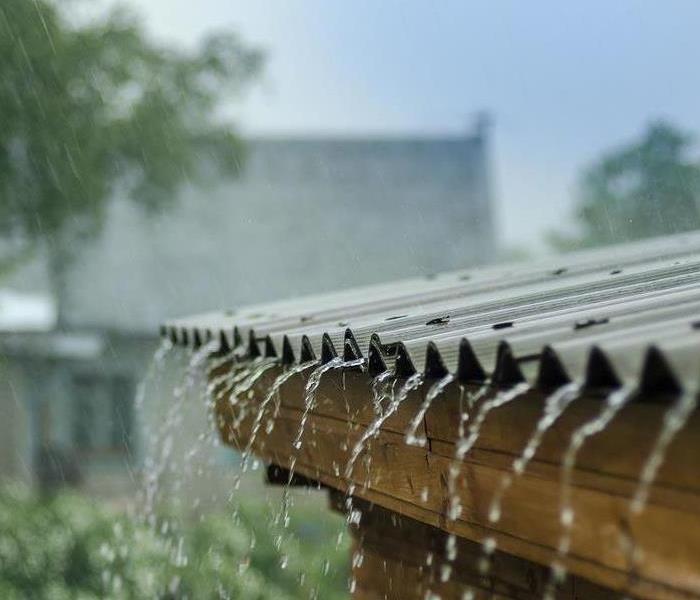 Check your roof after a major storm
Check your roof after a major storm
The roof of your home or business is important. A well-maintained roof promotes energy efficiency and protects the building from the elements. When the roof withstands damage, the integrity of the building is affected. If a storm damages your roof, SERVPRO of Rutherford County is the company to call for cleanup and restoration.
Surveying Your Roof After a Major Storm
Commercial and residential property owners should have their roof inspected after major storms. High winds as well as heavy rains and hailstones can damage a roof in many ways. They can cause shingles to blow off individually or in full patches. Tree limbs can fall onto the roof to leave a hole in the structure. We do not advise you to climb onto the top of the building on your own because of the high elevation and steep incline of most roofs. If you believe that your property has been damaged by a storm, you should contact a professional for an assessment.
What We Can Do to Recover and Restore Your Property
Our staff is highly trained in property damage restoration. SERVPRO’s Corporate Training Facility ensures we are always up to date on the best techniques to get your home or business back in shape after a storm. Regular IICRC industry certifications, means we have the knowledge as well as the equipment to restore your property. We clean the damage the storm left behind, and this includes on the interior or exterior of your building.
Severe weather is unfortunately common in the Middle Tennessee area, and it can cause significant damage in a very short period of time. SERVPRO of Rutherford County is available to respond to requests immediately after a major storm. We can begin the restoration and cleanup process quickly so that you can more easily move past the current issue and protect your property.
3 Common Causes of Mold Damage in Your Home
2/21/2020 (Permalink)
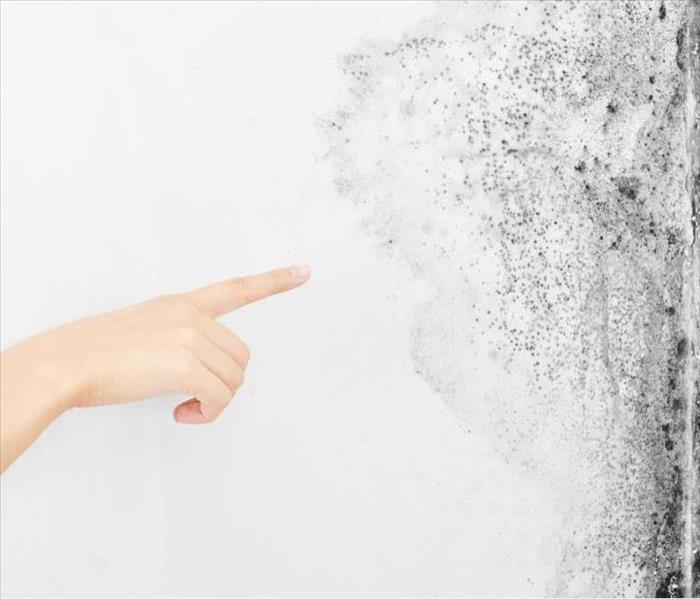 Mold can spread very easily in your home
Mold can spread very easily in your home
Your home has mold.
But don’t get alarmed (yet) – mold is a naturally occurring fungi that lives in all environments. The Environmental Protection Agency (EPA) says it’s impossible to eliminate all mold and spores from your house.
However, if conditions in your home are right, those fungi can spread and cause mold damage and big problems.
Stop Mold Damage Before It Starts
Mold grows best in damp, hot, and humid places. So the best way to control mold is to control the moisture in your home. Here are three common causes of mold damage in your house that you need to know about.
1. Leaky Pipes or Roofs Cause Mold Damage
One of the most common causes of mold damage is from leaks. Leaks create areas of standing water where mold colonies can grow. Call a plumber or replace any leaky pipes. Also note any discoloration on your ceiling, which can be a sign of water damage from a leaky roof or a leaky pipe in the room above. Remember, the source of these leaks must be fixed before any mold remediation can occur or the problem will continue.
2. Humidity Causes Mold Damage
The Tennessee Department of Health recommends the humidity in your home be set between 30 and 50 percent to prevent mold damage. Some thermostats have a setting which allows you to control the humidity level. This is important to note, especially during the hot and humid summer months here in Rutherford County.
If your thermostat doesn’t give you this option, think about using a dehumidifier. The most economic units will run between 50 and a few hundred dollars, but this is a small investment considering the potential costs associated with mold remediation.
3. Poor Ventilation Causes Mold Damage
Ventilation helps reduce the heat and humidity from areas with a lot of moisture – specifically kitchens, laundry rooms, and bathrooms. Check that your exhaust is not blocked and is venting all of your heat and humidity outside. Ensure exhaust fans are working properly over cooking surfaces and in your bathroom. It’s also smart to crack open a window while showering to help reduce the humidity in the room.
How to Get Rid of Your Mold
If you spot mold damage in your house, you need to act fast. And the highly trained mold remediation specialists at SERVPRO in Rutherford County are on call 24/7 – ready to assist in your emergency needs. Our team will help find the source of your problem and suggest services that are right for your home and budget.
Contact SERVPRO in Rutherford County at (615) 849-9794 to schedule your appointment today.
How to Prevent Fires in LaVergne: Tips from Fire Restoration Experts
2/21/2020 (Permalink)
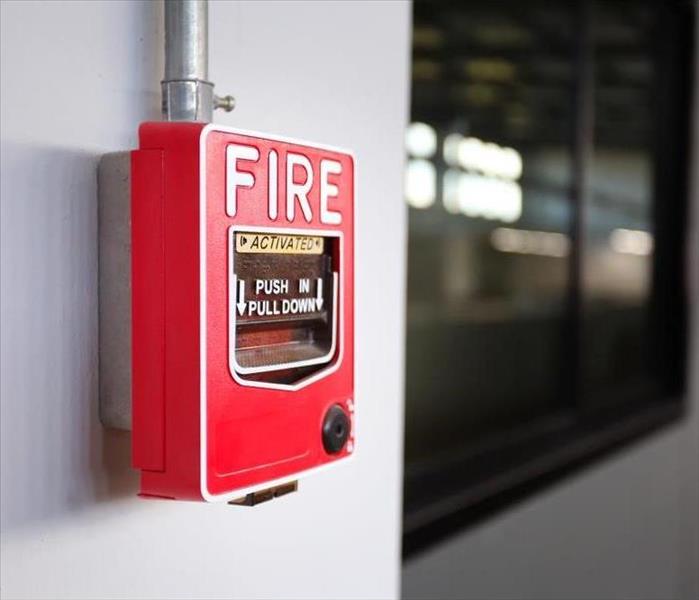 We're here in your time of need
We're here in your time of need
What type of business do you have?
Is it in any way susceptible to the risk of fire?
If yes, then you definitely need to have a fire precautionary plan for your business premise.
Statistics from the National Fire Prevention Association (NFPA) indicate a rise in the number of non-residential fires over the years. Some of the most common commercial buildings where fires occur include small offices, small buildings, and restaurants.
So how do you prevent these fires?
Fire Prevention: Tips from SERVPRO in LaVergne
Don’t wait until your building catches fire, here are insightful fire prevention tips from experts.
1. Electrical Appliances
Ensure you take the following precautions when it comes to your electrical appliances:
- Most electrical appliances come with recommendations from the manufacturer. You need to follow these instructions to prevent a voltage overload that may result in a fire outbreak.
- Replace frayed power cords. Also, instead of running your power cords under carpets or rags, it’s recommended to use cord protectors.
- To prevent late-night and weekend fires, ensure you unplug appliances such as coffee makers and microwaves at the end of the day or when they are not using the office.
- Appliances that feel exceedingly hot may be faulty and may be a fire hazard. Have them checked or just replace them.
2. Regular Inspections
You may have to call in a fire marshal to inspect areas where chemicals and equipment are stored. The aim for this is to ensure there is enough ventilation in these rooms.
3. Storage of Hazardous Materials
Most of these materials come with the manufacturer’s instructions on how to properly store them. You will also have to conform to the OSHA regulations and ensure you’ve properly marked them.
Efficient Commercial Fire Restoration in LaVergne
It must have been devastating seeing your building burn.
If the disaster has occurred and you don’t what to do next, seek the services of a professional fire restoration company in LaVergne.
At SERVPRO, our main goal is to have your business up and running as soon as possible. It’s time you talked to SERVPRO professionals for your commercial fire restoration needs in LaVergne.
4 of the Best Carpet types for Middle Tennessee Weather
2/20/2020 (Permalink)
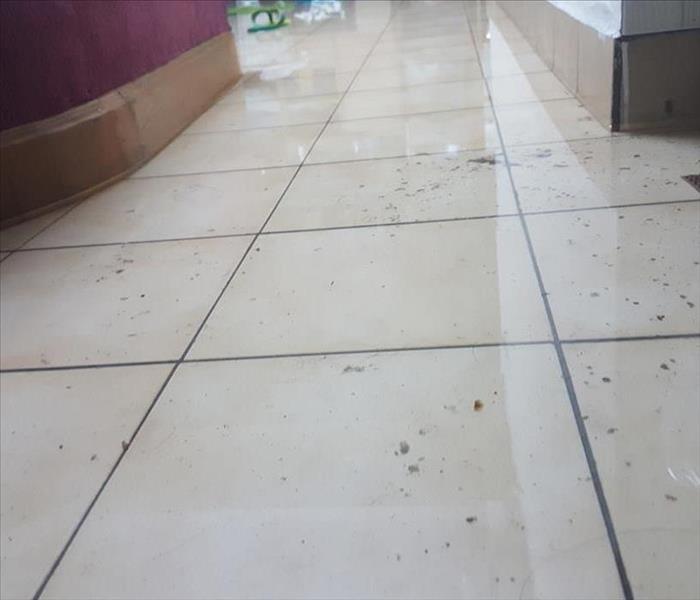 SERVPRO can handle all your cleaning needs
SERVPRO can handle all your cleaning needs
4 of the Best Carpet types for Middle Tennessee Weather
There are many reasons why carpet is so popular. People often choose carpet as the go to floor covering because of its warmth and versatility. Others like it because of insulation, safety, noise reduction, durability, and ease of maintenance. Carpets are an affordable way to make a room feel cozy while also adding to the "coziness" of a room. Modern carpets are available in a variety of colors and patterns. They can fit in well with contemporary or traditional décor, and each room can reflect its own personal style. Carpet can also be chosen to reflect the weather conditions for that area.
Best Cleaning Methods for Carpet Material
Let's think of carpets according to their construction. The four main carpet types are loop, texture, twist, and shag. Level loops have short loops and multi-level loops offer a patterned texture. In a cut pile carpet, the loops are cut, leaving a soft smooth texture. There are some carpets that use both methods called the cut and loop. The fibers can be natural or synthetic. The type of fiber is what determines how it should be cleaned. Nylon and olefin are durable and are good choices for homes that are located in areas where inclement weather is the norm. Wool and acrylic wear well, but special care is imperative when cleaning. The SERVPRO Rutherford County experts know the right techniques to use for each carpet type.
Weather Affects Carpet Cleaning
Carpets made from synthetic fibers are best used where the humidity and moisture is high. Fibers such as olefin, polyester, nylon, or the relatively new triexta, resist the growth of mold and mildew. Carpets made from synthetic materials are easier to clean because they dry faster than those made from natural fibers. Snow and rainy weather conditions are hard on carpets because of the moisture brought in on shoes. Under these adverse conditions, the carpets may require more cleanings throughout the year to keep them looking pristine.
Cleaning Protects Investment
Carpet is an investment for the home and its residents. Keeping your carpets cleaned and fresh makes it feel homey and comfortable. Middle Tennessee weather can be difficult to deal with, but the experts at SERVPRO Rutherford County know how to keep your carpets clean. Their professional cleaning services remove dirt and grime from carpet using state-of-the-art equipment. They know what type of cleaning method to use for each carpet type and can recommend ways to keep it clean during the hot humid summer months or the cold days of winter. If it's been some time since your carpet was professionally cleaned, you should give us a call!
4 Tips for Avoiding a Flooded Home While You’re on Vacation
2/20/2020 (Permalink)
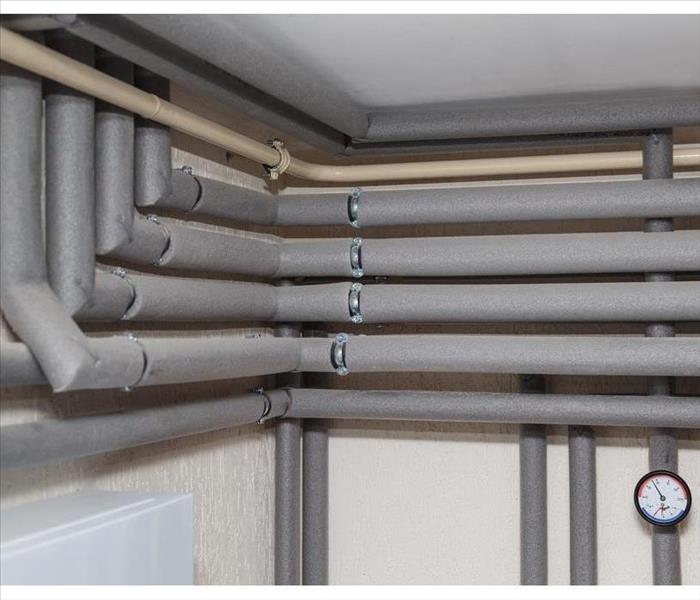 Insulate exposed pipes in your home
Insulate exposed pipes in your home
Consider These 4 Tips To Avoid Disaster When You Are Away From Home
A warm-weather getaway during the winter months can be just what the doctor ordered. As much as you may enjoy hitting the waves on vacation, however, discovering standing water in your home when you return is a different story. Burst pipes, among other factors, can cause flooding during the winter months when water pipe repair and water damage cleanup can be especially costly. So, consider these four tips to avoid a disaster when you’re away from home for days.
1. Clean Gutters
The combination of heavy rain and clogged gutters can cause everything from a roof leak to lawn drainage issues. Either way, the result can be the same — unwanted water inside the house.
2. Insulate Exposed Pipes
Uninsulated, exposed pipes are very vulnerable to extreme winter temperatures. A broken pipe is a real possibility due to water in the pipe freezing and expanding. This could result not only in a flooded home but also a costly water pipe repair bill.
3. Inspect Sump Pump
A sump pump with a pit that’s full of debris pumps inefficiently; sediment can cause clogs in the intake and discharge pipes. Inspect the pit before you leave to make sure it’s free of debris. Also, keep the basement heated so that these and other pipes don’t freeze.
4. Keep the Heat On
Just as you should keep the heat on in the basement, so should you sufficiently heat the upstairs. If extreme winter temperatures are expected during the time that you’re gone, leave kitchen and bathroom sink cabinet doors open to allow warmer air in. Also, put faucets on a slow drip to help avoid the risk of frozen pipes.
If your Smyrna, GA, home sustains water damage due to a burst pipe, hire a plumber for the water pipe repair. In the meantime, you can call on restoration professionals to begin the process of returning your home to its preloss condition.
SERVPRO Holiday Safety Tips For Commercial Properties
12/16/2019 (Permalink)
The holiday season is here, bringing festive parties, cold winter weather, and plenty of other workplace hazards. SERVPRO is here to help keep your property and workers safe, happy, and healthy during the holidays with some practical disaster prevention tips.
1 Decorate with care
Holiday decorations can keep the workplace mood cheery and festive. Keep high-traffic areas clear of decorations to avoid any mishaps. The best places to decorate are reception areas, lobbies, break rooms, and foyers.
Be mindful of the weather as you hang decorations. Strong wind and heavy snow or ice can cause damage to your decorations, buildings, trees, and other property if you aren’t careful.
After you hang all your decorations with care, walk about your property as if you are a customer, employee, or visitor. Can you see all the appropriate entrance and exit signs? Is everything easily accessible? Are there any tripping hazards? Are there any potentially dangerous decorations within reach of young children? Check to be sure all the fire extinguishers, strobe alarms, and other safety apparatus are visible and unobstructed.
2 Keep decorations aglow and avoid fire hazards
Make sure you select noncombustible or flame-resistant decorations. Unfortunately, many decorations are flammable. Keep them away from heat registers, radiators, stoves, and other heat sources.
Avoid using candles and other open-flame decorations around commercial buildings. It’s easy to knock them over or forget about them when everyone goes home at the end of the day.
If you decide to hang exterior lights, make sure you choose lights that are suitable for outdoor use. Fasten them to the building, walls, trees, and other places with appropriate light clips instead of tacks, staples, nails, or other things that might puncture the electrical cord.
Avoid linking more than three strands of lights together and use as few extension cords as possible. This reduces the risk of electrical fire and avoids overloading extension cords and electrical outlets.
It’s best to turn off all holiday decorations when the building is closed. This significantly reduces the risk of electrical fires and other mishaps.
3 Be prepared for a “white Christmas” with snow and ice removal
Do you have plans or the right equipment to handle any snow or ice that might come your way? It’s best to have a plan before the first snow or ice storm of the season.
Walkways, parking lots, and other areas can become slippery very quickly when rain or snow freezes. Improper snow and ice removal can also block access to fire hydrants, handicap parking, loading docks, and other critical areas.
It’s easy to forget to stock up on snowmelt, deicer, and other supplies to deal with winter weather. Make sure everyone stays safe this holiday season by preparing for whatever winter throws at you.
4 Keep your building toasty warm and dry
During the cold winter months, your HVAC system is working overtime to keep the people in your commercial property toasty warm. Don’t forget to schedule a full HVAC inspection to make sure everything is running efficiently. Reduce the stress on your HVAC system by turning off cooling systems that aren’t necessary.
Have the roof, weather stripping, and insulation inspected before winter weather sets in. The temperature changes and precipitation during the winter months can be hard on any roof. Repairing holes, leaks, or damage prevents energy loss and helps your HVAC system run more efficiently. It can also help prevent frozen pipes and damage from water leaks.
5 Avoid a frozen pipes incident
Frozen might be an adorable kids movie, but it’s best to avoid any workplace reenactments. Even a cold draft can cause a pipe to freeze, especially in older, poorly insulated buildings. This is particularly dangerous during the holidays when business hours might be shorter, and fewer people are around your property to find leaks before they cause significant damage.
When pipes freeze, the water expands. The pressure can cause the pipe to crack. Not only will this disrupt the water supply to the entire building, but it can also cause significant water damage and even flooding. The water leak can lead to mold and mildew damage.
Winterize your property before winter settles in. Make sure your pipes are appropriately insulated to prevent them from freezing and bursting (especially pipes that run along exterior walls). Make sure all shutoff valves and levers are in good condition. Run water at a slow drip to prevent pipes from bursting if they do freeze, especially if your building will be unoccupied for any length of time.
SERVPRO technicians are standing by throughout the holiday season to respond to any disaster. Whether the holiday potluck ends with a kitchen fire or a frozen pipe spills water, we will help you recover and return to normal quickly. Contact us today to learn more about our commercial restoration services.
Protecting Your Home From Winter Storm Damage
11/25/2019 (Permalink)
Winter weather can be unpredictable in Tennessee. Ice and snowstorms, freezing temperatures, and other winter weather can come with little warning. Winter storms can cause all sorts of problems, from power outages to frozen pipes and wind damage.
SERVPRO technicians are ready to help you recover from any winter storm damage to your home, but with some preventative work, you can help protect your home from severe damage.
Prepare Your Home for Winter
Fall is an excellent time to prepare your home for cold weather and winter storms.
Check your ice melt and snow removal equipment
Make sure you have the right ice melt or rock salt on hand to keep walkways and driveways clear of dangerous ice. If you have a snowblower, check to make sure it’s running properly, and you have enough fuel.
Check the heating and air conditioning
Your heating and air conditioning systems last between 10 and 15 years, but with excellent routine maintenance, many units can last more than 20 years! Schedule a routine maintenance inspection each fall to ensure your system is prepared for the cold months ahead. Change your air filters and ensure everything is running well.
Having your HVAC system inspected also ensures your furnace and water heater have enough ventilation to prevent high carbon monoxide levels in your home this winter. People tend to keep their home closed more tightly in winter, increasing the risk of carbon monoxide poisoning.
Inspect the outside of your house
Inspect the siding and wood trim around the outside of your home. Most patios and decks are built with pressure-treated wood, but wood trim around exterior doors and windows is usually just pine wood that can rot quickly if not properly treated.
Also, replace missing or damaged siding and roof flashing that can let water and ice into your home.
Inspect the caulk and paint around all your windows and doors. Look for places where the caulk is cracked, or the paint is chipping. Replace any rotting or broken wood trim and protect it by keeping the trim properly caulked and painted.
Check the drainage around your home. Soil settles over time, creating places for water to pool around your foundation. Fill any low spots with soil and make sure the landscaping slopes away from your house.
Make sure your gutters and downspouts are clean. If your gutters get clogged, it allows water to back up, then overflow and run down the side of your home. Over time this can deteriorate your foundation and even let water get into your basement or crawlspace.
Add downspout extenders to make sure water runs at least 3 to 4 feet away from your home. If the soil near your foundation becomes saturated, then freezes and thaws repeatedly, it can lead to cracks in your foundation and other significant issues.
Turn off all the exterior water faucets and disconnect garden hoses. Drain the water pipes to prevent them from bursting. If you have a sprinkler system, have your sprinkler service drain your system to help avoid freezing and leaks.
Clean your chimney
It’s lovely to curl up by the fire on a cold winter night. Have your fireplace inspected before you start building any fires. Not only can this improve heating efficiency, but it will also prevent any dangerous situations.
Trim dangerous branches
Fall isn’t a great time to prune trees and bushes, but you should cut off any branches that are rubbing against your house. Ice is heavy and known to wreak havoc on power lines and private property. Trim your trees, so you don’t have ice-covered branches threatening your roof, siding, or other parts of your house.
Check your attic
When the temperatures drop, critters look for warm places to hide away. Unfortunately, they can cause a lot of damage to your attic space. Trim your trees away from the house to make it more difficult for critters to access your gable vents. Tack a screen up behind the gable vent to keep out furry and feathered freeloaders. Also, check to make sure there are no holes in your soffit and fascia that will allow birds to get in.
Look for cracks and holes where warm air is escaping from your attic. Even small holes put extra stress on your HVAC system. Fill any gaps with professional-grade caulk to improve energy efficiency and prevent unwanted critters from making themselves at home.
While you are in the attic, make sure there is enough insulation. Properly insulating your attic will help lower energy costs and prevent ice dams from forming and causing water damage. If the insulation looks old, torn, damaged, or wet, then it’s time to replace it.
Prepare the Inside of Your Home
Fall and winter are the most common times of the year for house fires (December and January are the peak months). People are also running furnaces, building fires, and keeping their homes closed tightly, making it easier for carbon monoxide to build up. Test your smoke and carbon monoxide detectors and replace the backup batteries
Make sure your pipes are appropriately insulated to prevent them from freezing and bursting. Insulate the pipes in your basement and crawl space by putting foam sleeves around them. Another way to prevent your pipes from freezing is to keep your interior doors and cabinets open so the heat can flow through your home.
Preventing Water Damage
Water damage from ice dams and frozen pipes is one of the common ways winter storms wreak havoc on your home.
Pipes are more susceptible to freezing when the temperature falls below 20 degrees F. The outdoor pipes that are most susceptible to freezing are outdoor faucets, swimming pool supply lines, and water sprinkler pipes. Indoors, pipes in the basement, crawl spaces and garages are also at risk of freezing.
Open your kitchen and bathroom cabinets to allow warm air to circulate around the pipes. Let water faucets drip if the pipes run through unheated or uninsulated places.
Make sure you know where the main water valve is located. If a pipe does freeze and burst, you will need to be able to turn off the water quickly to prevent further damage.
Ice dams can cause melting snow and ice to back up into your roof and the walls of your home, causing water damage. When warm air escapes from your attic, it causes ice and snow to melt and create icicles or ice dams. If you notice a lot of icicles forming around your home, pay extra attention to the condition of your attic.
Contact SERVPRO
If a winter storm does cause damage to your home, call SERVPRO immediately. Our experts will assess the extent of the damage and create a plan to restore your home fully. Especially when dealing with water damage, it is critical to act quickly to prevent other issues like mold and mildew.
SERVPRO professionals are specialists in water damage restoration and structural drying. Our Disaster Recovery Team can respond quickly with all the right resources to help you recover from all types of winter storms.
How to Prevent Frozen Pipes This Winter
11/19/2019 (Permalink)
Winter storms can bring freezing temperatures, power outages, and other serious issues that can damage your home and property. Frozen water pipes are a common problem during the winter months, especially if the power goes out or a winter storm brings dangerously low temperatures.
If your pipes freeze, the lack of running water is inconvenient at best and can cause extensive water damage! It prevents you from showering, flushing toilets, doing laundry, and other essential tasks.
SERVPRO water damage restoration experts are standing by 24/7 to help you recover from frozen or burst water pipes. Here’s what you need to know about preventing water damage from frozen water pipes.
What Pipes Are Vulnerable to Freezing
Studies show that pipes are most susceptible to freezing when the temperature drops to around 20 degrees F, especially if your pipes are poorly insulated.
The pipes that are most at-risk for freezing are in unheated areas like basements, attics, and garages. Even pipes in your exterior walls and under cabinets can freeze.
In the southeast, we rarely experience bitterly cold temperatures, so most homes have less insulation around the pipes. Fortunately, there are easy, cost-effective ways to keep your pipes safe.
How To Avoid Frozen Pipes
Some of the best ways to keep your pipes from freezing might not help you conserve water or energy. Still, it’s better to have a slightly higher water bill than to deal with significant water damage.
Let your faucets drip
Allow your faucets to drip, especially if the faucet is served by exposed pipes. Running even a trickle of water helps prevent the pipes from freezing.
It’s not necessary to let all the faucets in your house drip. If possible, identify the faucet furthest away from where the water comes into your house. Turning on this faucet keeps the water traveling through most of the pipe system.
Insulate your pipes
Check all around your home to identify all the water pipes that are in unheated areas like attics, crawl spaces, garages, and exterior walls. It might not be possible to access all the pipes, but it is helpful to add insulation wherever you can.
Both hot and cold water pipes should have at least a little insulation. Foam rubber or fiberglass pipe insulation sleeves can cost as little as 50 cents per foot, and it is relatively easy to install. Even a newspaper can provide a little insulation in a pinch.
Insulating the hot water pipes will also help lower your water-heating costs. It helps heat from escaping as the hot water travels through your pipes, and you might even be able to lower the temperature on your water heater.
Adding insulation to the cold water pipes can help prevent the pipes from sweating. When cold pipes run through the warm, humid air, condensation can form on the pipes and can cause puddles on the floor and higher humidity levels. Higher humidity and puddles can cause minor water damage.
Open and close the right doors
Opening the kitchen and bathroom cabinet doors allows warm air to circulate around your pipes. This is especially helpful if your sinks are on an exterior wall.
While you’re opening the cabinet doors, keep the garage door closed. This helps regulate the temperature, especially if you have water pipes running through the garage (don’t forget about pipes that might run behind the drywall).
Set your thermostat
When the weather turns cold, it’s tempting to turn the thermostat down at night to save a little on your heating bill. Keeping your home at the same temperature all the time will help prevent your pipes from freezing.
If you are planning to escape to warmer climates, leave the heat on to protect your home from frozen and burst pipes. Fifty-five degrees F is an ideal temperature when you’re away. It won’t run up your heating bill too much and will prevent your pipes from freezing.
Signs Your Pipes Are Frozen
There are a few signs to look for that will indicate if you have frozen pipes somewhere in your house. If the temperature falls below 32 degrees F, begin to keep an eye on your pipes, especially in southern climates where the pipes tend to be less insulated.
Frost on your pipes: If an exposed pipe freezes, you will probably be able to see frost on the outside of the pipe.
No water: If you turn on the faucet, and no water comes out, or there is less water than usual, your pipes might be frozen. If you turn on your sink and only a trickle of water comes out, the pipe leading to that faucet may be frozen.
Unusual smells: When a pipe or drain is blocked (like when it’s frozen), the only way odors can escape the pipes is back in the direction of your home. So, one sign that your pipes may be frozen is if you notice odd smells coming from your faucets or drains.
What To Do If Your Pipes Freeze
It’s essential to act quickly when your pipes freeze to avoid further damage. It’s critical to thaw the pipe as soon as possible before it bursts and causes water damage.
The first thing to do is to locate the frozen pipe. This can get very complicated because you cannot see most of the pipes in your home. Look for pipes with frost on them. Frozen pipes might also have a slight bulge.
When you find the frozen section, turn on the faucet that the pipe feeds. Turn on the hot and cold handles to help relieve the pressure and give the water a place to go when it begins to thaw.
If the frozen pipe is exposed, you can use a hairdryer, portable space heaters, and hot towels to thaw the pipe.
If the frozen pipe is behind a wall or in an area you cannot easily access, turn up the heat in your home to help thaw the pipes. If you know where in the wall the frozen pipe is running, you can place an infrared lamp or portable space heater close to the wall. This may be enough to thaw the pipes.
Never try to thaw pipes with an open flame or any method that could cause a fire. Contact a licensed plumber if you cannot quickly identify the frozen pipe.
If Your Pipe Bursts
If a pipe bursts, turn off the main water line as quickly as possible. After you turn off the water, contact SERVPRO. Burst pipes can cause extensive water damage. It’s essential to clean and dry everything correctly to prevent mold and mildew from growing and avoid structural problems.
Our technicians are experts at cleaning and drying water damage. We use pumps, vacuums, and other water removal tools to clean all the water. Our experts use specialized equipment to make sure all the water and moisture is removed before we begin the restoration process.
SERVPRO has all the resources to respond to any size winter storm disaster. We are standing by 24/7 to help you restore your home quickly. Contact us today to learn more about our water damage restoration process.
Storm Damage: Tips for before and after a major storm
10/27/2019 (Permalink)
Storm damage is difficult to avoid entirely. You can't control the weather, but you can be proactive and keep your home or business as safe as possible. SERVPRO is standing by to help you recover from any size or type of storm. Here are five things you can do to prevent storm damage to your property.
Take "Before" photos ahead of major storms
When a significant storm is headed your way, document the current condition of your property and valuable belongings. As safely as possible, take photos or video of your home or building. Document the condition of your roof, siding, windows, gutters, drainage systems, and any sheds or storage houses.
These "before" photos will help with the insurance claims in the event of significant storm damage. This is particularly helpful for commercial property owners and property managers.
Batten down the hatches
The easiest way to prevent storm damage is to keep your home or building in peak condition.
Roof, siding, windows, and doors
Schedule annual or semiannual roof inspections. Your roof is the first line of defense against storm damage, but roof damage can be difficult to see with a naked eye. An expert roofer will repair or replace loose, cracked, missing, or damaged shingles.
If you are preparing for a particularly strong storm, consider laying tarps and plywood on your roof to help prevent shingles from getting ripped off. The tarps can act as an extra layer of protection to keep water out and to avoid wind damage.
Visually inspect the siding on your home. Repair any loose siding that might get ripped off in a strong wind. Wind only needs a small crack to lift siding or shingles off your home. Replace any damaged siding that might allow water to seep into the walls.
Make sure your doors, windows, and skylights have reliable seals to keep out the wind, rain, and cold. If you are preparing for a hurricane or strong winds, it is essential to cover your windows with plywood or storm shutters.
Gutters, landscaping, and drainage
Clear your gutters, drainpipes, or flat-top roof of any debris. Leaves and branches can clog your gutters, causing it to overflow. In warm weather, overflowing water can flood into your home. In cold temperatures, standing or overflowing water can freeze, causing damage to your roof.
Keeping your landscaping maintained is an easy way to prevent all kinds of storm damage. Prune trees and shrubs to clear dead or diseased branches that might fall and damage your property. Make sure you keep at least 3 feet of space between your home and any tree branches or shrubs.
Regularly check the trees on your property for damage like cracks in the trunk, mushrooms growing on the trunk (that indicates decay), or branches that cross or interfere with each other.
While you are inspecting the landscape, check for loose fence posts, light posts, and similar structures around your property. Shake each post to test its strength and stability. Even loose fence posts can become dangerous in a strong storm.
Make sure water flows away from your home or business into a ditch or drain. Standing water or flooding during a major storm can cause flooding in your home.
Patio furniture and outdoor items
If you are preparing for a particularly strong storm (like a hurricane or nor 'easter), consider bringing lawn ornaments, patio furniture, garbage cans, grills, and other items indoors. If you cannot bring them in, make sure they are tied down. In a powerful storm, nearly anything can become a dangerous projectile.
Avoid ice damage
Keep your attic insulated properly. This reduces heat loss through your roof, which makes your home or business more energy-efficient and helps prevent ice damage.
As the heat escapes from poorly insulated attics, it melts snow and ice, which can refreeze, creating an ice dam. The ice dam causes water to "back up" under the shingles or fascia boards and soak through the roof and walls.
Immediately after the storm
It is important to assess your property as soon as possible. Finding damage as quickly as possible after the storm can help you minimize damage and save time and money.
Look for signs of water damage inside
While it is still raining or immediately after the storm, inspect your property for signs of water damage. The most obvious signs of water damage are puddles and dripping water. Also, look for stains and discoloration on the ceiling and walls. There may be more water inside the wall or ceiling that can cause more damage.
Mark any leaks you find with tape. When the rain stops or the water dries, it might be challenging to identify the exact location of the leak again. The marks will help SERVPRO experts identify and resolve the issue more quickly.
Check the basement and crawl spaces for water damage. Make sure no water is seeping in and that your sump pump or drainage systems are working.
If you find any water damage, take photos from different angles. Documenting everything as thoroughly as possible will make filing the insurance claim much more manageable. SERVPRO technicians can help you record any damages and relay that information to your insurance provider.
Assess the outside of your property
As soon as it is safe, begin to assess the exterior of your home or business carefully. Stay clear of any downed power lines, damaged trees, and floodwater.
Check for cracks, chipping, and dents in the siding, brick, or stucco. Discoloration is another indication of damage to bricks and siding. Even small cracks or holes require attention from a professional. Make a point to inspect the outside several times after the storm. Different lighting can reveal damage that is easy to miss.
Inspect your air-conditioning units, fences, vent caps, and other things on your property that may have incurred damage.
Contact your SERVPRO professionals who are ready to help you restore your home or commercial property to its original condition after storm damage. We are available 24/7 and equipped to handle any size disaster.
Preventing Storm Damage to Your Commercial Roof
10/23/2019 (Permalink)
When there is a significant storm on the horizon, you might not be able to control the weather, but you can take proper steps to protect your property.
SERVPRO would rather help you prevent damage, but we are available 24 hours a day to clean and restore any property damage. Our trained technicians are ready to repair all kinds of storm damage.
Roof damage can quickly lead to other kinds of property damage. Here are some practical tips for protecting your commercial roof from storm damage.
Preventative maintenance is the first line of defense
The easiest way to prevent storm damage to your commercial roof is to follow the recommended preventative maintenance schedule. Have a roofing expert inspect your roof annually or semiannually. It is easier to repair small issues before they become significant problems.
Remove debris and hazards
Storm damage often comes from blocked storm drains. Clean any loose debris and make sure there is no standing water. Loose roofing materials, branches, leaves, and other debris can prevent water from draining correctly.
Remove hazards like overhanging limbs and weak roofing sections. Trim branches and bushes to at least 3 feet away from your building. This prevents leaves from blocking drainage systems and reduces the risk of damage to your roof.
Make sure the HVAC systems, satellite dishes, and other equipment are anchored correctly. During a storm, these can cause blunt force damage. Loose material blowing across rooftops cause up to 70% of roof damage during a hurricane.
Waterproof a flat roof
Cold temperatures can cause asphalt-based roofing materials to crack. Hot weather can cause "crazing" and bubbles. If you have a flat roof, invest in regular waterproofing treatments to prevent moisture damage. Make sure the roof hatch and access doors close tightly to prevent water seeping into the building.
Extra preventative measures
If you know a strong storm is on the way, lay tarps and plywood on your roof. The tarp holds shingles in place and adds an extra layer of defense against water.
If you live in an area with frequent, intense storms and high winds, consider replacing your asphalt roof with more durable metal, plastic, or stone materials.
After a storm
Immediately after a storm, look for leaks and evidence of water damage inside your building. Once the weather clears and water dries, it can be challenging to find the leaks. It's best to inspect your property immediately after a significant storm or while it is still raining.
Check your roof for damage and holes that might allow more water, bugs, or debris to get into your building.
If you find any water damage inside your building, immediately phone your SERVPRO technicians and your insurance provider to alert them of the damage. Roof leaks shorten the life of your roof. Untreated water damage can lead to more significant issues throughout your building, like mold and mildew.
Protect your property
Even small amounts of water damage can become a significant problem. As soon as you discover water damage or a leak in your roof, move inventory and property to a safe place or cover it to keep everything dry. Avoid any wet electrical equipment. Contact an electrician immediately if the roof is leaking onto electrical equipment.
Document any water or storm damage for your insurance provider.
Stay off the roof
Storm and water damage can compromise the integrity of your roof. Avoid the temptation to assess the roof yourself. Instead, call your roofing contractor who has the proper training and equipment to inspect your roof safely.
When the roofing contractor arrives, ask them to take photos of any damage for your insurance claims.
Let SERVPRO handle the restoration
A leaking roof can let water seep into insulation, drywall, and other building materials. It is essential to make sure everything dries thoroughly to prevent mold, mildew, and other structural issues.
After our SERVPRO technicians inspect your building and determine the scope of the damage, they use specialized equipment, sensors, and infrared cameras to identify hidden moisture, in ceilings, walls, and flooring that is very difficult to see.
Our technicians use pumps, fans, and wet/dry vacuums to clean up any excess water. We remove any drywall, insulation, and other materials that cannot be dried and repaired.
When everything is dry, our technicians repair everything as quickly as possible so your business can get back up and running. We can even help you with your insurance claims!
5 Things You Should Know About Commercial Fire Damage
10/5/2019 (Permalink)
Any amount of fire damage can be devastating for a business, and fire restoration is hard work! After the fire department ensures everything is safe, restoration professionals are the next people who should enter a building that has been damaged by fire, water, flood, sewer backup, or other significant events.
SERVPRO technicians are experts at commercial fire, water, and mold restoration and we will have your business back up and running as quickly as possible. We know that every day spent restoring your commercial building is lost revenue and productivity! We will do the hard work, so you don't have to.
Here are five commercial fire damage restoration tips.
1 Limit activity in the damaged area.
Don't enter a damaged building until the fire department deems it safe. Fire can impact the structural integrity of the building. Firefighters often have to cut holes in the walls, ceilings, and floors to slow the fire and make sure it is completely out.
You should limit any activity in the damaged area to prevent soot and ashes from being embedded into surfaces or spread to other areas of the building. Staying away from the damaged area also helps minimize your exposure to hazardous chemicals and materials like lead, asbestos, bacteria, mold, and other pathogens. Disturbing or spreading these toxins and contaminants can cause further property damage and can cause health problems.
SERVPRO technicians are experts at cleaning up even microscopic bacteria, mold spores, and hazardous chemicals. We use HEPA filters, vacuums, and special chemicals to make sure every area is safe and clean.
2 Removing smoke and soot damage is challenging.
Any fire, large or small, will likely cause smoke damage to walls, ceiling, and other surfaces. Soot is very greasy and can cover the interior of your business, even if the fire was limited to a small area. Smoke can get into the walls, floors, and air ducts, causing the smell to linger long after the fire if it isn't properly treated.
It is essential to hire fire restoration experts that will thoroughly scrub your building of all the soot, smoke, and potentially hazardous chemicals. Improperly cleaning smoke and soot can actually "set" the smells, especially in fabrics and textiles like carpets, upholstery, clothing, and similar items. Additionally, soot residue can contain dangerous chemicals and cancer-causing carcinogens.
3 Cleaning up after fire sprinkler and suppression systems.
It is essential to properly clean and repair any water damage to prevent mold and mildew from growing. Commercial buildings should have fire sprinkler systems, and many modern buildings have fire suppression systems instead of sprinklers.
Sprinkler systems automatically turn on if the temperature in the building rises too quickly. Some systems will turn on the sprinkler heads in every room while others only turn on in the places where the system detects a fire. Quick response sprinklers spray 18 to 24 gallons of water per minute to suppress and put out the fire.
Fire suppression systems use a mix of dry chemicals and liquids (like water) to put out any fires in the building. Suppression systems do reduce the damage directly caused by the fire, but they can make the amount of soot damage worse. The combination of water and dry chemicals can allow the soot and dust to spread around the building.
Whether from a sprinkler system or firefighters spraying gallons of water, if the fire was big enough, you probably have some water damage in addition to the fire damage. Mold and mildew can begin to grow within 48 hours after the water damage occurs!
SERVPRO technicians have the right chemicals and methods to clean up the fire suppressant chemicals and properly restore any water damage to prevent mold and mildew from growing.
4 The most common causes of commercial fires might surprise you.
According to the National Fire Protection Association, the most common cause of fires in commercial buildings are cooking equipment. Faulty stoves, cooking accidents, and other kitchen-related incidents account for 29% of fires in office properties and 13% of fires in retail stores.
Other primary causes of fires in commercial buildings include malfunctioning heating equipment, faulty electrical and lighting, and improperly disposed cigarettes, cigars, or other smoking materials.
Because kitchens and break rooms are high-risk areas for fires, make sure your sprinklers, alarms, and fire extinguishers are properly maintained and in good working order. Have your HVAC system, water heaters, and other electrical systems inspected and maintained by a professional. Always make sure flammable materials are stored away from heat sources.
5 Cleaning damaged property can be tricky
Cleaning all the smoke and soot-damaged property can be very challenging. You can't just throw the sooty, smoky clothes in the wash or take dirty curtains to the dry cleaners. Removing soot and smoke odor can be very difficult, and household remedies are not very effective.
It is vital to deodorize everything before you clean it. SERVPRO recommends letting the professionals do the dirty work. It is essential to use counteractants, chemicals that break down the smoke molecules to get rid of the bad odors.
SERVPRO technicians use counteractants on furniture, carpets, upholstery, curtains, and other fabric surfaces. If you decide to take things to professional dry cleaners, make sure they have experience and the right equipment to handle the job.
It is vital to clean all the dishes and cookware properly, even if they look clean and unharmed by fire or smoke. Make sure all dishes and utensils are scrubbed and soaked in a solution of bleach and water. Rubber and wooden cooking items tend to absorb smoke and should be thrown away.
In most cases, floors and carpets absorb the worst of the damage because of the water or chemicals used to extinguish the fire. It is important to make sure everything is dried thoroughly to avoid mold and other problems in the future. In many cases, it is necessary to take up the flooring and replace it.
SERVPRO technicians are experts at cleaning and restoring your commercial property to its original condition. We are standing by, 24/7 to help clean and repair any size disaster. Contact us today to learn more about our commercial restoration services.
What To Expect From SERVPRO Commercial Restoration Services
10/5/2019 (Permalink)
If your business needs water or fire damage restoration, it is essential to choose a company that has experience restoring commercial properties. SERVPRO is available 24 hours a day, 365 days a year, and our experts are highly trained to help any business recover as quickly as possible. Here is what you can expect from SERVPRO and our process of restoring your commercial property to its original condition.
1 Assessment
As soon as the fire is out, the storm is over, or the water main is turned off, our SERVPRO technicians will begin assessing your commercial property. We inspect to determine the extent of the damage and create a plan of action for restoring your building and property.
Often, in the case of fire, water, and mold, the damage is more extensive than it appears on the surface. Our technicians will use all available resources like sensors, probes, and cameras to assess the condition of your entire building to make the right repairs and prevent future problems.
When SERVPRO is dealing with commercial restoration, our technicians will also seal any leaks or address any immediate problems that could cause further damage. This might require putting tarps on a roof, repairing a pipe, or other preventative measures.
2 Contact the insurance company.
As soon as there is damage to your commercial property, contact SERVPRO. Some insurance companies may try to deny or limit coverage if they believe you did not take steps to minimize damage or prevent further destruction.
As soon as SERVPRO is on the way, notify your insurance company. Your insurance company will provide a claim number. If you would like our SERVPRO experts to help, give the claim number to the administrator assigned to your case. We will work with your insurance company on your behalf to provide documentation and begin processing your claim.
SERVPRO franchises will work with nearly every insurance company, and many insurance adjusters prefer to work with us because SERVPRO is a full-service provider.
3 Cleaning
Once our restoration experts assess the damage and create a plan of action, the first step is to clean the property.
Water damage
If your commercial property suffered water damage, the type of water damage would determine the cleaning process. Contaminated “black water” is much more challenging to clean than stormwater or a leaking pipe. Our experts will remove the water and use industrial dryers, fans, and dehumidifiers to remove all the moisture from the building.
Fire damage
Cleaning up after a fire is also a complicated process. Fire damage can compromise the structural integrity of your building. Our technicians will board up or tarp damaged areas to maintain security and prevent further damage.
After removing the water from the sprinkler systems or fire trucks, SERVPRO technicians begin removing soot and smoke from the building. Soot is very greasy and difficult to clean, and the smoke smell is notoriously challenging to get rid of. It’s essential to use the proper chemicals and techniques to prevent further damage. SERVPRO uses industrial air scrubbers, ozone machines, and fogging equipment to handle all the chemical and smoke odors. Our technicians use chemicals to kill bacteria and seal surfaces so the smells don’t return or linger.
Our SERVPRO teams include odor control specialists, upholstery and fabric cleaning technicians, and fire and smoke restoration experts. We ensure everything is clean and sanitized for your safety and to prevent future problems, like mold or bad smells.
4 Restore vs. replace, including your documents
Our goal is to restore everything to pre-damage conditions. SERVPRO believes it is essential to clean and restore as much as possible. This “restore first” attitude saves you money and helps you get your business back up and running more quickly.
Document restoration is another critical step in getting your business back up and running. If your business suffered any water damage, your documents might be exposed to sewage, bacteria, pesticides, or harmful chemicals in addition to water.
Our technicians use the latest vacuum freeze-drying method and gamma irradiation technology to dry, sterilize, and preserve damaged documents. Our drying processes are the only methods approved by the National Archives and Records Administration!
Our facilities are secure and HIPAA master-certified, so we can properly handle sensitive information. We can even use or computerized inventory system to digitize your documents.
5 Repairing
Once everything is properly dried, cleaned, and sanitized, our restoration team will work to repair everything. Our goal is to return your business to the pre-disaster condition. Whether that requires minor repairs like replacing drywall, installing new flooring, or painting or it demands total reconstruction, our repair teams are up for any size project.
From start to finish, our SERVPRO team will work with you and your business to ensure the restoration process is as smooth and efficient as possible. But, you don’t have to wait until disaster strikes.
Contact us today to set up your SERVPRO Emergency READY Program (ERP), so you are prepared for any incident. The ERP profile includes information like emergency contacts, locations for all your shut-off valves, and other vital details that you, your employees, and the emergency response team will need. You might not be able to prevent every accident or disaster, but you can be prepared for them!
6 Ways To Prevent Mold From Invading Your Home
9/16/2019 (Permalink)
Mold is all around us, and in every breath we take. It is a fungus that plays an essential role in the natural process of decay. Mold is also necessary for creating things like penicillin, cheese, and decomposing the piles of fallen leaves and dead trees in the forest.
It can grow year-round in almost every environment. Mold spores spread quickly in the air and can grow anywhere there is moisture and organic matter for it to "digest."
Outdoors, mold likes shady, damp places or anywhere vegetation is decomposing. Mold colonies thrive indoors where humidity levels are high, like basements, bathrooms, crawlspaces, and poorly ventilated areas. Carpet, clothing, food, paper, drywall, ceiling tiles, and wood are common surfaces mold likes to grow in people's homes.
It is impossible to eradicate mold from your home completely. However, it is crucial to keep the mold levels low to prevent it from growing and becoming a problem in your home.
SERVPRO is the industry leader in mold remediation. No matter how large or small, our technicians are trained to handle any kind of mold problem. However, we would rather help you prevent mold from becoming a problem in your home. Here are some easy things you can do this fall to avoid a mold issue.
Proper ventilation is key
Many of our daily activities can encourage mold to grow in our homes. Anything from cooking dinner or taking a shower to washing a load of laundry can cause moisture to build up in your bathroom, kitchen, and laundry rooms.
Make sure all the high-moisture areas in your home have proper ventilation. Appliances that produce moisture, such as clothes dryers and stoves should have vents to move moist air to the outside. Install exhaust fans in the bathrooms and make sure to run them every time you shower.
Air conditioners and dehumidifiers help with moisture control, especially in humid climates. However, have them inspected and cleaned regularly to make sure they don't contribute to the moisture problem.
Open the windows when you cook or wash dishes to circulate drier air through your home, especially on days with low humidity.
Energy-efficient homes are excellent at reducing your heating and cooling costs, but they may be holding moisture inside your home by preventing airflow. Before the emphasis on energy-efficiency, homes were "leaky," allowing air to move through the walls more easily. This helped prevent mold from growing because damp surfaces like wood and insulation dried easier.
Now that homes are designed to be more air-tight, it is essential to have proper ventilation to control the indoor humidity levels. Keep doors between rooms open and move the furniture away from walls and corners to let air move more freely around your home.
Use mold-resistant products in your home
If you are building a new home or renovating an old one, choose mold-resistant products, especially when it comes to materials like wood, insulation, drywall, carpet, and sheetrock. These building materials have a fungicide treatment that kills all types of fungus as it tries to grow on the surface.
Mold resistant drywall contains fiberglass facing instead of a paper facing. Therefore, there is no organic material in this type of drywall for mold to feed on. Even though fiberglass facing could still allow mold to grow, the chances of this happening are significantly reduced.
Mold resistant paint will not kill mold, but it will prevent mold from growing behind walls for up to five years. There are many options on the market to suit a variety of budgets and specific needs.
Rugs and carpets can harbor colonies of mold in the fibers or under the surface. Mold-resistant carpets use acrylic fibers that are more resistant to fungus growth. The disadvantage of mold-resistant carpets is that the material tends to wear out faster than traditional rugs and carpets. But, if you or your family have allergies or strong reactions to mold, or if you live in a particularly damp environment, mold-resistant carpets may be a worthwhile investment.
If you notice areas that are often damp or prone to mold growth, consider applying a mold-resistant sealant. It is a protective fungicide coating that can be applied to a variety of surfaces, including wood, brick, and stucco. The sealant will prevent mold from growing even in humid conditions.
Monitor humidity levels
The Environmental Protection Agency recommends keeping indoor humidity levels between 30 and 60 percent to prevent mold growth and other moisture-related problems. Purchase a "hygrometer" moisture meter from your local hardware store and install it in a "problem area" in your home.
There are also tell-tale signs of excessive moisture in your home. The most common symptoms are condensation buildup on windows, walls, and pipes, and musty odors. Make sure to turn off any humidifiers and dry the surfaces immediately if you notice condensation. Try to identify the source of the moisture (an air vent that is not working, poor air movement, etc.) to address the root cause and avoid a mold problem. If this is a common problem, invest in a dehumidifier.
Air conditioner size matters
Make sure your air conditioning unit is the right size for your house and climate. An air conditioner that is too large will cool the home too fast and won't remove enough moisture from the air. If you live in a very humid climate (like Tennessee), consider adding a dehumidifier to the central air conditioning system. Another option is to use portable dehumidifiers in chronically damp areas of your home.
Keep water away from your foundation
Make sure the landscaping and ground around your house slopes away from the foundation of your home. Otherwise, water can collect and seep into the basement or crawlspace, creating a dark, damp environment for mold to thrive. As your home and the soil settles, the slope will change. Rebuild the soil each spring to make sure it slopes away from the foundation. Experts recommend building a slope of 1 inch high per foot in length.
Make sure the gutter system is clean and in good condition. The downspouts should move water at least five feet away from the foundation to prevent water from pooling around your house.
If gutters and a slope are not enough to keep water away from the foundation, your lawn may require a dry well. Dry wells are holes in the ground filled with gravel. They help water to return to the ground without pooling or flooding on the surface.
Contact SERVPRO to clean mold
Small mold patches are easy to clean off hard surfaces with heavy-duty cleaning products, but it is essential to identify the cause and resolve the underlying problem. Whether it's a small area, major mold issue, or anything in between, SERVPRO professionals are equipped to identify the source and cause of the mold problem. Then they will properly clean the area and restore your home to its original, healthy condition.
Because mold spores travel by air, it is important to use the right equipment when cleaning mold to avoid allowing it to spread to other areas of your home. SERVPRO technicians use technology like negative air chambers to contain the mold and high-quality air filtration systems with "air scrubbers" and HEPA vacuums to prevent the mold spores from spreading while they clean and disinfect the area.
Mold Remediation In Schools And Commercial Buildings
9/2/2019 (Permalink)
Mold doesn't just grow on the food left in the breakroom refrigerator too long. A damp environment leads to mold growth if not addressed quickly. Pipe leaks, unvented shower areas, and other moisture sources inside the building or stormwater leaking in are common culprits for indoor humidity.
Even excessive moisture in the air can lead to mold problems if you don't control it with air conditioning. It can grow on most organic surfaces where moisture and oxygen are available.
Besides causing significant disruptions to your business or school, mold can pose serious health concerns for people. SERVPRO is equipped to resolve all kinds of mold problems in commercial buildings and schools.
What Is Mold?
Mold (sometimes called mildew) can be found indoors and outdoors, in all climates, and at any time throughout the year. It is a fungus that forms and grows on any type of damp or decaying organic matter. There are many different species of mold that come in different colors.
Mold survives by relying on organic matter for nutrition. Outdoors, this includes fallen leaves and decaying plants. Indoors, mold looks for carbon sources for food, like drywall and other building materials.
The most common cause for mold growing indoors is excess moisture. Office buildings and schools usually have moderate temperatures, nutrition sources, and dark, damp areas that are ideal for mold to grow.
Mold grows by releasing microscopic spores into the air. The spores float until they land and settle in a moist area that has a source for nutrients. Once the spores find those places, they form new mold colonies. The heating and air conditioning systems inside commercial buildings and schools may help spores spread quickly. The ducts themselves can even be ideal areas for mold to grow.
What Is "Mold Remediation"?
SERVPRO technicians understand the science behind how mold grows and spreads. Mold remediation focuses primarily on getting (or keeping) mold levels back to the healthy, naturally occurring levels.
Every situation of mold damage is unique and requires a custom solution. The general SERVPRO mold remediation process is as follows:
Inspection and damage assessment: A team of SERVPRO agents inspects the building for mold damage using a variety of technologies to detect unhealthy levels of mold and hidden water sources.
Containment: SERVPRO agents use a multi-pronged process to contain and prevent the spread of mold. Depending on the situation, this step may involve advanced containment procedures like negative air chambers to keep the mold spores from spreading during the cleanup process. All the heating and cooling systems are usually turned off during the containment process to prevent mold spores from spreading through the air ducts.
Filtration: Cleaning the air of excess mold spores is an essential part of the remediation process. SERVPRO uses specialized filtration equipment to trap microscopic mold spores in the air. "Air scrubbers" and HEPA vacuums prevent mold from spreading and growing.
Removing the mold and invested materials: The mold remediation process depends mainly on how much and what types of molds are growing, and the types of surfaces on which the mold grows. SERVPRO technicians remove all the mold-infested materials like carpeting and drywall from the building. Next, the agents use antimicrobial and antifungal treatments to kill existing mold colonies and prevent new colonies from growing.
Cleaning Belongings: Mold can also grow on furniture, curtains, clothing, decorative items, and other belongings. SERVPRO professionals use a variety of techniques and chemicals to clean and sanitize the affected belongings. This also helps remove the musty, moldy smells from the building and items.
Restoration: Depending on the extent of the mold damage, SERVPRO technicians might need to remove drywall, carpeting, and even subfloors to make sure the mold colonies are eradicated. Once they clean all the mold, the technicians will make any repairs necessary to return the building to its original condition.
How To Prevent Mold In Commercial Buildings And Schools
Because mold is present almost everywhere (both indoors and outdoors), it is impossible to remove all mold. However, it is possible (and essential) to prevent mold from growing beyond healthy levels and spreading inside the building.
It is much easier and cost-effective to eliminate the potential causes for mold growth than to wait until you have a mold problem. Here are some easy ways to prevent mold problems before they start:
Make repairs: Leaky roofs, poorly sealed windows and door frames, broken pipes, and cracked foundations are common problems that can allow mold to grow. Stay on top of building maintenance and repairs so you can catch water damage before the moisture leads to a moldy disaster.
Clean the ducts: The heating, ventilation, and air conditioning systems can quickly spread mold spores around the building. Reduce the spread of mold spores by having the air ducts regularly cleaned and maintained. This will improve the overall air quality in the school or offices, which will have a positive impact on peoples' health.
Moisture control: In Tennessee, humidity is often high. Damp air makes it easy for mold to grow. Consider installing dehumidifiers around the building, or at least in basements, attics, and other areas prone to moisture and mold. Keep the indoor humidity below 45% to prevent mold from growing quickly.
Make sure shower areas in the locker rooms have proper vents to move moist air outside and install exhaust fans in the cafeteria and food services areas. Make sure the exhaust fans run whenever you are cooking, dishwashing, and cleaning.
Inspect regularly: Mold can thrive places you may never think to look. Create a routine inspection plan to look for mold, high moisture areas, damp surfaces, stains on the walls or carpeting, and musty smells. These are the early signs of a mold issue that, if addressed early, can be cheaper and easier to resolve.
Bathrooms, locker rooms, and kitchens have a lot of places where mold grows easily. Make sure to inspect bathrooms for water stains, standing water, and leaking pipes. Don't allow water to stand in the refrigerator and air conditioning drip pans. If a lunchroom or break room has a water dispenser, inspect the area around it to catch leaks and spills early.
Clean the floors and carpets: Don't install carpet in areas where moisture might be a constant concern, like around drinking fountains or classroom sinks. Have the floors and carpets professionally cleaned regularly to remove spots, stains, and dirt build-up. This will prolong the life of the flooring and prevent mold spores from building up. However, make sure the flooring dries quickly to prevent mold from growing.
Do you have a SERVPRO Emergency READY Profile for your school or business? Pre-planning for all sorts of disasters will help you recover and return to normal quickly. Whether it's mold remediation, water damage, or a host of other potential disasters, SERVPRO are experts at cleaning and restoration.
Preventing Water Damage From Appliances
8/5/2019 (Permalink)
The story is all too common: you’re sitting in your living room enjoying a quiet evening, and suddenly water starts pouring from the ceiling. Or you walk into your basement to discover water everywhere from a broken water heater.
Common culprits for water damage are washing machines, water heaters, and other appliances in your home. About 30% of all home water damage situations are caused by appliance failures.
SERVPRO is equipped to handle any water damage, but we would prefer to help you prevent those unfortunate situations. Here are some practical things you can do to keep your dishwasher, washing machine, and water heaters from causing problems in your home.
Water Heaters
Most water heaters hold between 40 and 120 gallons of water (unless you have a tankless water heater). That amount of water can cause significant damage. A broken water heater may also be a fire hazard. And, if too much pressure builds up in the tank, it can explode!
A common culprit for water heater malfunctions is sediment buildup. When sediment collects at the bottom of the water tank, the heating element has to work overtime and water can get trapped as it heats up and moves through the sediment.
If you have a gas water heater, sediment buildup can cause the heating element to overheat, damaging the tank or leaving burn marks. Sediment buildup in an electric water heater can cause the heating element to burn out.
Signs you should have your water heater serviced:
- Popping sounds: All appliances make noises, but if your water heater is making sounds like popcorn popping on a stove, that is an indication that sediment is building up in the base of the water heater.
- Cold showers: if you seem to be running out of hot water faster than usual that is a symptom of sediment buildup or that the heating element inside the tank burned out.
- Rotten egg smell: Hydrogen sulfide has a potent rotten egg smell and very unpleasant taste. It doesn’t pose a health risk and usually occurs in well water, but water heaters have been known to cause the offensive odor when the magnesium rod in the water heater mixes with bacteria in the water to produce hydrogen sulfide. If the smell comes from both hot and cold water, then it’s likely your water. If the foul smell is only coming from the hot water, then your water heater is likely to blame.
75% of water heaters fail at or before 12 years of age. On average, water heater leaks and failures cause between $3,000 and $5,800 in damages. Routine maintenance on your water heater will prevent catastrophe and keep it running strong for many years.
Washing Machines
Washing machines—both front loaders and top loaders—are one of the leading causes of water damage in homes and rank among the most expensive causes of water damage, averaging over $5,000 after the insurance deductible is paid. Mold is often a secondary problem after washing machines leak.
There are several things you can do to avoid costly washing machine catastrophes.
Avoid overloading and using too much detergent: One of the most common causes of a washing machine leak is shoving too much into the washer. Similarly, using too much detergent can cause excessive suds that will spill out of the machine and cause water damage.
Follow the manufacturer’s instructions about maximum load sizes and recommended amounts of soap to use. If you do find a leak, clean up all the water, then run a quick cycle with no clothes and no laundry detergent. If you don’t see any leaks, the load of laundry was probably too big, or you used too much laundry soap.
Supervise your laundry: Avoid running the washing machine while you are away or asleep. If catastrophe strikes, you want to be around to react quickly.
Turn off the water supply: Did you know washing machine manufacturers recommend turning off the hot and cold water supply after each use? People rarely do this, but it is an excellent way to avoid water damage. If you don’t turn off the water supply after each use, you should at least turn off the water supply when you plan to be away for an extended length of time.
Inspect the hoses frequently: Washing machines have three rubber hoses: one for hot water, one for cold water, and a drain hose. One ruptured hose can let hundreds or even thousands of gallons of water into your house! Mark your calendar to inspect the hoses regularly. Look for cracks, kinks, blistering, or signs of leaks.
Even if the hoses are still in good condition, consider replacing the rubber hoses every five years. Stainless steel braided hoses last longer and are much more resilient than standard rubber hoses at an affordable price.
Install an emergency shutoff kit: The emergency shutoff kit is a device that installs directly onto the water supply valves. It senses when the washer is turned on and opens the water supply valves, then closes the water valves at the end of the wash cycle. A sensor also sits on the floor and closes the valves if it detects a water leak.
For around $150 you can have peace of mind that if your washing machine malfunctions the emergency shutoff kit will prevent water from flowing freely into your home.
Dishwashers
Dishwashers make life so much easier… until they malfunction and spill gallons of water all over your kitchen. Often tile or linoleum in front of the dishwasher prevents water from leaking out into the kitchen. That means a slow leak under the dishwasher can go undetected for months or years!
Taking the kickplate off and inspecting under the dishwasher twice a year will ensure everything is in good working order and avoid costly water damage.
Here are a few simple things you can do to prevent water damage from your dishwasher.
Use the right soap: Using the wrong kind of soap can cause too many suds to develop during the wash cycle. This usually results in water dripping out from the edge of the dishwasher door. If you open the door during the wash cycle and see a lot of suds, you should use a different detergent or you might be using too much detergent.
Check the water valve: Remove the kickplate and inspect the water inlet solenoid valve. If there is any corrosion or rotting around the valve, turn off the water supply and have the valve replaced.
A bad water valve usually starts with a slow leak under the dishwasher that is difficult to detect. If the water valve breaks, the anti-flood switch cannot close the water valve, and water will fill the dishwasher and continue to run until the water supply is turned off.
Check the door seals: Over time the door seals wear out or become damaged. Sometimes soap scum can prevent the dishwasher door from sealing properly.
To clean soap scum and residue off the door seals, use white vinegar or Lime-Away. Pay extra attention to the bottom of the door; this is where soap scum, hard-water calcium buildup, and food particles tend to collect and cause problems.
Developing a habit of regularly checking and maintaining your appliances will help you catch problems before they become serious. But, if disaster does strike and you experience water damage caused by an appliance (or any other source), call SERVPRO. We will restore everything to normal as quickly as possible!
Commercial Water Damage
7/15/2019 (Permalink)
Water damage can strike a commercial property without warning and cause devastating damage to the building and businesses inside. In 2016 water and freezing damage ranked second in the top ten most common insurance claims for small businesses and the eighth most expensive insurance claims. The average insurance claim for water damage was $17,000.
SERVPRO has expert technicians standing by 24/7 to take action if flooding or water damage strikes your commercial building. Whether it’s a broken pipe or a significant leak in the roof that causes water damage, do you have a plan to respond?
Common causes of water damage in commercial buildings
The most common causes of water damage in commercial buildings are plumbing malfunctions and broken or frozen pipes.
When the temperatures fall below freezing outside, your building’s pipes may freeze. The water inside the pipes turns to ice and expands, putting pressure on the pipes until they crack. This can cause significant damage since it most frequently happens overnight or during the weekend when nobody is around to catch the situation early.
Another common cause of major water damage in commercial buildings is malfunctioning toilets. Old toilets or those with weak water pressure are prone to clogging. Repeat clogs may cause a toilet to back up and spill dangerous “black water,” which is difficult and costly to clean up.
Corroded pipes are another “usual suspect” in water damage.
Underground pipes can deteriorate over time when they are exposed to corrosive bacteria, different soil conditions, and invading tree roots. Over time, pipes become weak and eventually burst, causing significant water damage to buildings and surrounding areas.
Avoiding Water Damage
You might not be able to prevent all water damage situations, but there are many easy things businesses and commercial property owners can do to prevent water damage or minimize the impact.
Inspect regularly
Unlike residential properties, commercial buildings tend to have large HVAC units, an extensive network of pipes, and a bird’s nest of wires, ducts, and other components to maintain. One of the easiest ways to avoid water damage is to hire a professional to conduct regular inspections.
Catching problems and making repairs early can save thousands of dollars and a lot of inconveniences.
Maintenance matters
Keeping gutters, downspouts, and drainage areas clean and clear is essential in preventing flood damage. Make sure the building manager or other responsible parties stay on top of regular maintenance that can keep potential accidents at bay.
To prevent pipes from freezing, keep the thermostat set at a minimum of 55 degrees. This is the easiest way to avoid water damage from burst pipes.
Create an emergency response plan
Before there is a water damage situation, have a plan of action or emergency response plan. Do members of your team know where the major water shut-off valves are? Do key team members know whom to contact in the event of a water pipe burst or other emergencies? Is this information and plan of action written in an easily accessible location?
It is wise to create and go over the emergency plan with key team members before there is a high-stress situation. Make sure there is a trusted individual who has the authority to make decisions in an emergency if you are not available.
SERVPRO’s Ready Plan app is a great resource for commercial property managers and owners to develop an emergency response plan. Knowing what to do and what to expect in an emergency is very important and will make the recovery process much easier.
Have a “Plan B”
It might seem excessive now, but do you have a plan in the event your business experiences extensive flooding or another emergency that prevents you from working from the building for an extended period?
While many commercial buildings do have options for temporary workspaces, it is best to have a plan before you are displaced.
Protect your products and your information
It is always wise to back up critical paperwork electronically and ensure all your essential documents are secure. Consider installing a waterproof file cabinet, safe, or other means of protecting valuable documents from water, fire, or other types of damage.
Keep non-waterproof inventory or valuables above floor level to protect them from potential water damage. If there is a severe risk of flood or rain damage, put valuable inventory, machinery, paperwork or other vulnerable items on high, stable shelves or stacked wooden pallets.
Know your insurance coverage
Most commercial property insurance policies do not cover certain types of water damage, and the exclusions often depend on what caused the damage. A standard insurance policy might cover cost from a burst water pipe but not damage caused by a backed up toilet. Many insurance policies exclude mold-related damage.
Flood damage is not typically covered by private insurance companies in the United States. You can purchase “riders” or add-ons to your property insurance that gives you better coverage in the event of water damage — the National Flood Insurance Program offers flood insurance for homeowners or companies.
Commercial Water Restoration
After severe water damage, be very cautious when entering your building. Check for downed power lines, gas leaks, and serious structural damage. If any electrical equipment is wet, contact an electrician immediately and turn off the power in the building until everything is safe.
Photograph all damage
Before any disaster strikes, take a complete set of “before” photographs of the property and business-related items. Insurance companies appreciate “before and after” photos to show the full extent of the damage.
Contact your local building department
The local building department has all the information on the required building permits for any demolition, permanent repairs, reconstruction, roofing, and other restoration projects.
Contact SERVPRO for cleanup and restoration
Cleaning up water damage can be a complicated and sometimes dangerous job. SERVPRO technicians receive the proper training to address every aspect of commercial water damage emergencies.
SERVPRO technicians do more than clean up the water. They dry the building and property quickly, using all the right machines to ensure no moisture is left. Once everything is dry, SERVPRO technicians deep clean, sanitize, and deodorize the entire space for maximum comfort and safety.
Water damage can lead to expensive repairs, time lost from work, and damaged goods and property, but you can have peace of mind that everything will be put to right as quickly as possible with SERVPRO’s expert technicians.




 24/7 Emergency Service
24/7 Emergency Service








